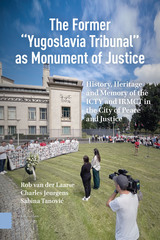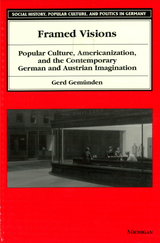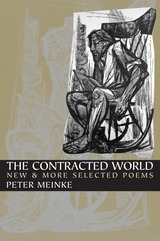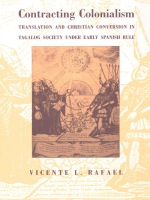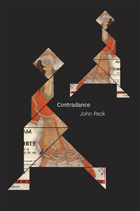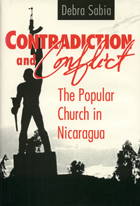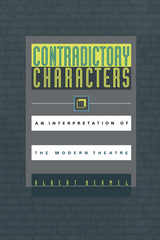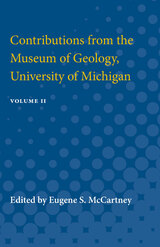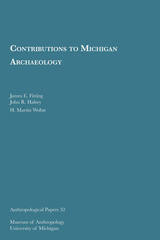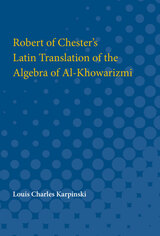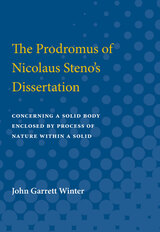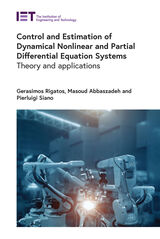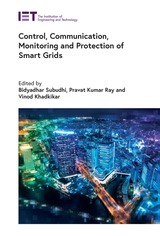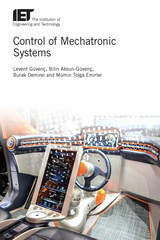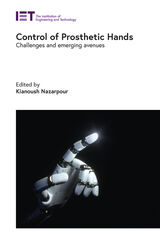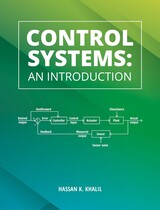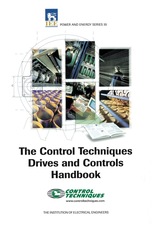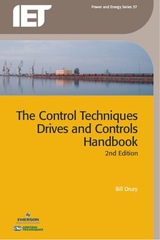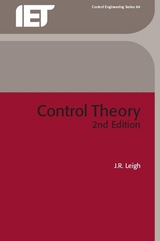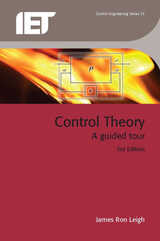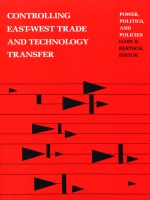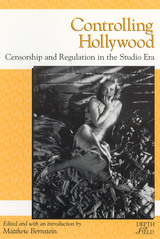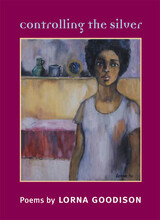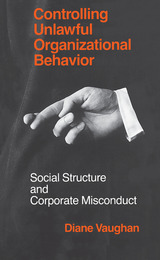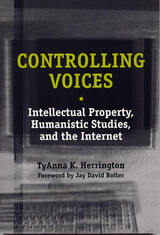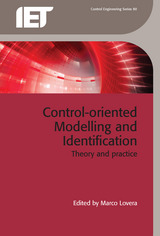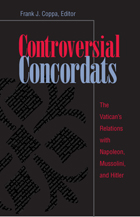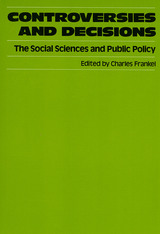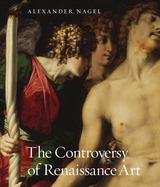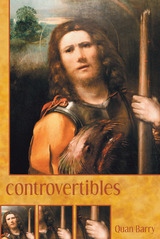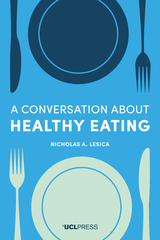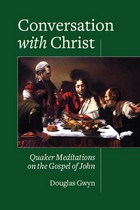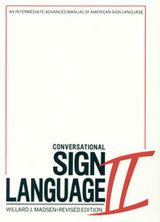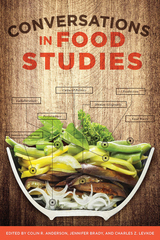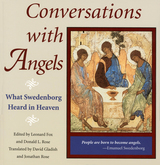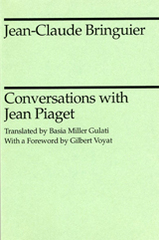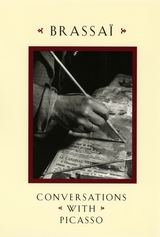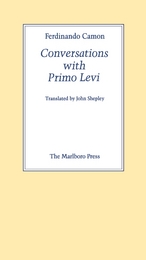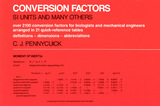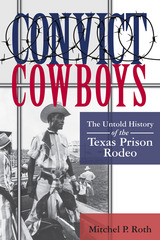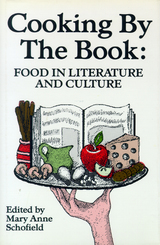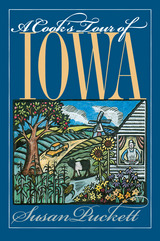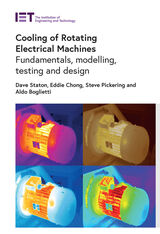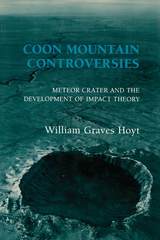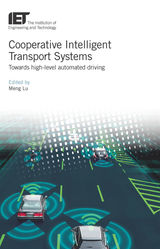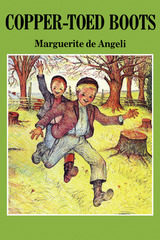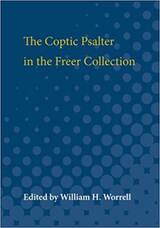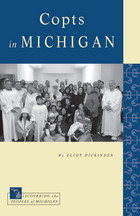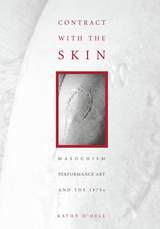 Contract With The Skin: Masochism, Performance Art, and the 1970s
Kathy O'Dell
University of Minnesota Press, 1998 Places masochistic performance within a social and historical context. Having yourself shot. Putting out fires with your bare hands and feet. Biting your own body and photographing the marks. Sewing your own mouth shut. These seemingly aberrant acts were committed by performance artists during the 1970s. Why would anyone do these things? What do these kinds of masochistic performances tell us about the social and historical context in which they occurred? Fascinating and accessibly written, Contract with the Skin addresses such questions through a reconsideration of these acts in relation to psychoanalytic and legal concepts of masochism. O’Dell argues that the growth of masochistic performance during the 1970s must be seen in the context of society’s response to the Vietnam War and contemporaneous changes in theories of contract. She contends that the dynamic that exists between audience and performer during these masochistic acts relates to tensions resulting from ruptures in the social contract. Indeed, as the war in Vietnam waned, so did masochistic performance, only to reemerge in the 1980s in relation to the “war on AIDS” and the censorious “culture wars.”Focusing on 1970s performance artists Vito Acconci, Chris Burden, Gina Pane, and collaborators Marina Abramovi´c/Ulay as well as those with similar sensibilities from the late 1980s onward (Bob Flanagan, David Wojnarowicz, Simon Leung, Catherine Opie, Ron Athey, Lutz Bacher, and Robby Garfinkel), O’Dell provides photographic documentation of performances and quotations from interviews with many of the artists. Throughout, O’Dell asks what we can do about the institutionalized forms of masochism for which these performances are metaphors. Contract with the Skin is a provocative guide to this little-studied area, and offers new ways of thinking about performance art and artistic production.
The Contracted World: New & More Selected Poems
Peter Meinke
University of Pittsburgh Press, 2006
The Contracted World includes representative poems from four of Peter Meinke's previous collections. In poems that show us what it is like to grow up in America, love, nature, cities, sports, war, and peace are filtered through the imagination and verbal skills of one of our brightest poets.
The new poems experiment with form, and address a life that is shrinking in specific ways: the poet is aging, the world is getting smaller, our post-9/11 freedoms are eroding, and our choices seem fewer and less attractive. Despite feelings of anger and loneliness, the narrator speaks to us in a personal, accessible, and often humorous voice.
Contracting Colonialism: Translation and Christian Conversion in Tagalog Society Under Early Spanish Rule
Vicente L. Rafael
Duke University Press, 1993 In an innovative mix of history, anthropology, and post-colonial theory, Vicente L. Rafael examines the role of language in the religious conversion of the Tagalogs to Catholicism and their subsequent colonization during the early period (1580–1705) of Spanish rule in the Philippines. By tracing this history of communication between Spaniards and Tagalogs, Rafael maps the conditions that made possible both the emergence of a colonial regime and resistance to it. Originally published in 1988, this new paperback edition contains an updated preface that places the book in theoretical relation to other recent works in cultural studies and comparative colonialism.
Contradance
John Peck
University of Chicago Press, 2011 In a country where much of the prominent poetry seeks to affirm the fleeting present and its changing values, John Peck’s poetry comes as an important, if unlikely, gift. Peck’s verse deals the cards of the fragmentary, ideogramic, juxtapositional, and elliptical through the deck of normally discursive syntax. Echoing late high Modernism, Peck’s work, in the words of novelist Joseph McElroy, is “a way of seeing things,” confident “in the packed vividness of the referential.” Avoiding the narrow identity- or group-specific viewpoint of some of his contemporaries, Peck invites us to enter the larger humanscape and unearth with him unnoticed connections to our shared past and to one another. In Contradance, his ninth collection, Peck’s passion for inquiry and historical reflection has never been stronger or more beautifully embodied.
Contradiction and Conflict: The Popular Church in Nicaragua
Debra Sabia
University of Alabama Press, 2013 Contradiction and Conflict explores the rich history, ideology, and development of the popular church in Nicaragua. From careful assessments within the context of Nicaragua's revolutionary period (1970s-1990), this book explains the historical conditions that worked to unify members of the Christian faith and the subsequent factors that fragmented the Christian community into at least four identifiable groups with religious and political differences, contradictions, and conflicts. Debra Sabia describes and analyzes the rise, growth, and fragmentation of the popular church and assesses the effect of the Christian base communities on religion, politics, and the nation's social revolutionary experiment.
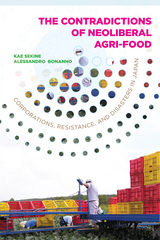 The Contradictions of Neoliberal Agri-Food: Corporations, Resistance, and Disasters in Japan
Kae Sekine
West Virginia University Press, 2016 Employing original fieldwork, historical analysis, and sociological theory, Sekine and Bonanno probe how Japan’s food and agriculture sectors have been shaped by the global push toward privatization and corporate power, known in the social science literature as neoliberalism. They also examine related changes that have occurred after the triple disaster of March 2011 (the earthquake, tsunami, and meltdown of the Fukushima Daiichi nuclear reactor), noting that reconstruction policy has favored deregulation and the reduction of social welfare.
Sekine and Bonanno stress the incompatibility of the requirements of neoliberalism with the structural and cultural conditions of Japanese agri-food. Local farmers’ and fishermen’s emphasis on community collective management of natural resources, they argue, clashes with neoliberalism’s focus on individualism and competitiveness. The authors conclude by pointing out the resulting fundamental contradiction: The lack of recognition of this incompatibility allows the continuous implementation of market solutions to problems that originate in these very market mechanisms.
Contradictory Characters: An Interpretation of the Modern Theatre
Albert Bermel
Northwestern University Press, 1996 Winner of the George Jean Nathan Award for Dramatic Criticism
Playwright and critic Albert Bermel examines thirteen modern plays to assess the underpinnings of dramatic conflict. Contradictory Characters inspects the three well-known types of dramatic conflict-between characters, between character and environment, and within the protagonist himself-and argues that the "character-against-himself" is not only a type of conflict, but is indeed the prototypical conflict underlying the others.
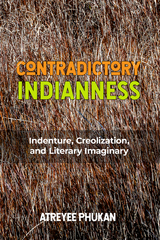 Contradictory Indianness: Indenture, Creolization, and Literary Imaginary
Atreyee Phukan
Rutgers University Press, 2022 As Contradictory Indianness shows, a postcolonial Caribbean aesthetics that has from its inception privileged inclusivity, interraciality, and resistance against Old World colonial orders requires taking into account Indo-Caribbean writers and their reimagining of Indianness in the region. Whereas, for instance, forms of Indo-Caribbean cultural expression in music, cuisine, or religion are more readily accepted as creolizing (thus, Caribbeanizing) processes, an Indo-Caribbean literary imaginary has rarely been studied as such. Discussing the work of Ismith Khan, Harold Sonny Ladoo, Totaram Sanadhya, LalBihari Sharma, and Shani Mootoo, Contradictory Indianness maintains that the writers' engagement with the regional and transnational poetics of the Caribbean underscores symbolic bridges between cultural worlds conventionally set apart—the Africanized and Indianized—and distinguishes between cultural worlds assumed to be the same—indenture and South Asian Indianness. This book privileges Indo-Caribbean fiction as a creolizing literary imaginary to broaden its study beyond a narrow canon that has, inadvertently or not, enabled monolithic and unidimensional perceptions of Indian cultural identity and evolution in the Caribbean, and continued to impose a fragmentary and disconnected study of (post)indenture aesthetics within indenture’s own transnational cartography.
 Contrasting Styles of Industrial Reform: China and India in the 1980s
George Rosen
University of Chicago Press, 1992 Since World War II, China has had a command economy administered under a dictatorship, while India's democracy has introduced a highly regulated economy. Despite obvious differences in their political systems, each country endured remarkably similar economic problems with respect to industry during the 1960s and 1970s. Both embarked in the 1980s on a series of industrial reforms designed to improve technology and efficiency in the use of resources, as well as to stimulate industrial growth in the face of declining productivity.
For economists, the two countries offer an interesting test case for examining similar reform programs launched from disparate political and economic systems. For policymakers concerned with the region's stability, a clear view of the economic futures of these two major powers is paramount.
Examining and comparing the reform experiences of China and India up to the present, George Rosen shows that although China enacted more sweeping reform measures and produced more impressive local growth, it also experienced more significant inflationary spurts. Two-thirds of each nation's population was involved in agriculture at the start of the reform period and nearly that many at the conclusion. Ultimately, the effects of the past industrial reforms in both countries in terms of significantly greater industrial employment or well-being of their populations were limited. An important lesson in these findings, argues Rosen, is that they actually reveal more about the political factors that limit and shape economic policy reforms in a dictatorship or democracy than they confirm the virtues of either capitalism or communism.
Contributions from the Museum of Geology: Containing Papers Published between July 10, 1924, and August 3, 1927
Edited by Eugene S. McCartney
University of Michigan Press, 1928 This volume features a collection of papers originally published between July 10, 1924, and August 3, 1927, and edited by Eugene S. McCartney. Most, but not all, of the contributors were members of the faculties or graduates of the University of Michigan who published on their findings while examining fossils and rock formations. Many of the articles discuss findings from the state of Michigan, including “Occurrence of the Collingwood Formation in Michigan.”
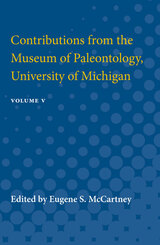 Contributions from the Museum of Paleontology: Containing Papers Published between July 31, 1936, and July 1, 1939
Edited by Eugene S. McCartney
University of Michigan Press, 1939 Containing papers published between July 31, 1936, and July 1, 1939, edited by Eugene S. McCartney and published by the University of Michigan Press in 1939, is a comprehensive compilation of influential paleontological research. Among the notable articles included are E. C. Case's study on a nothosaur from the Triassic of Wyoming, Chester A. Arnold's multi-part observations on fossil plants from the Devonian of Eastern North America, and K. G. Brill's description of Productella waynensis, a new brachiopod from the New Providence Shale of Kentucky. The volume also features detailed examinations such as Chester A. Arnold's work on some fossil species of Mavonia from Oregon, E. C. Case's analysis of a specimen of Stylemys nebrascensis showing the bones of the feet and limbs, and Andrew H. McNair's study on cryptostomatous bryozoa from the Middle Devonian Traverse Group of Michigan. Helen Duncan contributes with her research on trepostomatous bryozoa from the Traverse Group of Michigan, and John A. Wilson describes a new species of dog from the Miocene of Colorado. This collection is an invaluable resource for paleontologists and researchers dedicated to the study of fossil plants and animals, providing detailed descriptions and insights into ancient life forms and their geological contexts.
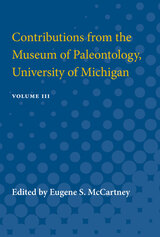 Contributions from the Museum of Paleontology: Containing Papers Published between November 10, 1928, and April 9, 1932
Edited by Eugene S. McCartney
University of Michigan Press, 1932 Containing papers published between November 10, 1928, and April 9, 1932, features significant paleontological research. Edited by Eugene S. McCartney and published by the University of Michigan Press in 1932, this volume includes groundbreaking contributions such as E. C. Case's study on indications of a cotylosaur and a new form of fish from the Triassic beds of Texas, Aldred S. Warthin Jr.'s research on fossil fishes from the Triassic of Texas, and the collaborative work of Laurence M. Gould, Aug. F. Foerste, and Russell C. Hussey on the geology of Foxe Land, Baffin Island. Other notable entries include Russell C. Hussey's examination of cystoids from the Trenton Rocks of Michigan, E. C. Case's detailed description of the skeleton of Ostodolepis brevispinatus, and Aug. F. Foerste's studies on the color patterns of fossil cephalopods and brachiopods, as well as additional notes on nephritic erina. E. C. Case also provides insights into the lower jaw of Brachysuchus megalodon, arthrodiran remains from the Devonian of Michigan, limb movement patterns in phytosaurs, and the description of a new species of Buettneria. Chester A. Arnold discusses Calamites newberryi, while Charles F. Deiss offers a description and stratigraphic correlation of the Fenestellidae from the Devonian of Michigan. This volume is an invaluable resource for paleontologists and researchers interested in furthering their understanding of fossil organisms and geological history.
Contributions to Michigan Archaeology
James E. Fitting, John R. Halsey and H. Martin Wobst
University of Michigan Press, 1968 Three Michigan archaeological sites are covered in this report: the Spring Creek site, in Muskegon County; the Springwells Mound Group, in Wayne County; and the Butterfield site, near Lake Huron in Bay County, Michigan.
Contributions to the History of Science: Part II. Prodromus of Nicolaus Steno's Dissertation Concerning a Solid Enclosed by Process of Nature within a Solid
An English version with an introduction and explanatory notes by John Garrett Winter
University of Michigan Press, 1916 This English translation of The Prodromus of Nicholaus Steno’s Dissertation is unique in that it includes an introduction and explanatory notes by John Garrett Winter and a foreword by William H. Hobbs. The introduction presents information on Steno’s life and writings, as well as a bibliography of the Prodromus. In his foreword, Hobbs advises readers to “remember that the essay was written near the middle of the seventeenth century, when scientific observation was hardly thought of.” Steno’s description of scientific observation is pioneering for his time and should appeal to those interested in the natural sciences. This volume is a publication of the University of Michigan Humanistic Series.
Contrived Competition: Regulation and Deregulation in America
Richard H. K. Vietor
Harvard University Press, 1994 This book explains how four major firms—American Airlines, El Paso Natural Gas, AT&T, and Bank America—and their respective managements were challenged by the deregulation of markets starting in the late 1970s. The four stories illustrate the dynamic process of market restructuring and organizational adjustment, as well as the ways in which managers and regulators painfully learned to operate effectively as their economic and political environments shifted around them.
 Control and Crisis in Colonial Kenya: The Dialectic of Domination
Bruce Berman
Ohio University Press, 1990 This history of the political economy of Kenya is the first full length study of the development of the colonial state in Africa. Professor Berman argues that the colonial state was shaped by the contradictions between maintaining effective political control with limited coercive force and ensuring the profitable articulation of metropolitan and settler capitalism with African societies. This dialectic of domination resulted in both the uneven transformation of indigenous societies and in the reconstruction of administrative control in the inter-war period. The study traces the evolution of the colonial state from its skeletal beginnings in the 1890s to the complex bureaucracy of the post-1945 era which managed the growing integration of the colony with international capital. These contradictions led to the political crisis of the Mau Mau emergency in 1952 and to the undermining of the colonial state. The book is based on extensive primary sources including numerous interviews with Kenyan and British participants. The analysis moves from the micro-level of the relationship of the District Commissioners and the African population to the macro-level of the state and the political economy of colonialism. Professor Berman uses the case of Kenya to make a sophisticated contribution to the theory of the state and to the understanding of the dynamics of the development of modern African political and economic institutions.
 Control and Order in French Colonial Louisbourg, 1713-1758
A.J.B. Johnston
Michigan State University Press, 2001 Control and Order in French Colonial Louisbourg, 1713-1758 is the culmination of nearly a quarter century of research and writing on 18th-century Louisbourg by A. J. B. Johnston. The author uses a multitude of primary archival sources-official correspondence, court records, parish registries, military records, and hundreds of maps and plans-to put together a detailed analysis of a distinctive colonial society. Located on Cape Breton Island (then known as Île Royale), the seaport and stronghold of Louisbourg emerged as one of the most populous and important settlements in all of New France. Its economy was based on fishing and trade, and the society that developed there had little or nothing to do with the fur trade, or the seigneurial regime that characterized the Canadian interior. Johnston traces the evolution of a broad range of controlling measures that were introduced and adapted to achieve an ordered civil and military society at Louisbourg. Town planning, public celebrations, diversity in the population, use of punishments, excessive alcohol consumption, the criminal justice system, and sexual abuse are some of the windows that reveal attempts to control and regulate society. A. J. B. Johnston's Control and Order in French Colonial Louisbourg offers both a broad overview of the colony's evolution across its half-century of existence, and insightful analyses of the ways in which control was integrated into the mechanisms of everyday life.
 Control and Subversion: Gender Relations in Tajikistan
Colette Harris
Pluto Press, 2004 Control and Subversion makes an important contribution to the study of Muslim societies in general, while also being a unique study of a neglected area – post-Soviet Tajikistan – a country gaining increasing importance in the international arena of Central Asia. The book presents an intimate view of this society, told through ethnographically collected life histories, unusually including men’s as well as women’s. Despite developing significant gender theories (notably reframing work of Judith Butler), and maintaining high academic standards, it remains as readable as a popular novel.
Control and Subversion investigates the relationship of gender to the inner workings of social control, such as exposing ways in which Tajik society threatens men’s masculinity, thereby bringing them to force family members into conformity, irrespective of the suffering this may cause. It examines how masculine and feminine gender characteristics influence personal relationships and explores gender relations at their most intimate – from the secret musings of adolescent girls, through the painful experiences of young men, to the trauma of sexual initiation. Although largely concentrating on contemporary life, the book also discusses historical materials and Soviet influence on Tajik society. Control and Subversion is essential reading for anyone interested in Central Asia, Muslim societies, the lives of Muslim women, or gender in a Muslim context.
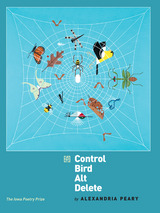 Control Bird Alt Delete
Alexandria Peary
University of Iowa Press, 2014 “‘Go play!’ advises Peary in her third collection, and we do, with ‘a tassel of rain,’ with ‘dove-colored sounds’ and ‘starter castles.’ The topos is New England archaeology; it’s Colorforms and Legos; Charley Harper landscapes become interiors; we are delighted to already find ourselves where we couldn’t possibly get to.”—Caroline Knox, author, Flemish: Poems
In Control Bird Alt Delete, the reader is invited to explore strange landscapes: some based on the ruins of New England and others following the architectural prints of the unconscious. The reader walks through woods filled with cellar holes, rock walls, and lilac bushes, and is made to think of people gone missing. Robert Frost meets Times Square. Nature intrudes in unexpected ways on domestic settings—and vice versa—domestic and industrial settings appear in bits inside the pastoral. Birds, one-dimensional but strangely wise, flit back and forth and rebelliously tape up their songs. The senses are thoroughly blended, leading to strange combinations and sensory experiences, to states of mindfulness and blizzard distraction.
All the while, the unconscious threatens to intrude, with its underlined places, its trap doors inside ordinary conversations, the mazes it hangs up like “welcome home” banners next to people’s mouths while they speak. The reader follows the first-person I through mazes, office spaces, and coils of highway traffic, hoping for some redemption, some sort of answer to all the deletion.
Control Circuits in Power Electronics: Practical issues in design and implementation
Miguel Castilla
The Institution of Engineering and Technology, 2016 Control circuits are a key element in the operation and performance of power electronics converters. This book describes practical issues related to the design and implementation of these control circuits, with a focus on the presentation of the state-of-the-art control solutions, including circuit technology, design techniques, and implementation issues.
Control, Communication, Monitoring and Protection of Smart Grids
Bidyadhar Subudhi
The Institution of Engineering and Technology, 2024 Smart grids enable efficient integration of rising shares of distributed and intermittent renewable power generation at various scales, and variable loads, for example from electric vehicles. This requires sophisticated communication and computation, as well as monitoring and protection from both malfunctions and malicious interference.
Control Engineering Solutions: A practical approach
P. Albertos
The Institution of Engineering and Technology, 1997 This book collects together in one volume a number of control engineering solutions, intended to be representative of solutions applicable to a broad class of control problems, and outlines possible alternative approaches to finding them. This is neither a control theory book nor a handbook of laboratory experiments, although it includes both the basic theory of control and practical laboratory set-ups to illustrate the solutions proposed.
Control of Mechatronic Systems
Levent Güvenç
The Institution of Engineering and Technology, 2017 This book introduces researchers and advanced students with a basic control systems background to an array of control techniques which they can easily implement and use to meet the required performance specifications for their mechatronic applications. It is the result of close to two decades of work of the authors on modeling, simulating and controlling different mechatronic systems from the motion control, automotive control and micro and nano-mechanical systems control areas. The methods presented in the book have all been tested by the authors and a very large group of researchers, who have produced practically implementable controllers with highly successful results.
Control of Permanent Magnet Actuators for Robotics Applications
Chao Gong
The Institution of Engineering and Technology, 2025 Motivated by the expanding role of robotics in a wide range of industrial applications, the imperative for a specialized exploration into the control dynamics of permanent magnet actuators has become apparent. These actuators are integral to contemporary robotic systems but they pose distinct challenges necessitating a dedicated exploration. The subject area encompasses a comprehensive examination of control requirements, spanning from conventional high-performance strategies to avant-garde non-position control approaches, multi-motor coordination, and fault-tolerant methodologies.
Control of Prosthetic Hands: Challenges and emerging avenues
Kianoush Nazarpour
The Institution of Engineering and Technology, 2021 This edited book brings together research from laboratories across the world, in order to offer a global perspective on advances in prosthetic hand control. State-of-the-art control of prosthetics in the laboratory and clinical spaces are presented and the challenges discussed, and the effect of user training on control of prosthetics to evaluate the translational efficacy and value for the end-user is highlighted.
The Control of Resources
Partha Dasgupta
Harvard University Press, 1982 Most books in environmental economics either employ complex mathematical models or resort to a recital of case studies. What makes this new book by a leading expert in resource economics so useful is the careful blend of theory and practice. Terms and techniques are explained fully, and only a modest technical background in economics and mathematics is assumed. Partha Dasgupta examines the problems of resource management and pollution control within a common framework and relates them to issues in development planning. He also draws extensively on environmental literature to which students and policymakers seldom have access. Special attention is given to critical issues in environmental decisionmaking, such as externalities, pricing, cost-benefit analysis, uncertainty, and optimization. The author also uses real-world examples to illustrate difficult concepts.
 Control of the Imaginary: Reason and Imagination in Modern Times
Luiz Costa LimaTranslated by Ronald W. SousaIntroduction by Ronald W. SousaAfterword by Jochen Schulte-Sasse
University of Minnesota Press, 1989 Control of the Imaginary was first published in 1989. Minnesota Archive Editions uses digital technology to make long-unavailable books once again accessible, and are published unaltered from the original University of Minnesota Press editions. In Control of the Imaginary Luiz Costa Lima explains how the distinction between truth and fiction emerged at the beginning of modern times and why, upon its emergence, fiction fell under suspicion. Costa Lima not only describes the continuous relationship between Western notions of reason and subjectivity over a broad time-frame—the Renaissance to the first decade of the twentieth century—but he uses this occasion to reexamine the literary traditions of France, Italy, Spain, Portugal, England, and Germany. The book reconstructs the dominant frames in the European tradition between the Middle Ages and the nineteenth century from the perspective of a Latin American who sees the culture of his native Brazil haunted by unresolved questions from the Northern Hemisphere. Costa Lima manages to synthesize positions from philosophy, anthropology, sociology, psychology, linguistics, and history without separating the theoretical discussion from his historical reconstructions. The first chapter situates the problem and grounds the emergent distinction between truth and fiction in a very close analysis of one of the first European historians, Fernao Lopes, who sets the tone for the condemnation of fiction in the name of the truth of history and the potential for individual interpretation. Costa Lima pursues these notions through the aesthetic debates of the seventeenth and eighteenth centuries to the writings of the French historian Michelet. He also devotes an illuminating chapter to the invention of the strictures imposed on fiction.
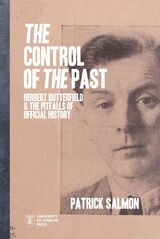 The Control of the Past: Herbert Butterfield and the Pitfalls of Official History
Patrick Salmon
University of London Press, 2021 A reflection on nation-building, identity, and the stories governments tell us about ourselves.
In 1949, English historian Herbert Butterfield published “Official History: Its Pitfalls and Its Criteria,” a now-famous diatribe against the practice of publishing official history. Butterfield was one of the earliest and strongest critics of what he saw as the British government’s attempts to control the past through the writing of history. But why was Butterfield so hostile to state-sanctioned history, and why do his views still matter today?
This important new book details how successive governments have applied a selective approach to the past in order to tell or retell Britain’s national history. Providing a unique overview of the main trends of official history in Britain since World War II, the book details how Butterfield came to suspect that the British government was trying to suppress vital documents revealing the Duke of Windsor’s dealings with Nazi Germany. This seemed to confirm his long-held belief that all governments would seek to manipulate history if they could and conceal the truth if they could not.
At the beginning of the twenty-first century, official history is still being written. The Control of the Past concludes with an insider’s perspective on the many issues it faces today—on freedom of information, social media, and reengaging with our nation’s colonial legacy. Governments have recently been given many reminders that history matters, and Butterfield’s work reminds us that we must remain vigilant in monitoring how they respond to the challenge.
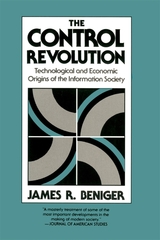 The Control Revolution: Technological and Economic Origins of the Information Society
James Beniger
Harvard University Press, 1986 Why do we find ourselves living in an Information Society? How did the collection, processing, and communication of information come to play an increasingly important role in advanced industrial countries relative to the roles of matter and energy? And why is this change recent—or is it?
James Beniger traces the origin of the Information Society to major economic and business crises of the past century. In the United States, applications of steam power in the early 1800s brought a dramatic rise in the speed, volume, and complexity of industrial processes, making them difficult to control. Scores of problems arose: fatal train wrecks, misplacement of freight cars for months at a time, loss of shipments, inability to maintain high rates of inventory turnover. Inevitably the Industrial Revolution, with its ballooning use of energy to drive material processes, required a corresponding growth in the exploitation of information: the Control Revolution.
Between the 1840s and the 1920s came most of the important information-processing and communication technologies still in use today: telegraphy, modern bureaucracy, rotary power printing, the postage stamp, paper money, typewriter, telephone, punch-card processing, motion pictures, radio, and television. Beniger shows that more recent developments in microprocessors, computers, and telecommunications are only a smooth continuation of this Control Revolution. Along the way he touches on many fascinating topics: why breakfast was invented, how trademarks came to be worth more than the companies that own them, why some employees wear uniforms, and whether time zones will always be necessary.
The book is impressive not only for the breadth of its scholarship but also for the subtlety and force of its argument. It will be welcomed by sociologists, economists, historians of science and technology, and all curious in general.
Control Systems: An Introduction
Hassan K. Khalil
Michigan Publishing, 2023 The textbook Control Systems: An Introduction by Professor Hassan Khalil of Michigan State University is intended to serve the standard course on control systems commonly required by undergraduate degrees in electrical and computer engineering. The book introduces the mathematical tools used to characterize the operation of a wide range of control systems, from those used to control a car to travel at a specified speed to a more elaborate systems used to control the flight of a rocket.
Control Techniques Drives and Controls Handbook
Bill Drury
The Institution of Engineering and Technology, 2001 This book contains a great deal of practical information for drives and industrial engineers who use motors and drives. It is a comprehensive guide to the technology underlying drives and motors. It contains sufficient theory to give both user and student an insight into the design of these components and thereby the constraints and opportunities that exist.
The Control Techniques Drives and Controls Handbook
Bill Drury
The Institution of Engineering and Technology, 2009 Variable speed drives and the associated electrical motors play a central role in industry as well as the buildings in which we live, work and are entertained. They are arguably the most potent tool we have in the quest to save energy and thereby reduce our carbon footprint. Their rate of development has been rapid and today's product is in many ways unrecognisable from its ancestors of even twenty years ago. Development continues apace for the components used in the products, the products themselves and the ways in which the products are used.
Control Theory
J.R. Leigh
The Institution of Engineering and Technology, 2004 Concise highly readable book emphasising the concepts and principles that are prerequisite for understanding both traditional and recent control theory.
Control Theory: A guided tour
James Ron Leigh
The Institution of Engineering and Technology, 2012 Using clear tutorial examples, this fully updated new edition concentrates on explaining and illustrating the concepts that are at the heart of control theory.
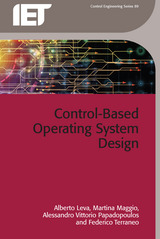 Control-Based Operating System Design
Alberto Leva
The Institution of Engineering and Technology, 2013 Control-Based Operating System Design describes the application of system- and control-theoretical methods to the design of computer operating system components. It argues that computer operating system components should not be first 'designed' and then 'endowed with control', but rather when possible conceived from the outset as controllers, synthesised and assessed in the system-theoretical world of dynamic models, and then realised as control algorithms. Doing so is certainly a significant perspective shift with respect to current practices in operating system design, but the payoff is significant too. In some sense, adopting the suggested attitude means viewing computing systems as cyber-physical ones, where the operating system plays the computational role, the physical elements are the managed resources, and the various (control) functionalities to be realised, interact and co-operate as a network.
Controlling Anger: The Anthropology of Gisu Violence
Suzette Heald
Ohio University Press, 1997 Controlling Anger examines the dilemmas facing rural people who live within the broader context of political instability. Following Uganda’s independence from Britain in 1962, the Bagisu men of Southeastern Uganda developed a reputation for extreme violence. Drawing on a wide range of historical sources including local court records, statistical survey analysis, and intensive fieldwork, Suzette Heald portrays and analyzes the civil violence that grew out of intense land shortage, the marginalization of the Gisu under British rule, and the construction of male gender identity among the Gisu. Now available in a paperback edition with a new preface by the author, Controlling Anger is an important contribution to rural sociology in Africa.
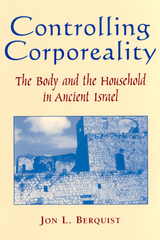 Controlling Corporeality: The Body and the Household in Ancient Israel
Berquist, Jon L.
Rutgers University Press, 2002 Human bodily existence is at the core of the Torah and the rest of the Hebrew Scriptures—from birth to death. From God’s creation of Adam out of clay, to the narratives of priests and kings whose regulations governed bodily practices, the Hebrew Bible focuses on the human body. Moreover, ancient Israel’s understanding of the human body has greatly influenced both Judaism and Christianity. Despite this pervasive influence, ancient Israel’s view of the human body has rarely been studied and, until now, has been poorly understood.
In this beautifully written book, Jon L. Berquist guides the reader through the Hebrew Bible, examining ancient Israel’s ideas of the body, the unstable roles of gender, the deployment of sexuality, and the cultural practices of the time. Conducting his analysis with reference to contemporary theories of the body, power, and social control, Berquist offers not only a description and clarification of ancient Israelite views of the body, but also an analysis of how these views belong to the complex logic of ancient social meanings. When this logic is understood, the familiar Bible becomes strange and opens itself to a wide range of new interpretations.
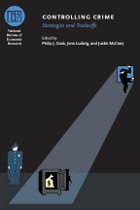 Controlling Crime: Strategies and Tradeoffs
Edited by Philip J. Cook, Jens Ludwig, and Justin McCrary
University of Chicago Press, 2011 Criminal justice expenditures have more than doubled since the 1980s, dramatically increasing costs to the public. With state and local revenue shortfalls resulting from the recent recession, the question of whether crime control can be accomplished either with fewer resources or by investing those resources in areas other than the criminal justice system is all the more relevant. Controlling Crime considers alternative ways to reduce crime that do not sacrifice public safety. Among the topics considered here are criminal justice system reform, social policy, and government policies affecting alcohol abuse, drugs, and private crime prevention. Particular attention is paid to the respective roles of both the private sector and government agencies. Through a broad conceptual framework and a careful review of the relevant literature, this volume provides insight into the important trends and patterns of some of the interventions that may be effective in reducing crime.
Controlling East-West Trade and Technology Transfer: Power, Politics, and Policies
Gary K. Bertsch, ed.
Duke University Press, 1988 Western efforts to control trade and technological relations with communist countries affect many interests and political groups in both Eastern and Western blocs. Although there is general agreement within the Western alliance that government-imposed controls are necessary to prevent material having military importance from falling in the hands of the Soviet Union and its Warsaw Pact allies, there is considerable controversy over the specifics: the exact definition of "militarily significant" material, how the Western nations should administer controls, the implications of glasnost, and other matters.
Controlling Hollywood: Censorship and Regulation in the Studio Era
Bernstein, Matthew
Rutgers University Press, 1999 For every movie shown on the big screen, there exists a behind-the-scene story of regulation and control. What social factors determine which movies get made and shown? What is censored? And how have the standards of what is considered taboo changed over time? Controlling Hollywood features ten innovative and accessible essays that examine some of the major turning points, crises, and contradictions affecting the making and showing of Hollywood movies from the 1910s through the early 1970s. The articles included here examine landmark legal cases; various self-regulating agencies and systems in the film industry (from the National Board of Review to the ratings system); and, external to Hollywood, the religious and social interest groups and government bodies that took a strong interest in film entertainment over the decades.
 Controlling Our Destinies: Human Genome Projectýreilly Center For Science Vol V
Phillip R. Sloan
University of Notre Dame Press, 2000 "Controlling Our Destinies contains the most penetrating set of available essays that explore the cultural dimensions of the Human Genome Project. It will become essential reading for those who want to assess the value and significance of the HGP. It's accessibility makes it a perfect supplement for any biology program that wants to explore what humanists can tell us about the HGP." --Paul Lawrence Farber, Oregon State University Distinguished Professor of History of Science
"An excellent collection of papers from a truly inter-disciplinary conference focusing on the humanistic implications of the Human Genome Project. Masterminded and edited by the well known philosopher and historian of biology, Professor Phillip Sloan, the volume juxtaposes differing views on the many controversial issues raised by the sequencing of our genetic blueprint. This collection is an achievement in the spirit of the ELSIE initiative, and does credit to it." --Robert Olby, Research Professor, Department of History Philosophy of Science, University of Pittsburgh.
Controlling Our Destinies presents the reflections of an international group of scholars from several humanistic disciplines on the historical origins, the philosophical content, the ethical issues, and the science-religion questions raised by the HGP. Contributors include John Beatty, Robert Bud, Arthur Caplan, Alice Domurat Dreger, Kevin Fitzgerald, Jean-Paul Gaudillière, Jean Gayon, Marguerite Hays, Lily Kay, Evelyn Fox Keller, Philip Kitcher, Timothy Lenoir, Richard McCormick, Ernan McMullin, Edward Manier, Timothy Murphy, John Opitz, Diane Paul, Arthur Peacocke, Martin Pernick, Hans Jörg Rheinberger, Kenneth Schaffner, Phillip R. Sloan, and John Staudenmaier.
The Human Genome Project, an international scientific enterprise aimed at attaining a complete sequence and locator map of the entire human genetic structure by the year 2005, constitutes the largest single project ever undertaken in the life sciences. When completed, it will help pinpoint the genetic basis of virtually any human trait. It will also offer the possibility for medical interventions for many diseases and abnormalities related to genetic processes. In this timely collection, scholars from the fields of philosophy, history, ethics, theology, and the natural sciences explore the complex, far-reaching issues surrounding the Human Genome Project.
Contributors discuss the historical background of the project, the issues behind the concepts of "code" and "genes," the implicit reductionism in contemporary human genetics, the nagging issues surrounding potential new forms of positive "eugenics," and the challenge the project presents for theological perspectives on human life.
Because of its interdisciplinary approach and its efforts to engage the scientific community in an informed discussion with humanistic scholars, Controlling Our Destinies stands alone among the literature on the Human Genome Project. In addition to its contribution to scholarly inquiry, it will be useful for classroom discussions and is certain to stimulate further analyses by both humanists and scientists of the wider issues surrounding the Human Genome Project as it develops into the next century.
Phillip R. Sloan is Professor in the Program of Liberal Studies and the Program in History and Philosophy of Science, as well as past Director of the Notre Dame Program in History and Philosophy of Science, at the University of Notre Dame.The Human Genome Project is an international scientific enterprise aimed at attaining a complete sequence and locator map of the entire human genetic structure by the year 2005, constituting the largest single project ever undertaken in the life sciences. The goal is to pinpoint causes of virtually any human genetic trait and eventually create cures for many diseases and abnormalities related to genetic processes. International cholars in this field explore the complex, far-reaching issues surrounding the HGP.
----------
"Controlling Our Destinies is an interdisciplinary assemblage of humanistic scholars that will prove an invaluable, benchmark publication for both humanists and scientists for discussions of the ethical, and moral considerations attendant to such radical advance in human control over human biology." --Bookwatch
"Anyone who is interested in human genetic research will find that this book offers a relevant and interesting analysis of the full range of ethical, philosophical and theological implications of such work.... [T]he contents of this book are of great importance...." --Addiction Biology
"A fruitful text, the reader is bound to find several essays that meet his or her needs and interests." -- Metapsychology: Mental Health Net
"Sloan is absolutely correct in helping his readers see implications well beyond the ethics of medical genetics.… These scientific, historical and philosophical contributions make this volume an invaluable and unique contribution to the growing literature that is exploring the moral and ethical implications of the Human Genome Project...." --National Catholic Bioethics Center
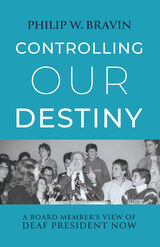 Controlling Our Destiny: A Board Member’s View of Deaf President Now
Philip W. Bravin
Gallaudet University Press, 2020 In March 1988, students at Gallaudet University led a successful protest to demand the selection of the university’s first deaf president. The Deaf President Now (DPN) movement was a watershed event in American deaf history; it achieved self-governance for the deaf community and placed Gallaudet in the center of a national media spotlight. Controlling Our Destiny is Philip Bravin’s personal perspective of these momentous events. A lifelong member of the deaf community and proud Gallaudet alumnus, Bravin was a member of the Gallaudet University Board of Trustees and the chair of the presidential search committee during DPN. Although the deaf community had been strongly advocating for a deaf president to lead the university, the board (which had a hearing majority) selected the lone hearing candidate.
Bravin recounts the discussions and decision-making that happened behind the scenes leading up to and following the ill-fated announcement. He reflects on the integrity of the process and the internal conflict he experienced as a deaf person who supported a deaf president yet felt compelled to abide by his duties as a board member. After the protests, his leadership was recognized when he was selected as the first deaf chair of the board. Photographs and documents add depth to Bravin’s account, many of which will be seen by the public for the first time. I. King Jordan, the first deaf president of Gallaudet, provides a foreword in which he shares his own unique insight into these events.
Controlling Our Destiny captures the energy and the urgency of DPN. Readers will understand the complexities of the presidential search process and the cultural and historical contexts that triggered the protest. Bravin’s memoir contemplates power, access, community, and the enduring legacy of a movement that inspired deaf people around the world.
 Controlling Technocracy: Citizen Rationality and the NIMBY Syndrome
Gregory E. McAvoy
Georgetown University Press, 1999 Disputes over hazardous waste sites usually are resolved by giving greater weight to expert opinion over public "not-in-my-back-yard" reactions. Challenging the assumption that policy experts are better able to discern the general welfare, Gregory E. McAvoy here proposes that citizen opinion and democratic dissent occupy a vital, constructive place in environmental policymaking. McAvoy explores the issues of citizen rationality, the tension between democracy and technocracy, and the link between public opinion and policy in the case of an unsuccessful attempt to site a hazardous waste facility in Minnesota. He shows how the site was defeated by citizens who had reasonable doubts over the need for the facility. Offering a comprehensive look at the policymaking process, McAvoy examines the motivations of public officials, the resources they have for shaping opinion, the influence of interest groups, and the evolution of waste reduction programs in Minnesota and other states. Integrating archival material, interviews, and quantitative survey data, he argues that NIMBY movements can bring miscalculations to light and provide an essential check on policy experts' often partisan views. This book will be of value to those who work or study in the fields of hazardous waste policy, facility siting, environmental policy, public policy, public administration, and political science.
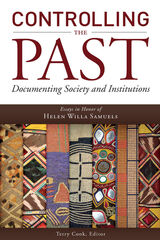 Controlling the Past
Terry Cook
Society of American Archivists, 2011 In this compelling and wide-ranging volume, twenty leading archivists honor Helen Willa Samuels, retired institute archivist of the Massachusetts Institute of Technology, by exploring the theme of documenting modern society and its institutions, and carefully considering the implications arising from the archivist's control over social memory.
Editor Terry Cook's introductory essay places the significance of Samuels' ideas in the context of modern archival practice and traces her influence on North American archival thinking. Divided in two sections, the first nine essays explore the rich contexts in which the appraisal of potential archival sources takes place and focus on understanding and managing all documentation to select the small percentage that will survive in archives. Several chapters trace how the profession is being radically transformed in the digital age with topics such as making a case for electronic records management, documenting appraisal as a societal-archival process, and challenging stereotypes about corporate archives.
The second section looks at both the documentation and who is doing the documenting. Seven essays explore the nature, influences, and ethics of archivists and their roles in appraising records, documenting society and its institutions, and describing records with digital tools. A pair of retrospective reflections round out the volume, including one from Samuels, who reflects on the origins of her work on appraisal.
Just as archivists shape what society can know about itself through documentation, so, too, this book is bound to shape contemporary archival perspectives about the challenges and responsibilities of "controlling the past."
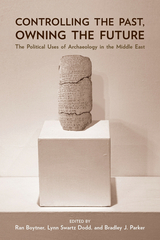 Controlling the Past, Owning the Future: The Political Uses of Archaeology in the Middle East
Edited by Ran Boytner, Lynn Swartz Dodd, and Bradley J. Parker
University of Arizona Press, 2010 What are the political uses—and misuses—of archaeology in the Middle East? In answering this question, the contributors to this volume lend their regional expertise to a variety of case studies, including the Taliban’s destruction of Buddhas in Afghanistan, the commercialization of archaeology in Israel, the training of Egyptian archaeology inspectors, and the debate over Turkish identity sparked by the film Troy, among other provocative subjects. Other chapters question the ethical justifications of archaeology in places that have “alternative engagements with the material past.” In the process, they form various views of the role of the archaeologist, from steward of the historical record to agent of social change.
The diverse contributions to this volume share a common framework in which the political use of the past is viewed as a process of social discourse. According to this model, political appropriations are seen as acts of social communication designed to accrue benefits to particular groups. Thus the contributors pay special attention to competing social visions and the filters these impose on archaeological data. But they are also attentive to the potential consequences of their own work. Indeed, as the editors remind us, “people’s lives may be affected, sometimes dramatically, because of the material remains that surround them.”
Rounding out this important volume are critiques by two top scholars who summarize and synthesize the preceding chapters.
Controlling the Silver
Lorna Goodison
University of Illinois Press, 2004 Renowned poet Lorna Goodison has written a new collection of elegies and praise songs which explore the close link between history and genealogy in the Caribbean experience. Her subjects range from the economic genius of market women to the complex beauty of the natural world.
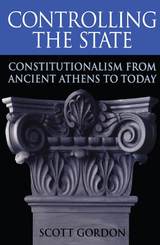 Controlling the State: Constitutionalism from Ancient Athens to Today
Scott Gordon
Harvard University Press, 1999 This book examines the development of the theory and practice of constitutionalism, defined as a political system in which the coercive power of the state is controlled through a pluralistic distribution of political power. It explores the main venues of constitutional practice in ancient Athens, Republican Rome, Renaissance Venice, the Dutch Republic, seventeenth-century England, and eighteenth-century America.
From its beginning in Polybius' interpretation of the classical concept of "mixed government," the author traces the theory of constitutionalism through its late medieval appearance in the Conciliar Movement of church reform and in the Huguenot defense of minority rights. After noting its suppression with the emergence of the nation-state and the Bodinian doctrine of "sovereignty," the author describes how constitutionalism was revived in the English conflict between king and Parliament in the early Stuart era, and how it has developed since then into the modern concept of constitutional democracy.
 Controlling the Sword: The Democratic Governance of National Security
Bruce Russett
Harvard University Press One of our nation's leading interpreters of national security policymaking shows how public opinion, operating in democratic political systems, shapes and constrains decisions about national security. Bruce Russett maintains that elected leaders, and their supporters and rivals, must realize that foreign policy and security policy are largely determined by domestic politics; the political leader who ignores domestic politics finds it difficult to get things done internationally, risks repudiation at the polls, and fails to exploit real or symbolic successes abroad that could reinforce his standing at home.
Russett also debunks several Washington myths: that the public is too confused and ignorant about security issues to deserve influence over national security policy; that the public is easily manipulated; that public opinion is hopelessly volatile, swinging irrationally between indifference and hysteria, hawk and dove. He shows how electoral politics encourages tough talk and tough action; how policymaking and public opinion interact; how the public balances extremes of warmongering and appeasement; and how democratic political systems are prepared to compromise their differences with other democratic countries, to avoid making hard enemies of them.
Timely, insightful, almost an advanced primer for understanding national policymaking in our most challenging and frightening sphere, this book will be of interest to policymakers, journalists, legislators, and concerned readers in general.
Controlling Unlawful Organizational Behavior: Social Structure and Corporate Misconduct
Diane Vaughan
University of Chicago Press, 1985 Diane Vaughan reconstructs the Ohio Revco case, an example of Medicaid provider fraud in which a large drugstore chain initiated a computer-generated double billing scheme that cost the state and federal government half a million dollars in Medicaid funds, funds that the company believed were rightfully theirs. Her analysis of this incident—why the crime was committed, how it was detected, and how the case was built—provides a fascinating inside look at computer crime. Vaughan concludes that organizational misconduct could be decreased by less regulation and more sensitive bureaucratic response.
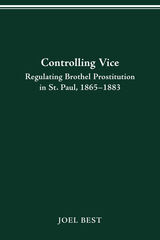 CONTROLLING VICE: REGULATING BROTHEL PROSTITUTION IN ST. PAUL, 1865–1883
JOEL BEST
Ohio State University Press, 1998 For eighteen years following the Civil War, the police in St. Paul, Minnesota, informally regulated brothel prostitution. Each month, the madams who ran the brothels were charged with keeping houses of ill fame and fined in the city’s municipal court. In effect, they were paying licensing fees in order to operate illegal enterprises. This arrangement was open; during this period, the city’s newspapers published hundreds of articles about vice and its regulation. Joel Best claims that the sort of informal regulation in St. Paul was common in the late nineteenth century and was far more typical than the better known but brief experiment with legalization tried in St. Louis. With few exceptions, the usual approach to these issues of social control has been to treat informal regulation as a form of corruption, but Best’s view is that St. Paul’s arrangement exposes the assumption that the criminal justice system must seek to eradicate crime. He maintains that other policies are possible. In a book that integrates history and sociology, the author has reconstructed the municipal court records for most of 1865–83, using newspaper articles, an arrest ledger kept by the St. Paul police, and municipal court dockets. He has been able to trace which madams operated brothels and the identities of many of the prostitutes who lived and worked in them.
Controlling Voices: Intellectual Property, Humanistic Studies, and the Internet
TyAnna K. Herrington. Foreword by Jay David Bolter
Southern Illinois University Press, 2001 TyAnna K. Herrington explains current intellectual property law and examines the effect of the Internet and ideological power on its interpretation. Promoting a balanced development of our national culture, she advocates educators’ informed participation in ensuring egalitarian public access to information. She discusses the control of information and the creation of knowledge in terms of the way control functions under current property law.
Control-oriented Modelling and Identification: Theory and practice
Marco Lovera
The Institution of Engineering and Technology, 2015 This comprehensive book covers the state-of-the-art in control-oriented modelling and identification techniques. With contributions from leading researchers in the subject, Control-oriented Modelling and Identification: Theory and practice covers the main methods and tools available to develop advanced mathematical models suitable for control system design, including: object-oriented modelling and simulation; projection-based model reduction techniques; integrated modelling and parameter estimation; identification for robust control of complex systems; subspace-based multi-step predictors for predictive control; closed-loop subspace predictive control; structured nonlinear system identification; and linear fractional LPV model identification from local experiments using an H1-based glocal approach.
Controversies and Decisions: The Social Sciences and Public Policy
Charles Frankel
Russell Sage Foundation, 1976 Explores the various aspects of recent debates over the independence of the social sciences. The contributors are Kenneth E. Boulding, Harvey Brooks, Jonathan R. Cole, Stephen Cole, Lee J. Cronbach, Paul Doty, Yaron Ezrahi, Charles Frankel, H. Field Haviland, Hugh Hawkins, Harry G. Johnson, Robert Nisbet, Nicholas Rescher, Edward Shils, and Adam Yarmolinksy. The essays deal with such topics as the relation of "values" to "facts" in social science inquiry; the interplay of theoretical and practical considerations; the moral obligations of social science investigators in political contexts; and the ways and means of protecting and advancing the autonomy of the social sciences.
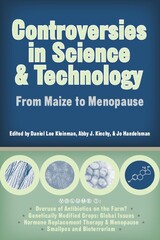 Controversies in Science and Technology: From Maize to Menopause
Edited by Daniel Lee Kleinman, Abby J. Kinchy, and Jo Handelsman
University of Wisconsin Press, 2005 Written for general readers, teachers, journalists, and policymakers, this volume explores four controversial topics in science and technology, with commentaries from experts in such fields as sociology, religion, law, ethics, and politics:
* Antibiotics and Resistance: the science, the policy debates, and perspectives from a microbiologist, a veterinarian, and an M.D.
* Genetically Modified Maize and Gene Flow: the science of genetic modification, protecting genetic diversity, agricultural biotech vesus the environment, corporate patents versus farmers' rights
* Hormone Replacement Theory and Menopause: overview of the Women's Health Initiative, history of hormone replacement therapy, the medicalization of menopause, hormone replacement therapy and clinical trials
* Smallpox: historical and medical overview of smallpox, government policies for public health, the Emergency Health Powers Act, public resistance vs. cooperation.
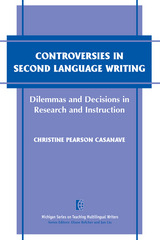 Controversies in Second Language Writing: Dilemmas and Decisions in Research and Instruction
Christine Pearson Casanave
University of Michigan Press, 2003 Controversies in Second Language Writing is not a how-to book, but one that focuses on how teachers in L2 writing can be helped to make reasoned decisions by understanding some of the key issues and conflicting opinions about L2 writing research and pedagogy. This book will assist teachers in making informed decisions about teaching writing in the ESL classroom.
To counteract some of the debates, Casanave explores the different sides of the arguments and provides examples of how other teachers have dealt with these issues. The book presents novice and seasoned teachers with thought-provoking issues and questions to consider when determining and reflecting on their own teaching strategies and criteria.
Topics discussed include:
contrastive rhetoric
product vs. process
fluency and accuracy
assessment of student work
audience
plagiarism
politics and ideology.
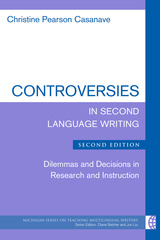 Controversies in Second Language Writing, Second Edition: Dilemmas and Decisions in Research and Instruction
Christine Pearson Casanave
University of Michigan Press, 2017 In the years since the first edition of Controversies in Second Language Writing was published, there been little to no clear resolution of the controversies Casanave so accessibly and fair-mindedly laid out. In fact, many of them have become far more complex and intertwined with many other 21st century issues that teachers of L2 writing cannot help but be affected by in their classrooms. Therefore, this second edition has set out to address: What issues if any have been resolved? What issues have had lasting power from the past, either because people are resistant to change or because the issues continue to be unresolved ones that writing teachers and scholars need to keep discussing?
The second edition is a thorough revision with all chapters updated to refer to works written since the first edition was published. A few chapters have been added: one devoted to writing in a digital era (Chapter 3); one devoted to the debates about English as a lingua franca, "translingual literacy practices," and other hybrid uses of English that have been ongoing in the last ten years (Chapter 4); and one giving special attention to issues related to writing from sources and plagiarism (Chapter 6).
As with the first edition, the second edition of Controversies is not a book that will teach readers how to do things. Rather, it is a book designed to help readers think and to wrestle with issues in L2 writing that are not easily resolved by how-to prescriptions.
The Controversy of Renaissance Art
Alexander Nagel
University of Chicago Press, 2011 Many studies have shown that images—their presence in the daily lives of the faithful, the means used to control them, and their adaptation to secular uses—were at the heart of the Reformation crisis in northern Europe. But the question as it affects the art of Italy has been raised only in highly specialized studies. In this book, Alexander Nagel provides the first truly synthetic study of the controversies over religious images that pervaded Italian life both before and parallel to the Reformation north of the Alps. Tracing the intertwined relationship of artistic innovation and archaism, as well as the new pressures placed on the artistic media in the midst of key developments in religious iconography, The Controversy of Renaissance Art offers an important and original history of humanist thought and artistic experimentation from one of our most acclaimed historians of art.
Controvertibles
Quan Barry
University of Pittsburgh Press, 2004 Controvertibles features more of the refined brilliance and delicate lyricism of this poet, cast in a more meditative mode. Throughout, she examines cultural objects by lifting them out of their usual settings and repositioning them in front of new, disparate backdrops. Doug Flutie's famous Hail Mary pass and Rutger Hauer's role in Blade Runner are contextualized within the Tibetan Book of the Dead. Bob Beamon's world-record-setting long jump in the 1968 Olympics is slowed down and examined in the style of The Matrix's revolutionary bullet time.
Samantha Smith, Richard Nixon, the Shroud of Turin, Igor Stravinsky, the largo from Handel's Xerxes, the resurrection of Lazarus, and the groundbreaking 1984 Apple Computer Super Bowl commercial are among the many disparate people and objects Barry uses to explore the multifaceted nature of existence.
 The Conundrum of Class: Public Discourse on the Social Order in America
Martin J. Burke
University of Chicago Press, 1995 Martin Burke traces the surprisingly complicated history of the idea of class in America from the forming of a new nation to the heart of the Gilded Age.
Surveying American political, social, and intellectual life from the late 17th to the end of the 19th century, Burke examines in detail the contested discourse about equality—the way Americans thought and wrote about class, class relations, and their meaning in society.
Burke explores a remarkable range of thought to establish the boundaries of class and the language used to describe it in the works of leading political figures, social reformers, and moral philosophers. He traces a shift from class as a legal category of ranks and orders to socio-economic divisions based on occupations and income. Throughout the century, he finds no permanent consensus about the meaning of class in America and instead describes a culture of conflicting ideas and opinions.
The Conundrum of Russian Capitalism: The Post-Soviet Economy in the World System
Ruslan Dzarasov
Pluto Press, 2013 The Conundrum of Russian Capitalism looks at the nature of Russian capitalism following the fall of the Soviet Union, showing how the system originated in the degenerated Soviet bureaucracy and the pressures of global capital. Ruslan Dzarasov provides a detailed analysis of Russian corporate governance, labour practices and investment strategies.
By comparing the practices of Russian companies to the typical models of corporate governance and investment behaviour of big firms in the West, Dzarasov sheds light on the relationship between the core and periphery of the capitalist world-system.
This groundbreaking study shows that Russia's new capitalism is not a break with the country's Stalinist past, but in fact the continuation of that tradition.
Convair B-58 Hustler: cold war nuclear bomber
Nico Braas
Amsterdam University Press, 2023 When the B-58 Hustler bomber entered service in 1958 it was a very futuristic looking delta wing bomber, creating a lot of sensation. Intended as a successor of the B-47 Stratojet it could reach twice the speed of sound.
However, problems occurred during the development process and costs risings went so out of control that the whole project was almost cancelled a few times. Strategic Air Command was initially against ordering the B-58 for service, not only because of its complexity but also since they saw no advantage of a Mach 2 bomber over other types. Despite this the B-58 entered service at S.A.C. in 1960. It would have a relatively short operational career.
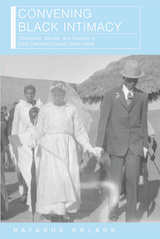 Convening Black Intimacy: Christianity, Gender, and Tradition in Early Twentieth-Century South Africa
Natasha Erlank
Ohio University Press, 2022 An unprecedented study of how Christianity reshaped Black South Africans’ ideas about gender, sexuality, marriage, and family during the first half of the twentieth century. This book demonstrates that the primary affective force in the construction of modern Black intimate life in early twentieth-century South Africa was not the commonly cited influx of migrant workers but rather the spread of Christianity. During the late nineteenth and early twentieth centuries, African converts developed a new conception of intimate life, one that shaped ideas about sexuality, gender roles, and morality. Although the reshaping of Black intimacy occurred first among educated Africans who aspired to middle-class status, by the 1950s it included all Black Christians—60 percent of the Black South African population. In turn, certain Black traditions and customs were central to the acceptance of sexual modernity, which gained traction because it included practices such as lobola, in which a bridegroom demonstrates his gratitude by transferring property to his bride’s family. While the ways of understanding intimacy that Christianity informed enjoyed broad appeal because they partially aligned with traditional ways, other individuals were drawn to how the new ideas broke with tradition. In either case, Natasha Erlank argues that what Black South Africans regard today as tradition has been unequivocally altered by Christianity. In asserting the paramount influence of Christianity on unfolding ideas about family, gender, and marriage in Black South Africa, Erlank challenges social historians who have attributed the key factor to be the migrant labor system. Erlank draws from a wide range of sources, including popular Black literature and the Black press, African church and mission archives, and records of the South African law courts, which she argues have been underutilized in histories of South Africa. The book is sure to attract historians and other scholars interested in the history of African Christianity, African families, sexuality, and the social history of law, especially colonial law.
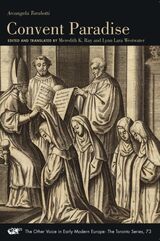 Convent Paradise
Arcangela Tarabotti
Iter Press, 2020 The radical Venetian writer Arcangela Tarabotti (1604–1652), compelled against her will to become a nun, is well known for her scathing attacks on patriarchal institutions for forcing women into convents. Convent Paradise (1643), Tarabotti’s first published work, instead invites the reader into the cloister to experience not only the trials of enclosure, but also its spiritual joys. In stark contrast to her other works, Convent Paradise aims to celebrate the religious culture that colored every aspect of Tarabotti’s experience as a seventeenth-century Venetian and a nun. At the same time, this nuanced exploration of monastic life conveys a markedly feminist spirituality. Tarabotti’s meditative portrait of the convent enriches our understanding of her own life and writing, while also providing a window into a spiritual destiny shared by thousands of early modern women.
The Other Voice in Early Modern Europe - The Toronto Series volume 73
 Convention, 1500–1750
Lawrence Manley
Harvard University Press, 1980 A major reinterpretation of the development of European literary theory, this wide-ranging study offers a new approach to ways of thinking about man's work in general. The book is a history of the idea of convention, the roles it played in the formative stages of English and Continental literary theory and in the development of modern thought.
Lawrence Manley traces the idea of convention to its sources in an ancient debate between philosophers and rhetoricians, whose conflicting views of convention established the terms of the controversy that was revived with new implications during the Renaissance. As a result of related developments in political, legal, moral, religious, and artistic thought, Manley argues, the growing prominence of convention eventually challenged the ancient formulation and brought about a major revision in the order and techniques for the study of human things.
Convention, 1500–1750 discusses literary developments in the context of a much larger debate about the role of convention in the life of man. It attempts to show how this debate marked a transition in intellectual history between ancient and modern views of man's relation to his civilized setting.
 Conventional and Ultimate Truth: A Key for Fundamental Theology
Joseph Stephen O'Leary
University of Notre Dame Press, 2015 In Conventional and Ultimate Truth, Joseph Stephen O'Leary completes his trilogy on contemporary fundamental theology, which began with the volumes Questioning Back (1985) and Religious Pluralism and Christian Truth (1996). Common to all three works are dialogues with European philosophers Martin Heidegger, Jacques Derrida, G. W. F. Hegel, and the Madhyamaka school of Buddhism. In the current volume, O’Leary deals with the nature of theological rationality today, recommending the practice of reflective judgment, as opposed to systematic determinative judgment.
Inspired by the Buddhist notion of conventional truth, O’Leary claims that if we fully accept the fragility and conventionality of religious language, we can find a secure basis for a critical, reflective theology. This proposal is fleshed out in a dialogue with classical negative theology and with the implications of twentieth-century art and literature for religious epistemology. Embracing conventionality does not mean that the dimension of ultimacy is lost. The two are intimately conjoined in the Buddhist two-truths doctrine. Revisiting traditional sites of theological ultimacy, such as the authority of scripture and Christian dogma and the appeal to religious experience, O’Leary argues that we do justice to them only when we fully accept the conventionality of their historical articulation. By relating these traditions of thought to one another, O’Leary produces a new model for contemporary fundamental theology, one that will positively refocus and revitalize the field.
"Works in comparative theology have begun to capture attention in theological circles, including the works of Francis Clooney, James Fredericks, John Keenan, and an increasing number of younger scholars, all writing with fresh insights in Christian theology as enriched by their intellectual sojourns into a religious tradition other than their own. O'Leary's work can be taken in good company with these works, and is a significant contribution in this regard. It is a 'must-read' for those already engaged in comparative theology, and more so for all those in systematic theology who seek to bring their theological insights into conversation with wider circles of thought." —Ruben L. F. Habito, Perkins School of Theology, Southern Methodist University
Conventional Arms Control and East-West Security
Robert D. Blackwill and F. Stephen Larrabee, eds.
Duke University Press, 1989 This important and timely work, prepared by the leading researchers, planners, and policymakers from both Eastern and Western alliances, analyzes the major issues in the Vienna talks on conventional forces in Europe involving NATO and Warsaw Pact nations. It is likely to have a significant influence on the course of these negotiations and on emerging debate on conventional arms control. The contributors met in Moscow prior to the Vienna conference to review and compare their analyses and revised them thereafter for publication in this work.
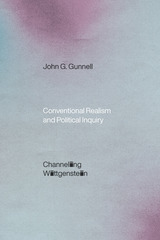 Conventional Realism and Political Inquiry: Channeling Wittgenstein
John G. Gunnell
University of Chicago Press, 2020 When social scientists and social theorists turn to the work of philosophers for intellectual and practical authority, they typically assume that truth, reality, and meaning are to be found outside rather than within our conventional discursive practices.
John G. Gunnell argues for conventional realism as a theory of social phenomena and an approach to the study of politics. Drawing on Wittgenstein’s critique of “mentalism” and traditional realism, Gunnell argues that everything we designate as “real” is rendered conventionally, which entails a rejection of the widely accepted distinction between what is natural and what is conventional. The terms “reality” and “world” have no meaning outside the contexts of specific claims and assumptions about what exists and how it behaves. And rather than a mysterious source and repository of prelinguistic meaning, the “mind” is simply our linguistic capacities. Taking readers through contemporary forms of mentalism and realism in both philosophy and American political science and theory, Gunnell also analyzes the philosophical challenges to these positions mounted by Wittgenstein and those who can be construed as his successors.
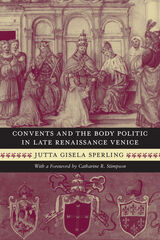 Convents and the Body Politic in Late Renaissance Venice
Jutta Gisela Sperling
University of Chicago Press, 2000 In late sixteenth-century Venice, nearly 60 percent of all patrician women joined convents, and only a minority of these women did so voluntarily. In trying to explain why unprecedented numbers of patrician women did not marry, historians have claimed that dowries became too expensive. However, Jutta Gisela Sperling debunks this myth and argues that the rise of forced vocations happened within the context of aristocratic culture and society.
Sperling explains how women were not allowed to marry beneath their social status while men could, especially if their brides were wealthy. Faced with a shortage of suitable partners, patrician women were forced to offer themselves as "a gift not only to God, but to their fatherland," as Patriarch Giovanni Tiepolo told the Senate of Venice in 1619. Noting the declining birth rate among patrician women, Sperling explores the paradox of a marriage system that preserved the nobility at the price of its physical extinction. And on a more individual level, she tells the fascinating stories of these women. Some became scholars or advocates of women's rights, some took lovers, and others escaped only to survive as servants, prostitutes, or thieves.
Convergence
Jack Fuller
University of Chicago Press, 1990 "A brilliant achievement. . . .Like the best work of Greene and Le Carré, it is more than genre fiction; it is literature. . . .[Convergence] is the most plausible, and perhaps the best spy novel ever written by an American." —Arthur Maling, Chicago Tribune
"An intelligent, readable novel about two kinds of intrigue—international and bureaucratic. He succeeds admirably at both tasks."—Ross Thomas, Washington Post
"A solid, provocative first novel about the 'deadly game of espionage' . . . Thoughtfulness and human frailty take precedence over action and suspense. Irony is the prevailing mode. . . . Fuller depicts intelligence work—its technical minutiae and its vaunted goals—convincingly. And he subtly weaves various parallels into complementary layers of potential convergence."—Jeffrey Burke, Wall Street Journal
"A fast-moving, dramatic, thinking person's spy novel."—Nelson DeMille, Newsday
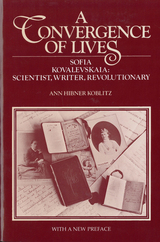 A Convergence of Lives: Sofia Kovalevskaia - Scientist, Writer, Revolutionary
Koblitz, Ann
Rutgers University Press, 1993 To inaugurate a new series, Lives of Women in Science, Rutgers University Press is reissuing this much-acclaimed biography of Sofia Kovalevskaia, the renowned nineteenth-century mathematician, writer, and revolutionary.
Sofia Kovalevskaia's interest in mathematics was roused at an early age--her attic nursery had been wallpapered with lecture notes for a course on calculus. She spent hours studying the mysterious walls, trying to figure out which page followed from the next. Kovalevskaia (1850-1891) became the only woman mathematician whose name all mathematicians recognize, thanks to her contributions to mathematical analysis. Indeed, she was the first professional woman scientist to win international eminence in any field: the first woman doctorate in mathematics, the first to hold a chair in mathematics, the first to sit on the editorial board of a major scientific journal.
She was also an accomplished writer, a proponent of women's rights and education, a wife and mother in an unconventional marriage, and a champion of radical political causes in Russia and Western Europe--a friend and correspondent of Dostoyevsky, Chekhov, George Eliot, Kropotkin, Helmholtz, and Darwin. This sympathetic portrait of a remarkable woman will appeal to any reader, non-mathematicians and mathematicians alike.
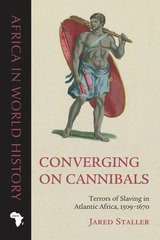 Converging on Cannibals: Terrors of Slaving in Atlantic Africa, 1509–1670
Jared Staller
Ohio University Press, 2019 In Converging on Cannibals, Jared Staller demonstrates that one of the most terrifying discourses used during the era of transatlantic slaving—cannibalism—was coproduced by Europeans and Africans. When these people from vastly different cultures first came into contact, they shared a fear of potential cannibals. Some Africans and European slavers allowed these rumors of themselves as man-eaters to stand unchallenged. Using the visual and verbal idioms of cannibalism, people like the Imbangala of Angola rose to power in a brutal world by embodying terror itself. Beginning in the Kongo in the 1500s, Staller weaves a nuanced narrative of people who chose to live and behave as “jaga,” alleged cannibals and terrorists who lived by raiding and enslaving others, culminating in the violent political machinations of Queen Njinga as she took on the mantle of “Jaga” to establish her power. Ultimately, Staller tells the story of Africans who confronted worlds unknown as cannibals, how they used the concept to order the world around them, and how they were themselves brought to order by a world of commercial slaving that was equally cannibalistic in the human lives it consumed.
A Conversation about Healthy Eating
Nicholas A. Lesica
University College London, 2017 What constitutes a healthy diet? Media and advertisers would like us to think that the answer is complicated and controversial, but science tell us otherwise. Rather than present an ideology, A Conversation About Healthy Eating avoids the typical media noise, to presenting instead the science. This book allows for a comprehensive understanding and provides clear recommendations for how you can adapt both your environment and your lifestyle to make healthy eating possible.
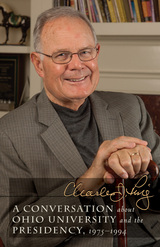 A Conversation about Ohio University and the Presidency, 1975–1994
Charles J. Ping
Ohio University Press, 2013 When Charles Ping first arrived at Ohio University in 1975, the university was experiencing a decline in student enrollment and confronting serious financial challenges. But rather than focusing on its problems, Ping instead concentrated on Ohio University’s potential. During the nineteen years that Ping served as president, he guided Ohio University in scholarship, research, and service while substantially increasing the size of the campus through the acquisition of The Ridges. “What attracted me was, essentially, the richness of the campus in people and programs,” said Ping. A Conversation about Ohio University and the Presidency, 1975–1994 is an edited version of the transcript of videotaped interviews recorded in May and June 2011. “It is a conversation between two old friends,” said Ping of the series of interviews conducted by Sam Crowl, Shakespearean scholar and now trustee professor emeritus.
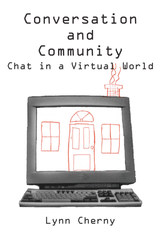 Conversation and Community: Chat in a Virtual World
Lynn Cherny
CSLI, 1999 Conversation and Community is an examination of the speech community in an Internet 'virtual community'. Based on ethnographic research on a community of users of a MUD, or 'multi-user dimension', the book describes a close-knit community united in features of their language use, shared history, and relationships to other online communities. The author invokes the notion of register, or the variety of speech adapted to the communication situation, in her discussion of how users overcome the limitations of the typed, text medium and exploit its affordances for comfortable communication. Routines, conventional vocabulary and abbreviations, syntactic and semantic phenomena, and special turn-taking and repair strategies distinguish the MUD community's register. Because the MUD is programmable, commands may be added which reflect, alter, or reinforce the linguistic practices and culture of the community; competent speakers must also know the commands that produce the correct linguistic forms.
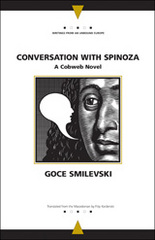 Conversation with Spinoza: A Cobweb Novel
Goce Smilevski
Northwestern University Press, 2006 Prizing ideas above all else, radical thinker Baruch Spinoza left little behind in the way of personal facts and furnishings. But what of the tug of necessity, the urgings of the flesh, to which this genius philosopher (and grinder of lenses) might have been no more immune than the next man-or the next character, as Baruch Spinoza becomes in this intriguing novel by the remarkable young Macedonian author Goce Smilevski.
Smilevski's novel brings the thinker Spinoza and his inner life into conversation with the outer, all-too-real facts of his life and his day--from his connection to the Jewish community of Amsterdam, his excommunication in 1656, and the emergence of his philosophical system to his troubling feelings for his fourteen-year-old Latin teacher Clara Maria van den Enden and later his disciple Johannes Casearius. From this conversation there emerges a compelling and complex portrait of the life of an idea--and of a man who tries to live that idea.
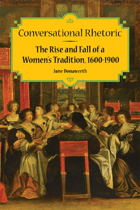 Conversational Rhetoric: The Rise and Fall of a Women's Tradition, 1600-1900
Jane Donawerth
Southern Illinois University Press, 2011 Much of the scholarly exchange regarding the history of women in rhetoric has emphasized women’s rhetorical practices. In Conversational Rhetoric: The Rise and Fall of a Women’s Tradition, 1600–1900, Jane Donawerth traces the historical development of rhetorical theory by women for women, studying the moments when women produced theory about the arts of communication in alternative genres—humanist treatises and dialogues, defenses of women’s preaching, conduct books, and elocution handbooks. She examines the relationship between communication and gender and between theory and pedagogy and argues that women constructed a theory of rhetoric based on conversation, not public speaking, as a model for all discourse. Donawerth traces the development of women’s rhetorical theory through the voices of English and American women (and one much-translated French woman) over three centuries. She demonstrates how they cultivated theories of rhetoric centered on conversation that faded once women began writing composition textbooks for mixed-gender audiences in the latter part of the nineteenth century. She recovers and elucidates the importance of the theories in dialogues and defenses of women’s education by Bathsua Makin, Mary Astell, and Madeleine de Scudéry; in conduct books by Hannah More, Lydia Sigourney, and Eliza Farrar; in defenses of women’s preaching by Ellen Stewart, Lucretia Mott, Catherine Booth, and Frances Willard; and in elocution handbooks by Anna Morgan, Hallie Quinn Brown, Genevieve Stebbins, and Emily Bishop. In each genre, Donawerth explores facets of women’s rhetorical theory, such as the recognition of the gendered nature of communication in conduct books, the incorporation of the language of women’s rights in the defenses of women’s preaching, and the adaptation of sentimental culture to the cultivation of women’s bodies as tools of communication in elocution books. Rather than a linear history, Conversational Rhetoric follows the starts, stops, and starting over in women’s rhetorical theory. It covers a broad range of women’s rhetorical theory in the Anglo-American world and places them in their social, rhetorical, and gendered historical contexts. This study adds women’s rhetorical theory to the rhetorical tradition, advances our understanding of women’s theories and their use of rhetoric, and offers a paradigm for analyzing the differences between men’s and women’s rhetoric from 1600 to 1900.
Conversational Sign Language II: An Intermediate Advanced Manual
Willard J Madsen
Gallaudet University Press, 1972 This book presents English words and their American Sign Language (ASL) equivalents in 63 lessons. Part one covers 750 words and their signs. Part two deals with the interpretation of 220 English idioms (which have over 300 usages in ASL). Part three presents over 300 ASL idioms and colloquialisms prevalent in informal conversations.
Conversational Sign Language II is excellent for the classroom or for self-instructional use and includes a separate index for each part as well as a bibliography. Each of the 63 lessons in the text is illustrated and has follow-up exercises. A practice test is included after every third lesson.
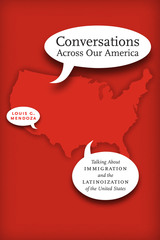 Conversations Across Our America: Talking About Immigration and the Latinoization of the United States
By Louis G. Mendoza
University of Texas Press, 2012 In the summer of 2007, Louis G. Mendoza set off on a bicycle trip across the United States with the intention of conducting a series of interviews along the way. Wanting to move beyond the media’s limited portrayal of immigration as a conflict between newcomers and “citizens,” he began speaking with people from all walks of life about their views on Latino immigration. From the tremendous number of oral histories Mendoza amassed, the resulting collection offers conversations with forty-three different people who speak of how they came to be here and why they made the journey. They touch upon how Latino immigration is changing in this country, and how this country is being changed by Latinoization. Interviewees reflect upon the concerns and fears they’ve encountered about the transformation of the national culture, and they relate their own experiences of living and working as “other” in the United States. Mendoza’s collection is unique in its vastness. His subjects are from big cities and small towns. They are male and female, young and old, affluent and impoverished. Many are political, striving to change the situation of Latina/os in this country, but others are “everyday people,” reflecting upon their lives in this country and on the lives they left behind. Mendoza’s inclusion of this broad swath of voices begins to reflect the diverse nature of Latino immigration in the United States today.
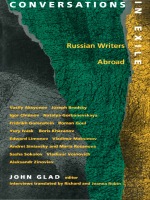 Conversations in Exile: Russian Writers Abroad
John Glad, ed.
Duke University Press, 1993 An entire generation of Russian writers have been living in exile from their homeland. Although today's glasnost has special meaning for many of these banished writers, it does not dissolve their experience of forced separation from their country of origin. In Conversations in Exile, John Glad brings together interviews with fourteen prominent Russian writers in exile, all of whom currently live in the United States, France, or Germany. Conducted between 1978 and 1989, these frank and captivating interviews provide a rich and complex portrait of a national literature in exile. Glad's introduction situates the three distinct waves of westward emigration in their historical and political framework. Organized by genre, the book begins with discussions with the older generation of writers and then moves on to more recent arrivals: the makers of fantasy and humor, the aesthetes, the moralists, and the realists. Each voice is compelling for its invaluable testimony--some reveal startling insights into the persecution of dissidents under Soviet rule while others address the relationship between creativity, writing, and conditions of exile. Taken together these interviews reveal the range of modern Russian writing and document the personalities and positions that have made Russian writers in emigration so diverse, experimental, and controversial. The Writers: Vasily Aksyonov, Joseph Brodsky, Igor Chinnov, Natalya Goranevskaya, Frifrikh Gorensetin, Roman Goul, Yury Ivask, Boris Khazanov, Edward Liminov, Vladimir Makisimov, Andrei Siniavsky and Maria Rozanova, Sasha Sokolov, Vladimir Voinovich, Aleksandr Zinoviev Excerpt
John Glad: You're a Russian poet but an American essayist. Does that bring on any measure of split personality? Do you think you are becoming less and less Russian?
Joseph Brodsky (recipient of 1987 Nobel Prize for Literature): That's not for me to say. As far as I'm concerned, in my inner self, inside, it feels quite natural. I think being a Russian poet and an American essayist is an ideal situation. It's all a matter of whether you have (a) the heart and (b) the brains to be able to do both. Sometimes I think I do. Sometimes I think I don't. Sometimes I think that one interferes with the other.
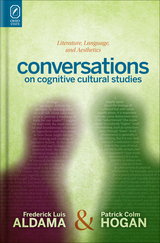 Conversations on Cognitive Cultural Studies: Literature, Language, and Aesthetics
Frederick Luis Aldama and Patrick Colm Hogan
Ohio State University Press, 2014 In recent years, few areas of research have advanced as rapidly as cognitive science, the study of the human mind and brain. A fundamentally interdisciplinary field, cognitive science has both inspired and been advanced by work in the arts and humanities. In Conversations on Cognitive Cultural Studies: Literature, Language, and Aesthetics, Frederick Luis Aldama and Patrick Colm Hogan, two of the most prominent experts on the intersection of mind, brain, and culture, engage each other in a lively dialog that sets out the foundations of a cognitive neuroscientific approach to literature. Despite their shared premises, Aldama and Hogan differ—sometimes sharply—on key issues; their discussion therefore presents the reader not with a single doctrine, but with options for consideration—an appropriate result in this dynamic field.
With clarity and learning, Aldama and Hogan consider five central topics at the intersection of literature and cognitive science. They begin with the fundamental question of the nature of the self. From here, they turn to language, communication, and thought before moving on to the central issue of the structure and operation of narrative. The book concludes with thought-provoking explorations of aesthetics and politics. Illustrating their arguments with work that ranges from graphic fiction and popular cinema to William Faulkner and Bertolt Brecht, Aldama and Hogan leave the reader with a clear sense of what cognitive cultural studies have already achieved and the significant promise the discipline holds for the future.
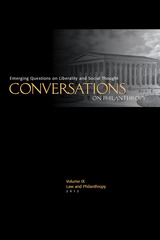 Conversations on Philanthropy, Volume IX: Law & Philanthropy: Emerging Questions on Liberality and Social Thought
Lenore T. Ealy
American Philanthropic, 2013
Conversations on Philanthropy: Emerging Questions on Liberality and Social Thought aim is to promote inquiry and reflection on the importance of liberality—in the dual sense of generosity and of the character befitting free individuals—for the flourishing of local communities, political societies, and humanity in general. As such we seek to open new perspectives on the roles, theories, and practices of philanthropic activities ranging from charitable giving, the actions of eleemosynary organizations, trusts, foundations, voluntary associations, and fraternal societies to volunteerism, mutual aid, social entrepreneurship and other forms of social action with beneficent intention (whether or not also combined with commercial and/or political purposes). To facilitate conversations among traditional academic disciplines, Conversations on Philanthropy will include papers from a number of fields, including history, political science, economics, sociology, anthropology, philosophy, philanthropic studies, religious studies, belles lettres, law, and the physical sciences, as well as from philanthropic practitioners. Published comments on feature essays are a means of providing a transparent peer-review process to enhance interdisciplinary understanding.
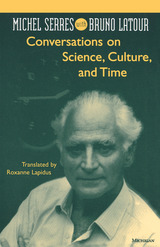 Conversations on Science, Culture, and Time: Michel Serres with Bruno Latour
Michel Serres
University of Michigan Press, 1995 Although elected to the prestigious French Academy in 1990, Michel Serres has long been considered a maverick--a provocative thinker whose prolific writings on culture, science and philosophy have often baffled more than they have enlightened. In these five lively interviews with sociologist Bruno Latour, this increasingly important cultural figure sheds light on the ideas that inspire his highly original, challenging, and transdisciplinary essays.
Serres begins by discussing the intellectual context and historical events-- including the impact of World War II and Hiroshima, which for him marked the beginning of science's ascendancy over the humanities--that shaped his own philosophical outlook and led him to his lifelong mission of bringing together the texts of the humanities and the conceptual revolutions of modern science. He then confronts the major difficulties encountered by his readers: his methodology, his mathematician's fondness for "shortcuts" in argument, and his criteria for juxtaposing disparate elements from different epochs and cultures in extraordinary combinations. Finally, he discusses his ethic for the modern age--a time when scientific advances have replaced the natural necessities of disease and disaster with humankind's frightening new responsibility for vital things formerly beyond its control.
In the course of these conversations Serres revisits and illuminates many of his themes: the chaotic nature of knowledge, the need for connections between science and the humanities, the futility of traditional criticism, and what he calls his "philosophy of prepositions"--an argument for considering prepositions, rather than the conventionally emphasized verbs and substantives, as the linguistic keys to understanding human interactions. For readers familiar with Serres's works as well as for the uninitiated, Conversations on a Life in Philosophy provides fascinating insights into the mind of this appealing, innovative and ardent thinker.
Michel Serres has taught at Clermont-Ferrand, at the University of Paris VIII (Vincennes) and at the Sorbonne. He has served as visiting professor at Johns Hopkins University and has been on the faculty of Stanford University since 1984. Bruno Latour, a philosopher and anthropologist, is Professor of Sociology, L'Ecole Nationale Supérieure des Mines in Paris. He has written several books and numerous articles on the ties between the sciences and the rest of culture and society.
Roxanne Lapidus is Managing Editor of SubStance: A Review of Theory and Literary Criticism. Conversations on a Life in Philosophy was originally published in France as Eclaircissements.
 Conversations on the Edge: Narratives of Ethics and Illness
Richard M. Zaner
Georgetown University Press, 2004 At the edge of mortality there is a place where the seriously ill or dying wait—a place where they may often feel vulnerable or alone. For over forty years, bioethicist cum philosopher Richard Zaner has been at the side of many of those people offering his incalculable gift of listening, and helping to lighten their burdens—not only with his considerable skills, but with his humanity as well. The narratives Richard Zaner shares in Conversations on the Edge are informed by his depth of knowledge in medicine and bioethics, but are never "clinical." A genuine and caring heart beats underneath his compassionate words. Zaner has written several books in which he tells poignant stories of patients and families he has encountered; there is no question that this is his finest. In Conversations on the Edge, Zaner reveals an authentic empathy that never borders on the sentimental. Among others, he discusses Tom, a dialysis patient who finally reveals that his inability to work—encouraged by his overprotective mother—is the source of his hostility to treatment; Jim and Sue, young parents who must face the nightmare of letting go of their premature twins, one after the other; Mrs. Oland, whose family refuses to recognize her calm acceptance of her own death; and, in the final chapter, the author's mother, whose slow demise continues to haunt Zaner's professional and personal life. These stories are filled with pain and joy, loneliness and hope. They are about life and death, about what happens in hospital rooms—and that place at the edge—when we confront mortality. It is the rarest of glimpses into the world of patients, their families, healers, and those who struggle, like Zaner, to understand.
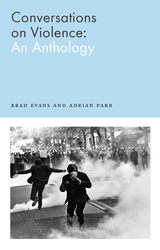 Conversations on Violence: An Anthology
Brad Evans
Pluto Press, 2021 'Brad Evans in one of the brightest critical minds of his generation' - Henry A. Giroux
Whether physical or metaphorical, institutional or interpersonal, violence is everywhere. A seemingly immutable fact of life, it is nonetheless rarely engaged with at the conceptual level. What does violence actually mean? And is it an inevitable part of the human condition?
Conversations on Violence brings together many of the world's leading critical scholars, artists, writers and cultural producers to provide a kaleidoscopic exploration of the concept of violence. Through in-depth interviews with thirty figures including Marina Abramovic, Kehinde Andrews and Simon Critchley, Brad Evans and Adrian Parr interrogate violence in all its manifestations, including its role in politics, art, gender discrimination and decolonisation.
Provocative, eye-opening and bracingly original, Conversations on Violence sheds light on a defining political and ethical concern of our age.
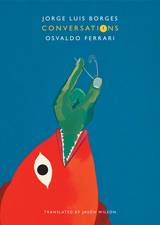 Conversations, Volume 1
Jorge Luis Borges and Osvaldo Ferrari
Seagull Books, 2014 Buddhism, love, Henry James, and the tango are just a few of the topics Jorge Luis Borges, Argentina’s master writer, and extraordinary conversationalist, discusses in the first volume of the remarkable new series, Conversations. The eighty-four-year-old blind man’s wit is unending and results in lively and insightful discussions that configure a loose autobiography of a subtle, teasing mind. Borges’s favorite concepts, such as time and dreaming, are touched upon, but these dialogues are not a true memoir, they are unrestricted conversations about life at present.
The Argentine short-story writer, essayist, poet and translator, contributed immensely to twentieth-century literature, and more specifically to the genres of magical realism and fantasy. As he progressively lost his sight—he became completely blind by the age of fifty-five—the darkness behind his eyelids held enchanting imagery that translated into rich symbolism in his work. The inner workings of his curious mind are seen vividly in his conversations with Ferrari, and there’s not a subject on which he doesn’t cast surprising new light. As in his tale “The Other,” where two Borgeses meet up on a bench beside the River Charles, this is a dialogue between a young poet and the elder teller of tales where all experience floats in a miracle that defies linear time.
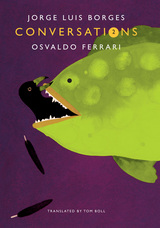 Conversations: Volume 2
Jorge Luis Borges and Osvaldo Ferrari
Seagull Books, 2015 Recorded during Jorge Luis Borges’s final years, this second volume of his conversations with Osvaldo Ferrari provides a wide-ranging reflection on the life and work of Argentina’s master writer and favorite conversationalist.
In Conversations: Volume 2, Borges and Ferrari engage in a dialogue that is both improvisational and frequently humorous as they touch on subjects as diverse as epic poetry, detective fiction, Buddhism, and the moon landing. With his signature wit, Borges offers insight into the philosophical basis of his stories and poems, his fascination with religious mysticism, and the idea of life as a dream. He also dwells on more personal themes, including the influence of his mother and father on his intellectual development, his friendships, and living with blindness. These recollections are alive to the passage of history, whether in the changing landscape of Buenos Aires or a succession of political conflicts, leading Borges to contemplate what he describes as his “South American destiny.”
The recurrent theme of these conversations, however, is a life lived through books. Borges draws on the resources of a mental library that embraces world literature—ancient and modern. He recalls the works that were a constant presence in his memory and maps his changing attitudes to a highly personal canon. In the prologue to the volume, Borges celebrates dialogue and the transmission of culture across time and place. These conversations are a testimony to the supple ways that Borges explored his own relation to numerous traditions.
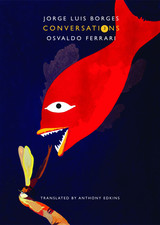 Conversations: Volume 3
Jorge Luis Borges and Osvaldo Ferrari
Seagull Books, 2017 Recorded during Borges’ final years, this third volume of his conversations with Osvaldo Ferrari offers a rare glimpse into the life and work of Argentina’s master writer and favorite conversationalist.
In Conversations: Volume 3, Borges and Ferrari discuss subjects as diverse as film criticism, fantastic literature, science fiction, the Argentinian literary tradition, and the works of writers such as Bunyan, Wilde, Joyce, and Yeats, among others. With his signature wit, Borges converses on the philosophical basis of his writing, his travels, and his fascination with religious mysticism. He also ruminates on more personal themes, including the influence of his family on his intellectual development, his friendships, and living with blindness.
The recurrent theme of these conversations, however, is a life lived through books. Borges draws on the resources of a mental library that embraces world literature, both ancient and modern. He recalls the works that were a constant presence in his memory and maps his changing attitudes to a highly personal canon. These conversations are a testimony to the supple ways that Borges explored his own relation to numerous traditions—the conjunction of his life, his lucidity, and his imagination.
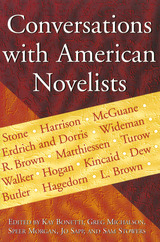 Conversations with American Novelists
Edited by Kay Bonetti, Greg Michalson, Speer Morgan, Jo Sapp, & Sam Stowers
University of Missouri Press, 1997 Readers of fine novels cherish the opportunity to hear their favorite novelists speak directly, without commentary or interpretation, about how their lives and concerns drive their fiction writing. For twenty years The Missouri Review has brought these readers some of the most compelling and thought- provoking literary interviews in print. In this collection of fifteen in-depth interviews with contemporary novelists, the authors discuss the style and themes of their work, their writing habits, their cultural and social backgrounds, and larger aesthetic issues with refreshing insight about themselves and their art. Originally conducted for the American Audio Prose Library, the interviews were then edited for publication in The Missouri Review. Here they are reproduced with an introduction and with a brief biographical and bibliographical headnote for each writer. These candid interviews with some of our favorite novelists are sure to delight all readers. Authors Interviewed in This Volume: Robert Stone
Jamaica Kincaid
Jim Harrison
Tom McGuane
Louise Erdrich and Michael Dorris
John Edgar Wideman
Robb Forman Dew
Rosellen Brown
Peter Matthiessen
Scott Turow
Margaret Walker
Linda Hogan
Robert Olen Butler
Jessica Hagedorn
Larry Brown
Conversations with Angels: What Swedenborg Heard in Heaven
DONALD ROSE
Swedenborg Foundation Publishers, 1996 "...an engaging, fascinating contribution to angelic studies."
---Reviewer's Bookwatch
This fresh translation brings together the most remarkable selections from Swedish visionary Emanuel Swedenborg's works about the wisdom imparted to him by angels. These stories reveal the angels' natures, their spiritual loves, their heavenly education, and the true source of wisdom and beauty. These spirits share their knowledge for the good of those on earth, who are themselves created to become angels.
Look for this book's companion piece, Debates with Devils.
 Conversations with Christian Metz: Selected Interviews on Film Theory (1970-1991)
Edited by Warren Buckland and Daniel Fairfax
Amsterdam University Press, 2017 From 1968 to 1991 the acclaimed film theorist Christian Metz wrote several remarkable books on film theory: Essais sur la signifi cation au cinéma, tome1 et 2; Langage et cinéma; Le signifiant imaginaire; and L’Enonciation impersonnelle. These books set the agenda of academic film studies during its formative period. Metz’s ideas were taken up, digested, refined,reinterpreted, criticized and sometimes dismissed, but rarely ignored.
This volume collects and translates into English for the first time a series of interviews with Metz, who offers readable summaries,elaborations, and explanations of his sometimes complex and demanding theories of film. He speaks informally of the most fundamental concepts that constitute the heart of film theory as an academic discipline — concepts borrowed from linguistics, semiotics, rhetoric, narratology, and psychoanalysis.
Within the colloquial language of the interview, we witness Metz’s initial formation and development of his film theory. The interviewers act as curious readers who pose probing questions to Metz about his books, and seek clarification and elaboration of his key concepts. We also discover the contents of his unpublished manuscript on jokes, his relation to Roland Barthes, and the social networks operative in the French intellectual community during the 1970s and 1980s.
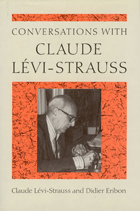 Conversations with Claude Levi-Strauss
Claude Lévi-Strauss and Didier Eribon
University of Chicago Press, 1991 At the age of eighty, one of the most influential yet reclusive intellectuals of the twentieth century consented to his first interviews in nearly thirty years. Hailed by Le Figaro as "an event," the resulting conversations between Claude Lévi-Strauss and Didier Eribon (a correspondent for Le Nouvel Observateur) reveal the great anthropologist speaking of his life and work with ease and humor.
Now available in English, the conversations are rich in Lévi-Strauss's candid appraisals of some of the best-known figures of the Parisian intelligentsia: surrealists André Breton and Max Ernst, with whom Lévi-Strauss shared a bohemian life in 1940s Manhattan; de Beauvoir, Sartre, and Camus, the stars of existentialism; Leiris, Foucault, Dumézil, Jacob, Lacan, and others. His long friendships with Jakobson and Merleau-Ponty are recalled, as well as his encounters with prominent figures in American anthropology: Lowie, Boas (who suddenly died in his chair beside Lévi-Strauss at a banquet at Columbia University), Benedict, Linton, Mead, and Kroeber.
Lévi-Strauss speaks frankly about how circumstances and his own inclinations, after his early fieldwork in Brazil, led him to embrace theoretical work. His straightforward answers to Eribon's penetrating questions—What is a myth? What is structuralism? Are you a philosopher?—clarify his intellectual motives and the development of his research; his influential role as an administrator, including the founding of the Laboratory of Social Anthropology and of the journal L'Homme; the course of his writings, from Elementary Structures of Kinship to The Jealous Potter; and his thoughts on the conduct of anthropology today.
Never before has Lévi-Strauss spoken so freely on so many aspects of his life: his initial failure to be elected to the Collège de France; his reaction to the events of May 1968; his regrets at not being a great investigative reporter or playwright; his deep identification with Wagner, Proust, and Rousseau. This is a rare opportunity to become acquainted with a great thinker in all his dimensions.
 Conversations with Extinct Animals: A Novel
Patrick Lawler
University of Alabama Press, 2024 An experimental narrative by eco-fiction author and poet Patrick Lawler evolves out of the interactions between twenty-four extinct animals and those characters who struggle for significance in the face of their own extinction. Patrick Lawler’s second novel, Conversations with Extinct Animal, is a dialogue between psychology and ecology—between poetry and story. A suicide note masquerading as a love letter, the novel transcends genres and keeps kaleidoscopically shifting: sometimes it is an elegy, and sometimes it is a therapy session—but always these are the field notes for the end of the world. As a collection of characters associated with The Facility come to terms with an individual’s death, they must confront their own losses amid the colossal absence of the twenty-four extinct animals. All the characters float between various inexplicable, mystifying “syndromes” that call into question their identities and, ultimately, call into question the elements of story itself. “Looking at pictures of the Extinct Animals, I can’t help but wonder if it is too late to save the world—especially since there are so many different worlds,” observes the narrator of the novel in his efforts to save the unsavable.
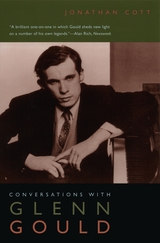 Conversations with Glenn Gould
Jonathan Cott
University of Chicago Press, 2005 One of the most idiosyncratic and charismatic musicians of the twentieth century, pianist Glenn Gould (1932–82) slouched at the piano from a sawed-down wooden stool, interpreting Bach, Beethoven, and Mozart at hastened tempos with pristine clarity. A strange genius and true eccentric, Gould was renowned not only for his musical gifts but also for his erratic behavior: he often hummed aloud during concerts and appeared in unpressed tails, fingerless gloves, and fur coats. In 1964, at the height of his controversial career, he abandoned the stage completely to focus instead on recording and writing.
Jonathan Cott, a prolific author and poet praised by Larry McMurtry as "the ideal interviewer," was one of the very few people to whom Gould ever granted an interview. Cott spoke with Gould in 1974 for Rolling Stone and published the transcripts in two long articles; after Gould's death, Cott gathered these interviews in Conversations with Glenn Gould, adding an introduction, a selection of photographs, a list of Gould's recorded repertoire, a filmography, and a listing of Gould's programs on radio and TV. A brilliant one-on-one in which Gould discusses his dislike of Mozart's piano sonatas, his partiality for composers such as Orlando Gibbons and Richard Strauss, and his admiration for the popular singer Petula Clark (and his dislike of the Beatles), among other topics, Conversations with Glenn Gould is considered by many, including the subject, to be the best interview Gould ever gave and one of his most remarkable performances.
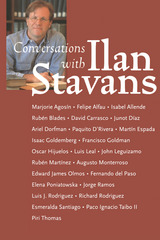 Conversations with Ilan Stavans
Ilan Stavans
University of Arizona Press, 2005 For almost twenty years, Ilan Stavans—described by the Washington Post as "Latin America’s liveliest and boldest critic and most innovative cultural enthusiast"—has interviewed path-breaking intellectuals and artists in a wide range of media. As host of the critically acclaimed PBS series La Plaza, he interviews guests on pressing issues that affect the Western Hemisphere today, asking hard-hitting questions on immigration, religion, bilingualism, race, and democracy. This book collects for the first time in one volume Stavans’s most provocative and enlightening interviews with Hispanics from both sides of the Rio Grande.
Spontaneous and surprising, these conversations reflect Latino life in the United States in all its facets. Among the more than two dozen selections, Edward James Olmos talks about Hispanics in Hollywood; John Leguizamo describes how he shapes a stage show; author Richard Rodriguez reflects on his gang background; Esmeralda Santiago takes on the Puerto Rican stereotype; and Piri Thomas shares thoughts on the writing of Down These Mean Streets. "A conversation is a tango," writes Stavans, "for it takes two to dance it." Conversations with Ilan Stavans invites readers to catch the rhythm and enjoy these unique meetings of minds.
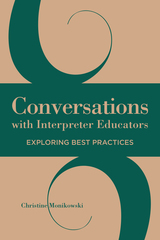 Conversations with Interpreter Educators: Exploring Best Practices
Christine Monikowski
Gallaudet University Press, 2017 Sign language interpreter education is a relatively young field that is moving toward more theory-based and research-oriented approaches. The concept of sharing research, which is strongly encouraged in this academic community, inspired Christine Monikowski to develop a volume that collects and distills the best teaching practices of leading academics in the interpreting field.
In Conversations with Interpreter Educators, Monikowski assembles a group of 17 professors in the field of sign language interpretation. Through individual interviews conducted via Skype, Monikowski engages them in informal conversations about their teaching experiences and the professional publications that have influenced their teaching philosophies. She guides each conversation by asking these experts to share a scholarly publication that they assign to their students. They discuss the merits of the text and its role in the classroom, which serves to highlight the varying goals each professor sets for students. The complexity of the interpreting task, self-reflection, critical thinking, linguistics, backchannel feedback, and cultural understanding are a sampling of topics explored in these exchanges. Engaging and accessible, Monikowski’s conversations offer evidence-based practices that will inform and inspire her fellow educators.
Conversations with Isabel Allende: Revised Edition
Edited by John Rodden
University of Texas Press, 2004 This revised edition has been updated to cover Allende's three newest books—City of the Beasts, Portrait in Sepia: A Novel, and Daughter of Fortune. It includes four new interviews in which Allende discusses completing her trilogy of novels that began with House of the Spirits, as well as her ongoing spiritual adventure and political interests.
Conversations with Jean Piaget
Jean-Claude Bringuier
University of Chicago Press, 1989 "What is most impressive about this book is its intelligence, its sophistication, and its charm. . . . This book presents Piaget's work and his person better than anything else that I know about."—David Elkind, Tufts University
"The tone is one of constant movement from the most ordinary to the most abstruse. There are 14 conversations with 'le Patron,' some in 1969, some in 1975, and several more with co-workers in various fields. . . . In Mr. Bringuier's book, in a pleasant informal way, we see a sophisticated non-scientist exploring Piaget's domain with the master. Some of Piaget's best-known findings about children as explained along the way, but Mr. Bringuier has ways of bringing out the relation of this psychological work to the whole of Piaget's enterprise, and we get a good sense of the man and his work."—Howard E. Gruber, New York Times Book Review
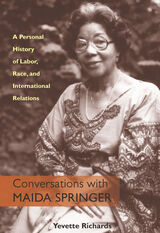 Conversations With Maida Springer: A Personal History Of Labor, Race, and International Relations
Yevette Richards
University of Pittsburgh Press, 2004
Born in Panama in 1910, Maida Springer grew up in Harlem. While still a young girl she learned firsthand of the bleak employment options available to African American females of her time. After one employer closed his garment shop and ran off with the workers’ wages in the midst of the Depression, Springer joined Local 22 of the International Ladies’ Garment Workers’ Union.
This proved to be the first step in a remarkable advancement through the ranks of labor leadership positions that were typically dominated by white men. Ultimately, Springer became one of the AFL-CIO’s most important envoys to emerging African nations, earning her the nickname "Mama Maida" throughout that continent.
In this brilliantly edited collection of interviews, Yevette Richards allows Springer to tell her story in her own words. The result is a rare glimpse into the private struggles and thoughts behind one of the twentieth century’s most fascinating international labor leaders.
Conversations with Nelson Algren
H. E. F. Donohue and Nelson Algren
University of Chicago Press, 2001 In these frank and often devastating conversations Nelson Algren reveals himself with all the gruff humor, deflating insight, honesty, and critical brilliance that marked his career. Prodded by H. E. F. Donohue, Algren discusses everything from his childhood to his compulsion to write to his relationship with Simone de Beauvoir. The result is a masterful portrait of a rebel and a major American writer.
Conversations with Picasso
Brassaï
University of Chicago Press, 1999 "Read this book if you want to understand me."—Pablo Picasso
Conversations with Picasso offers a remarkable vision of both Picasso and the entire artistic and intellectual milieu of wartime Paris, a vision provided by the gifted photographer and prolific author who spent the early portion of the 1940s photographing Picasso's work. Brassaï carefully and affectionately records each of his meetings and appointments with the great artist, building along the way a work of remarkable depth, intimate perspective, and great importance to anyone who truly wishes to understand Picasso and his world.
Conversations with Primo Levi
Ferdinando Camon
Northwestern University Press, 1989 Beginning in 1982 and at intervals over the next four years Ferdinando Camon traveled to Turin for a series of meetings with Primo Levi. This book is the record of their dialogues. Levi spoke of the war, of anti-Semitism, of the camps, of German guilt, of Israel's emergence, and of his own extraordinary life and work. The give-and-take of the discussion, its tone, its lucidity, its intelligence, lift it well above the level and format of the usual journalistic interview with a celebrated author.
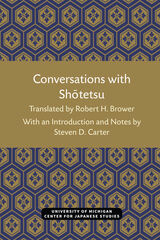 Conversations with Shotetsu
Translated by Robert H. Brower; With an Introduction and Notes by Steven D. Carter
University of Michigan Press, 1992 Shōtetsu monogatari was written by a disciple of Shōtetsu (1381–1459), whom many scholars regard as the last great poet of the courtly tradition. The work provides information about the practice of poetry during the 14th and 15th centuries, including anecdotes about famous poets, advice on how to treat certain standard topics, and lessons in etiquette when attending or participating in poetry contests and gatherings. But unlike the many other works of that time that stop at that level, Shōtetsu’s contributions to medieval aesthetics gained prominence, showing him as a worthy heir—both as poet and thinker—to the legacy of the great poet-critic Fujiwara no Teika (1162–1241). The last project of the late Robert H. Brower, Conversations with Shôtetsu provides a translation of the complete Nihon koten bungaku taikei text, as edited by Hisamatsu Sen'ichi. Steven D. Carter has annotated the translation and provided an introduction that details Shôtetsu’s life, his place in the poetic circles of his day, and the relationship of his work to the larger poetic tradition of medieval Japan. Conversations with Shōtetsu is important reading for anyone interested in medieval Japanese literature and culture, in poetry, and in aesthetics. It provides a unique look at the literary world of late medieval Japan.
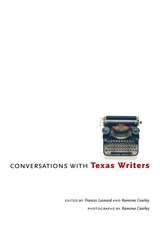 Conversations with Texas Writers
Edited by Frances Leonard and Ramona Cearley, for Humanities Texas
University of Texas Press, 2005 Larry McMurtry declares, "Texas itself doesn't have anything to do with why I write. It never did." Horton Foote, on the other hand, says, "I've just never had a desire to write about any place else." In between those figurative bookends are hundreds of other writers—some internationally recognized, others just becoming known—who draw inspiration and often subject matter from the unique places and people that are Texas. To give everyone who is interested in Texas writing a representative sampling of the breadth and vitality of the state's current literary production, this volume features conversations with fifty of Texas's most notable established writers and emerging talents. The writers included here work in a wide variety of genres—novels, short stories, poetry, plays, screenplays, essays, nonfiction, and magazine journalism. In their conversations with interviewers from the Writers' League of Texas and other authors' organizations, the writers speak of their apprenticeships, literary influences, working habits, connections with their readers, and the domestic and public events that have shaped their writing. Accompanying the interviews are excerpts from the writers' work, as well as their photographs, biographies, and bibliographies. Joe Holley's introductory essay—an overview of Texas writing from Cabeza de Vaca's 1542 Relación to the work of today's generation of writers, who are equally at home in Hollywood as in Texas—provides the necessary context to appreciate such a diverse collection of literary voices. A sampling from the book: "This land has been my subject matter. One thing that distinguishes me from the true naturalist is that I've never been able to look at land without thinking of the people who've been on it. It's fundamental to me." —John Graves "Writing is a way to keep ourselves more in touch with everything we experience. It seems the best gifts and thoughts are given to us when we pause, take a deep breath, look around, see what's there, and return to where we were, revived." —Naomi Shihab Nye "I've said this many times in print: the novel is the middle-age genre. Very few people have written really good novels when they are young, and few people have written really good novels when they are old. You just tail off, and lose a certain level of concentration. Your imaginative energy begins to lag. I feel like I'm repeating myself, and most writers do repeat themselves." —Larry McMurtry "I was a pretty poor cowhand. I grew up on the Macaraw Ranch, east of Crane, Texas. My father tried very hard to make a cowboy out of me, but in my case it never seemed to work too well. I had more of a literary bent. I loved to read, and very early on I began to write small stories, short stories, out of the things I liked to read." —Elmer Kelton
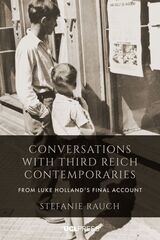 Conversations with Third Reich Contemporaries: From Luke Holland’s Final Account
Stefanie Rauch
University College London, 2025 A collection of filmmaker Luke Holland’s interviews with elderly Germans who witnessed—or participated in—the atrocities of the Holocaust.
Conversations with Third Reich Contemporaries presents excerpts from filmed interviews conducted by British documentary filmmaker Luke Holland across a span of over a decade. These interviews were compiled into the German-language documentary film Final Account (2020), completed shortly before Holland’s death. Most interviewees were young adults when the war ended; some had benefited from Nazism, and others had directly enacted persecution or state violence. In addition to making this vital interview collection more widely accessible, the sourcebook raises critical awareness of issues around representation, authenticity, memory, and the co-production of narratives, reshaping discussions around the role of “ordinary” citizens under the Third Reich. It is the first sourcebook to engage directly with issues of representation and identity after 1945.
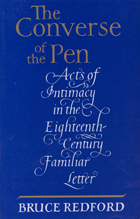 The Converse of the Pen: Acts of Intimacy in the Eighteenth-Century Familiar Letter
Bruce Redford
University of Chicago Press, 1987 Though historians of English literature have long labeled the eighteenth century the golden age of letter writing, few have paid more than lip service to the unique epistolary craftsmanship of the period. Bruce Redford corrects this omission with the first sustained investigation of the eighteenth-century familiar letter as a literary form in its own right. His study supplies the reader with a critical approach and biographical perspective for appreciating the genre that defined an era.
Redford examines six masters of the "talking letter": Lady Mary Wortley Montagu, William Cowper, Thomas Gray, Horace Walpole, James Boswell, and Samuel Johnson. All seek the paradoxical goal of artful spontaneity. Each exploits the distinctive resources of the eighteenth-century letter writer: a flexible conversational manner, a repertoire of literary and social allusion, a flair for dramatic impersonation. The voices of these letter writers "make distance, presence," in Samuel Richardson's phrase, by devising substitutes for gesture, vocal inflection, and physical context, turning each letter into a performance—an act. The resulting verbal constructs create a mysterious tension between the claims of fact and the possibilities of art. Redford recovers a neglected literary form and makes possible a deeper understanding of major eighteenth-century writers who devoted much of their talent and time to "the converse of the pen."
 Conversion
Miriam Bodian
Rutgers University Press, 2026 In Conversion, Miriam Bodian considers the now-universalized term "conversion" in a Jewish context as broadly as possible, as an act of socioreligious boundary crossing. It charts how, across the long arc of Jewish history from biblical times to the present, patterns of boundary crossing have developed and shifted, whether of Gentiles entering Jewish life or of Jews exiting from it. It analyzes the biblical passages that have informed Jewish thinking about what is required to become a Jew before turning to the early rabbis’ institution of a ritualized process of conversion. It then considers the protean ways in which Gentiles have become Jews and Jews have joined other religious communities from medieval to modern times. A further section is devoted to the complexities of conversion in the contemporary Jewish world, where conversions are not necessarily recognized across denominations, where substantial intermarriage has eroded the traditional boundaries between Jew and Gentile, and where the modern state of Israel plays a role that reaches beyond its borders in determining who is a Jew.
Conversion Factors: S. I. Units and Many Others
Colin J. Pennycuick
University of Chicago Press, 1988 This invaluable reference manual provides well-organized tables of over 2100 conversion factors for measures ranging from time and length to metabolic rate and viscosity. An index defines each term: acres, dynes, joules, liters, knots, and so on. Also included are guides to abbreviations, to physical and technical dimensions, and to the système internationale (SI).
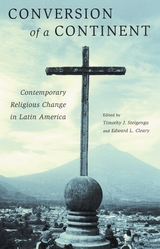 Conversion of a Continent: Contemporary Religious Change in Latin America
Steigenga, Timothy
Rutgers University Press, 2007 A massive religious transformation has unfolded over the past forty years in Latin America and the Caribbean. In a region where the Catholic Church could once claim a near monopoly of adherents, religious pluralism has fundamentally altered the social and religious landscape.
Conversion of a Continent brings together twelve original essays that document and explore competing explanations for how and why conversion has occurred. Contributors draw on various insights from social movement theory to religious studies to help outline its impact on national attitudes and activities, gender relations, identity politics, and reverse waves of missions from Latin America aimed at the American immigrant community.
Unlike other studies on religious conversion, this volume pays close attention to who converts, under what circumstances, the meaning of conversion to the individual, and how the change affects converts’ beliefs and actions. The thematic focus makes this volume important to students and scholars in both religious studies and Latin American studies.
 The Conversion of Imagination: From Pascal through Rousseau to Tocqueville
Matthew W. Maguire
Harvard University Press, 2006 From romanticism through postmodernism, the imagination has become an indispensable reference point for thinking about the self, culture, philosophy, and politics. How has imagination so thoroughly influenced our understanding of experience and its possibilities? In a bold reinterpretation of a crucial development in modern European intellectual history, Matthew W. Maguire uncovers a history of French thought that casts the imagination as a dominant faculty in our experience of the world.
Pascal, turning Augustinianism inside out, radically expanded the powers of imagination implicit in the work of Montaigne and Descartes, and made imagination the determinative faculty of everything from meaning and beauty to political legitimacy and happiness. Maguire traces the ways that others, including Montesquieu and Voltaire, developed and assigned limits to this exalted imagination. But it is above all Rousseau's diverse writings that engage with an expansive imagination. And in the writings of Rousseau's careful readers, particularly Alexis de Tocqueville, imagination is increasingly understood as the medium for an ineffable human freedom against the constrictive power of a new order in politics and culture.
Original and thought-provoking, The Conversion of Imagination will interest a range of readers across intellectual history, political theory, literary and cultural studies, and the history of religious thought.
 Conversion to Modernism: The Early Work of Man Ray
Francis M. Naumann
Rutgers University Press, 2003 Man Ray (1890–1976) has long been considered one of the most versatile and innovative artists of the twentieth century. As a painter, writer, sculptor, photographer, and filmmaker, he is best known for his intimate association with the French Surrealist group in Paris during the 1920s and 1930s, particularly for his highly inventive and unconventional photographic images. These remarkable accomplishments, however, have tended to overshadow the importance of his earlier work—significant not only for comprehending Man Ray’s future artistic development, but also for fleshing out our understanding of the visual arts in America during one of the most important and crucial phases of the evolution of modernism.
The book, and the exhibition for which this work will serve as the catalog, concentrate on Man Ray’s production from 1907 to 1917. Conversion to Modernism will be the first comprehensive, fully illustrated work to examine this artist’s seminal years. The show and the catalog begin with Man Ray’s high school years in Brooklyn, his studies at the Art Students League and the American Academy in New York, and the time he spent in life drawing classes at the more progressive Ferrer Center
From 1913 to 1915, Man Ray lived in a small artists’ colony in Grantwood, New Jersey. It was here, studying with Samuel Halpert (a former student of Matisse), that Man Ray began to become the artist we know today. The last section of the show and of the book include recently discovered photographs and other works that are influenced by a knowledge of the emergent Dada movement. Here is Man Ray in recognizable form just before he leaves the country for France in 1921.
This exhibit will first be on display at the Montclair Art Museum from January 26 through March 2003. It will then travel to museums in Athens, Georgia, Philadelphia, and Chicago.
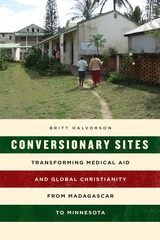 Conversionary Sites: Transforming Medical Aid and Global Christianity from Madagascar to Minnesota
Britt Halvorson
University of Chicago Press, 2018 Drawing on more than two years of participant observation in the American Midwest and in Madagascar among Lutheran clinicians, volunteer laborers, healers, evangelists, and former missionaries, Conversionary Sites investigates the role of religion in the globalization of medicine. Based on immersive research of a transnational Christian medical aid program, Britt Halvorson tells the story of a thirty-year-old initiative that aimed to professionalize and modernize colonial-era evangelism. Creatively blending perspectives on humanitarianism, global medicine, and the anthropology of Christianity, she argues that the cultural spaces created by these programs operate as multistranded “conversionary sites,” where questions of global inequality, transnational religious fellowship, and postcolonial cultural and economic forces are negotiated.
A nuanced critique of the ambivalent relationships among religion, capitalism, and humanitarian aid, Conversionary Sites draws important connections between religion and science, capitalism and charity, and the US and the Global South.
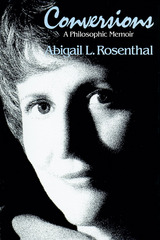 Conversions
Abigail Rosenthal
Temple University Press, 1995 Conversions: A Philosophic Memoir belongs to the tradition of Augustine and Rousseau: the "confession" of a life that is a quest for truth. It is in large part the story of two major episodes from Abigail Rosenthal's early adulthood, bought putting personal identity dramatically at risk.
As a young Fulbright scholar in Paris, Rosenthal met and entered reluctantly into a love affair with a young Greek communist philosopher who believed (along with many Parisian intellectuals of that era) that force and deception were justified by a utopian vision of world history. In the inevitable collision of values--between Jew and Greek, liberal and revolutionary, theist and atheist, woman and man in unequal truggle--they separated.
Suffering in the aftermath, she at last turned for help to a young African American woman graduate student whom she met in London. This woman's Gnostic Christian rejection of personal and cultural history eventually left Rosenthal without defense against her new mentor's remarkable use of charisma, ridicule, and moralistic reproach to usurp the author's life story. These stratagems of mind control reached a climactic phase in Portugal, where the two went--Rosenthal to paint the other woman to write--in what would turn out to be the terrifying reverse of a summer idyll. With the U.S. State Department, the Portuguese PolicÃa Internacional devised an extraordinary rescue.
This arresting narrative, which deals with relations between blacks and whites, Christians and Jews, and men and women, delivers its own philosophic theory of the individual in history.
"Rosenthal's work belongs to the classical tradition of the life that is a quest for truth. Pertinent to the genre is its relation to the tradition of Augustine and Rousseau. She is also anti-Augustinian in that her depiction of history is oriented by the standpoint of Judaism rather than Christianity and is bound up with a quest for the historical realization of justice.
"The first of the two episodes she recounts is a love affair (entered into reluctantly) with a young Greek communist philosopher whom she met in Paris while a Fulbright student in the late 1950s. The second, darker, episode is a later Pygmalion-like involvement with an African American woman graduate student whom Rosenthal first encountered in London, where she worked on a Hegel dissertation, and with whom she entered into a life-threatening reverse, as it were, idyll in a small Portuguese village. The saga is replete with details that could have been dreamt up by Le Carre: Salazar's Portugal, its intelligence arm, the U.S. State Department. Her depiction of these complex relations raises in unsettling ways the question of what counts as freedom, as racism, as terror.
"Her in-passing observations about analytic philosophy, existentialism, and postmodernism (and I am far from being in her camp on many issues) are worth the price of the book. Hers is an original philosophic mind."
--Edith Wyschogrod, 1993 President of the American Academy of Religion and Jay Newton Rayzor Professor of Philosophy and Religious Thought, Rice University
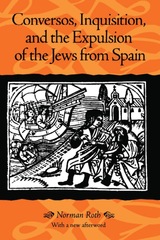 Conversos, Inquisition, and the Expulsion of the Jews from Spain
Norman Roth
University of Wisconsin Press, 2002 The Jewish community of medieval Spain was the largest and most important in the West for more than a thousand years, participating fully in cultural and political affairs with Muslim and Christian neighbors. This stable situation began to change in the 1390s, and through the next century hundreds of thousands of Jews converted to Christianity. Norman Roth argues here with detailed documentation that, contrary to popular myth, the conversos were sincere converts who hated (and were hated by) the remaining Jewish community. Roth examines in depth the reasons for the Inquisition against the conversos, and the eventual expulsion of all Jews from Spain.
“With scrupulous scholarship based on a profound knowledge of the Hebrew, Latin, and Spanish sources, Roth sets out to shatter all existing preconceptions about late medieval society in Spain.”—Henry Kamen, Journal of Ecclesiastical History
“Scholarly, detailed, researched, and innovative. . . . As the result of Roth’s writing, we shall need to rethink our knowledge and understanding of this period.”—Murray Levine, Jewish Spectator
“The fruit of many years of study, investigation, and reflection, guaranteed by the solid intellectual trajectory of its author, an expert in Jewish studies. . . . A contribution that will be particularly valuable for the study of Spanish medievalism.”—Miguel Angel Motis Dolader, Annuario de Estudios Medievales
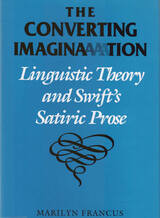 The Converting Imagination: Linguistic Theory and Swift's Satiric Prose
Marilyn Francus
Southern Illinois University Press, 1994
By illuminating Jonathan Swift’s fascination with language, Marilyn Francus shows how the linguistic questions posed by his work are at the forefront of twentieth-century literary criticism: What constitutes meaning in language? How do people respond to language? Who has (or should have) authority over language? Is linguistic value synonymous with literary value?
Francus starts with a detailed analysis of Swift’s linguistic education, which straddled a radical transition in linguistic thought, and its effect on his prose. This compelling beginning includes sometimes surprising historical information about the teaching and learning of linguistics and language theory in the seventeenth and eighteenth centuries. Swift’s academic studies reflected the traditional universalist view that seeks an Adamic language to reverse the fragmentation of Babel and achieve epistemological unity. But Swift’s tutor also exposed him to the contemporary linguistics of the scientific societies and of John Locke, who argued that the assignment of linguistic meaning is arbitrary and subjective, capturing an individual’s understanding at a particular instant. These competing theories, Francus maintains, help explain the Irish writer’s conflicting inclinations toward both linguistic order and freewheeling creativity.
To develop a complete vision of Swiftian linguistics, Francus focuses on A Tale of a Tub as the archetypal linguistic text in the Swift canon, but she also includes evidence from his other famous works, including Gulliver’s Travels, A Modest Proposal, Journal to Stella, and The Bickerstaff Papers, as well as from his lesser known religious and political tracts and his correspondence. In addition, Francus draws on the relevant work of contemporary linguists (such as Wilkins, Watts, Dyche, and Stackhouse), philosophers (Hobbes and Locke), and authors (including Temple, Sprat, Dryden, Pope, Addison, and Defoe).
Francus concludes that Swift occupies a pivotal place in literary history: his conscious emphasis on textuality and extended linguistic play anticipates not only the future of satiric prose but the modern novel as well.
 Converts, Heretics, and Lepers: Maimonides and the Outsider
James A. Diamond
University of Notre Dame Press, 2007
James Diamond's new book consists of a series of studies addressing Moses Maimonides' (1138–1204) appropriation of marginal figures—lepers, converts, heretics, and others—normally considered on the fringes of society and religion. Each chapter focuses on a type or character that, in Maimonides' hands, becomes a metaphor for a larger, more substantive theological and philosophical issue. Diamond offers a close reading of key texts, such as the Guide of the Perplexed and the Mishneh Torah, demonstrating the importance of integrating Maimonides' legal and philosophical writings.
Converts, Heretics, and Lepers fills an important void in Jewish studies by focusing on matters of exegesis and hermeneutics as well as philosophical concerns. Diamond's alternative reading of central topics in Maimonides suggests that literary appreciation is a key to deciphering Maimonides’ writings in particular and Jewish exegetical texts in general.
“Converts, Heretics, and Lepers is a very sophisticated exploration of Maimonidean religious philosophy. Although there have been numerous studies on Maimonides, perhaps more than any other Jewish thinker, James Diamond manages to approach the master from fresh perspectives. The result is a stunningly lucid and deep engagement with Maimonides.” —Elliot Wolfson, Abraham Lieberman Professor of Hebrew and Judaic Studies, New York University
"A series of extraordinarily close readings of core texts of Maimonides', readings which illuminate the delicate interplay of philosophical and religious ideas in Maimonides. In his previous work, Diamond convincingly illustrated the way in which Maimonides carefully chooses, subtly interprets, and circumspectly weaves together rabbinic materials to address philosophers and talmudists alike, each in their own idiom. This book is a further expression of Diamond's mastery of this intricate methodology and is a work to be studied and re-studied. All students of Maimonides are in his debt." —Menachem Kellner, University of Haifa
“James Diamond's book about Maimonides is a welcome addition to the regular stream of books about the thinker Jews have rightly called ‘the great eagle.’ His unique contribution to the Maimonidean literature is to show that the true Jewish philosopher like Maimonides is always an outsider in ordinary Jewish thought, and he is thus uniquely able to appreciate and explicate what Jews and other worshipers of the One God have to learn from other outsiders like himself.” —David Novak, J. Richard and Dorothy Shiff Professor of Jewish Studies, University of Toronto
 A Convert’s Tale: Art, Crime, and Jewish Apostasy in Renaissance Italy
Tamar Herzig
Harvard University Press, 2019 An intimate portrait, based on newly discovered archival sources, of one of the most famous Jewish artists of the Italian Renaissance who, charged with a scandalous crime, renounced his faith and converted to Catholicism.
In 1491 the renowned goldsmith Salomone da Sesso converted to Catholicism. Born in the mid-fifteenth century to a Jewish family in Florence, Salomone later settled in Ferrara, where he was regarded as a virtuoso artist whose exquisite jewelry and lavishly engraved swords were prized by Italy’s ruling elite. But rumors circulated about Salomone’s behavior, scandalizing the Jewish community, who turned him over to the civil authorities. Charged with sodomy, Salomone was sentenced to die but agreed to renounce Judaism to save his life. He was baptized, taking the name Ercole “de’ Fedeli” (“One of the Faithful”). With the help of powerful patrons like Duchess Eleonora of Aragon and Duke Ercole d’Este, his namesake, Ercole lived as a practicing Catholic for three more decades. Drawing on newly discovered archival sources, Tamar Herzig traces the dramatic story of his life, half a century before ecclesiastical authorities made Jewish conversion a priority of the Catholic Church.
A Convert’s Tale explores the Jewish world in which Salomone was born and raised; the glittering objects he crafted, and their status as courtly hallmarks; and Ercole’s relations with his wealthy patrons. Herzig also examines homosexuality in Renaissance Italy, the response of Jewish communities and Christian authorities to allegations of sexual crimes, and attitudes toward homosexual acts among Christians and Jews. In Salomone/Ercole’s story we see how precarious life was for converts from Judaism, and how contested was the meaning of conversion for both the apostates’ former coreligionists and those tasked with welcoming them to their new faith.
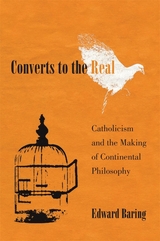 Converts to the Real: Catholicism and the Making of Continental Philosophy
Edward Baring
Harvard University Press, 2019 In the most wide-ranging history of phenomenology since Herbert Spiegelberg’s The Phenomenological Movement over fifty years ago, Baring uncovers a new and unexpected force—Catholic intellectuals—behind the growth of phenomenology in the early twentieth century, and makes the case for the movement’s catalytic intellectual and social impact.
Of all modern schools of thought, phenomenology has the strongest claim to the mantle of “continental” philosophy. In the first half of the twentieth century, phenomenology expanded from a few German towns into a movement spanning Europe. Edward Baring shows that credit for this prodigious growth goes to a surprising group of early enthusiasts: Catholic intellectuals. Placing phenomenology in historical context, Baring reveals the enduring influence of Catholicism in twentieth-century intellectual thought.
Converts to the Real argues that Catholic scholars allied with phenomenology because they thought it mapped a path out of modern idealism—which they associated with Protestantism and secularization—and back to Catholic metaphysics. Seeing in this unfulfilled promise a bridge to Europe’s secular academy, Catholics set to work extending phenomenology’s reach, writing many of the first phenomenological publications in languages other than German and organizing the first international conferences on phenomenology. The Church even helped rescue Edmund Husserl’s papers from Nazi Germany in 1938. But phenomenology proved to be an unreliable ally, and in debates over its meaning and development, Catholic intellectuals contemplated the ways it might threaten the faith. As a result, Catholics showed that phenomenology could be useful for secular projects, and encouraged its adoption by the philosophical establishment in countries across Europe and beyond.
Baring traces the resonances of these Catholic debates in postwar Europe. From existentialism, through the phenomenology of Paul Ricoeur and Maurice Merleau-Ponty, to the speculative realism of the present, European thought bears the mark of Catholicism, the original continental philosophy.
 The Convict and the Colonel: A Story of Colonialism and Resistance in the Caribbean
Richard Price
Duke University Press, 2006 An election day massacre in colonial Martinique. A “mad” artist who lives in a cave. A satirical wooden bust of a white colonel. The artist’s banishment to the Devil’s Island penal colony for “impertinence.” And a young anthropologist who arrives in Martinique in 1962, on the eve of massive modernization. In a stunning combination of scholarship and storytelling, the award-winning anthropologist Richard Price draws on long-term ethnography, archival documents, cinema and street theater, and Caribbean fiction and poetry to explore how one generation’s powerful historical metaphors could so quickly become the next generation’s trivial pursuit, how memories of oppression, inequality, and struggle could so easily become replaced by nostalgia, complicity, and celebration. “A superb callaloo of a book. . . . Richard Price has a remarkable grasp of the literatures of the Caribbean, and draws on this resource to explore the underlying insanity of the colonial experience, as well as the bewildering complexities of the postcolonial world where memory is erased or invented according to the demands of a market modernity.”—George Lamming, author of The Pleasures of Exile “By beautifully crafting elements as disparate as biographical data, sociological studies, literary sources, and archival documents, Richard Price’s research is more fascinating than a piece of fiction.”—Maryse Condé, author of I, Tituba, Black Witch of Salem “Price does it again. Mixing eras, genres, and voices, he carries the reader through the contradictory streams of historical consciousness in the Caribbean island of Martinique. The result is as complex and as enticing as the sea it evokes.”—Michel-Rolph Trouillot, author of Silencing the Past “Filled with insights that are at once theoretical, methodological, and ethnographic, The Convict and the Colonel is required reading for anyone interested in colonialism, memory, and contemporary Caribbean societies.”—Jennifer Cole, American Ethnologist
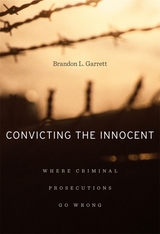 Convicting the Innocent: Where Criminal Prosecutions Go Wrong
Brandon L. Garrett
Harvard University Press, 2011 On January 20, 1984, Earl Washington—defended for all of forty minutes by a lawyer who had never tried a death penalty case—was found guilty of rape and murder in the state of Virginia and sentenced to death. After nine years on death row, DNA testing cast doubt on his conviction and saved his life. However, he spent another eight years in prison before more sophisticated DNA technology proved his innocence and convicted the guilty man.
DNA exonerations have shattered confidence in the criminal justice system by exposing how often we have convicted the innocent and let the guilty walk free. In this unsettling in-depth analysis, Brandon Garrett examines what went wrong in the cases of the first 250 wrongfully convicted people to be exonerated by DNA testing.
Based on trial transcripts, Garrett’s investigation into the causes of wrongful convictions reveals larger patterns of incompetence, abuse, and error. Evidence corrupted by suggestive eyewitness procedures, coercive interrogations, unsound and unreliable forensics, shoddy investigative practices, cognitive bias, and poor lawyering illustrates the weaknesses built into our current criminal justice system. Garrett proposes practical reforms that rely more on documented, recorded, and audited evidence, and less on fallible human memory.
Very few crimes committed in the United States involve biological evidence that can be tested using DNA. How many unjust convictions are there that we will never discover? Convicting the Innocent makes a powerful case for systemic reforms to improve the accuracy of all criminal cases.
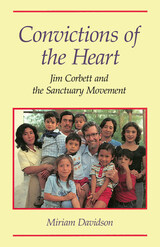 Convictions of the Heart: Jim Corbett and the Sanctuary Movement
Miriam Davidson
University of Arizona Press, 1988 The death of twenty-one Salvadoran refugees in the Arizona desert in 1980 made many Americans aware for the first time that people were struggling—and dying—to find political asylum in the United States. Tucsonan Jim Corbett first encountered the problem while attempting to help a hitchhiking refugee. What came of that act of altruism was a movement that spread across the country, challenged the federal government, and brought the refugee problem to national awareness.
Corbett first worked within the law to help refugees process applications for asylum, but the U.S. Immigration and Naturalization Service soon began a program of arrests; then he began to smuggle refugees from the Mexican border to the homes of citizens willing to provide shelter, making hundreds of trips over the next two years; finally he enlisted the support of the Tucson Ecumenical Council and persuaded John Fife, pastor of the Southside Presbyterian Church, to open that building as a refuge. When legal action against Corbett and the others seemed imminent, Southside became, on March 24, 1982, the first of two hundred churches in the country to declare itself a sanctuary.
Convictions of the Heart takes readers inside the santuary movement to reveal its founders' motives and underlying beliefs, and inside the courtroom to describe the government's efforts to stop it. Although the book addresses many points of view, its primary focus is on the philosophy of Jim Corbett. Rooted in the nonviolence of Gandhi, the Society of Friends, and Martin Luther King, Corbett's beliefs challenged individuals and communities of faith across the country to examine the strength of their commitment to the needs and rights of others.
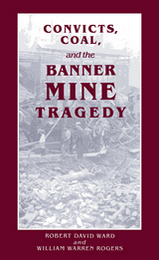 Convicts, Coal, and the Banner Mine Tragedy
Robert David Ward
University of Alabama Press, 1987 In the late 1870s, Jefferson County, Alabama, and the town of Elyton (near the future Birmingham) became the focus of a remarkable industrial and mining revolution. Together with the surrounding counties, the area was penetrated by railroads. Surprisingly large deposits of bituminous coal, limestone, and iron ore—the exact ingredients for the manufacture of iron and, later, steel—began to be exploited. Now, with transportation, modern extractive techniques, and capital, the region’s geological riches began yielding enormous profits. A labor force was necessary to maintain and expand the Birmingham area’s industrial boom. Many workers were native Alabamians. There was as well an immigrant ethnic work force, small but important. The native and immigrant laborers became problems for management when workers began affiliating with labor unions and striking for higher wages and better working conditions. In the wake of the management-labor disputes, the industrialists resorted to an artificial work force—convict labor. Alabama’s state and county officials sought to avoid expense and reap profits by leasing prisoners to industry and farms for their labor.
This book is about the men who worked involuntarily in the Banner Coal Mine, owned by the Pratt Consolidated Coal Company. And it is about the repercussions and consequences that followed an explosion at the mine in the spring of 1911 that killed 128 convict miners.
 The Convolutions of Historical Politics
Alexei Miller
Central European University Press, 2012 Thirteen essays by scholars from seven countries discuss the political use and abuse of history in the recent decades with particular focus on Central and Eastern Europe (Hungary, Poland, Estonia, Moldova, Ukraine, Russia as case studies), but also includes articles on Germany, Japan and Turkey, which provide a much needed comparative dimension. The main focus is on new conditions of political utilization of history in post-communist context, which is characterized by lack of censorship and political pluralism. The phenomenon of history politics became extremely visible in Central and Eastern Europe in the past decade, and remains central for political agenda in many countries of the regions. Each essay is a case study contributing to the knowledge about collective memory and political use of history, offering a new theoretical twist. The studies look at actors (from political parties to individual historians), institutions (museums, Institutes of National remembrance, special political commissions), methods, political rationale and motivations behind this phenomenon.
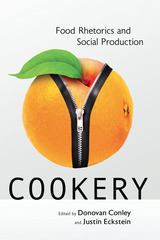 Cookery: Food Rhetorics and Social Production
Edited by Donovan Conley and Justin Eckstein
University of Alabama Press, 2020 The rhetoric of contemporary food production and consumption with a focus on social boundaries
The rhetoric of food is more than just words about food, and food is more than just edible matter. Cookery: Food Rhetorics and Social Production explores how food mediates both rhetorical influence and material life through the overlapping concepts of invention and production. The classical canon of rhetorical invention entails the process of discovering one’s persuasive appeals, whereas the contemporary landscape of agricultural production touches virtually everyone on the planet. Together, rhetoric and food shape the boundaries of shared living.
The essays in this volume probe the many ways that food informs contemporary social life through its mediation of bodies—human and extra-human alike—in the forms of intoxication, addiction, estrangement, identification, repulsion, and eroticism. Our bodies, in turn, shape the boundaries of food through research, technology, cultural trends, and, of course, by talking about it.
Each chapter explores food’s persuasive nature through a unique prism that includes intoxication, dirt, “food porn,” strange foods, and political “invisibility.” Each case offers new insights about the relations between rhetorical influence and embodied practice through food. As a whole Cookery articulates new ways of viewing food’s powers of persuasion, as well as the inherent role of persuasion in agricultural production.
The purpose of Cookery, then, is to demonstrate the deep rhetoricity of our modern industrial food system through critical examinations of concepts, practices, and tendencies endemic to this system. Food has become an essential topic for discussions concerned with the larger social dynamics of production, distribution, access, reception, consumption, influence, and the fraught question of choice. These questions about food and rhetoric are equally questions about the assumptions, values, and practices of contemporary public life.
 The Cookie Jar and Other Plays
John Clark DonahueLinda Walsh Jenkins, Editor
University of Minnesota Press, 1975 The Cookie Jar and Other Plays was first published in 1975. Minnesota Archive Editions uses digital technology to make long-unavailable books once again accessible, and are published unaltered from the original University of Minnesota Press editions. The scripts of three plays by John Clark Donahue, artistic director of the Children's Theatre Company of the Minneapolis Society of Fine Arts, are published in this volume along with background material and illustrations which, together, provide a look behind the scenes at the company, its personnel, methods, and productions. The company, which has achieved notable success, is regarded as a leading exponent of children's theater in this country. The plays included in this volume are The Cookie Jar, How Could You Tell?,and Old King of Malfi.All by been presented by the Children's Theatre Company. Linda Walsh Jenkins provides an introduction and commentary on the plays. There are also a profile of John Donahue and material based on interviews with him and with other theater personnel — directors, composers, designers, and others. This and other information, including a sketch of the history and background of the Children's Theatre Company, will be illuminating and helpful to other theater groups and individuals interested in the development of children's theater. There are sixteen pages of photographs, including four pages in color, showing scenes from Children's Theatre Company productions of the plays. Examples from the musical scores composed for the productions are also reproduced. Under Mr. Donahue's direction the company has evolved an ensemble approach to production, in which script, music, and acting develop simultaneously throughout the rehearsal period. The dominant theme in his work with the company has been an educational one, based on his belief that the theater should be an educational environment which helps young persons to develop their creative abilities.
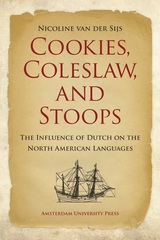 Cookies, Coleslaw, and Stoops: The Influence of Dutch on the North American Languages
Nicoline van der Sijs
Amsterdam University Press, 2010 In 1609, the first Dutch settlers arrived in America and established trading posts, small towns, and forts up and down what we now call the Hudson River. To this day, American children are taught the thrilling history of the transformation of this settlement, New Netherland, and its capital, New Amsterdam, from landmark port into present-day New York State and the island of Manhattan. But, the Dutch legacy extended far beyond New York, as Cookies, Coleslaw and Stoops reveals.
From Santa Claus (after the Dutch folklore saint Sinterklaas) and his sleigh (the pronunciation of the Dutch slee is almost identical) to a dumbhead talking poppycock, the contributions of the Dutch language to American English are indelibly embedded to some of our most vernacular terms and expressions. The menu in most of our restaurants sports some originally Dutch names, and even our dollar is named after a Dutch coin (daalder). In this captivating volume, the renowned linguist Nicoline van der Sijs glosses over 300 Dutch loan words like these that travelled to the New World on board the Dutch ship the Halve Maan, captained by Henry Hudson, which dropped anchor in Manhattan more than 400 years ago. Surprisingly, the Dutch also gave several Native American languages words for everyday things like “pants”, “cat” and “turkey”. Lively and accessible, the information presented in this volume charts the journey of these words into the American territory and languages, from more obscure uses which maybe have survived in only regional dialects to such ubiquitous contributions to our language like Yankee, cookie, and dope. Each entry marks the original arrival of its term into American English and adds up-to-date information on its evolving meaning, etymology, and regional spread. Not to be missed by anyone with a passion for the history behind our everyday expressions, Cookies, Coleslaw and Stoops is the perfect gift for the linguistic adventurer in us all.
Cooking by the Book: Food in Literature and Culture
Edited by Mary Anne Schofield
University of Wisconsin Press, 1989 The essays collected here explore the power and sensuality that food engenders within literature. The book permits the reader to sample food as a rhetorical structure, one that allows the individual writers to articulate the abstract concepts in a medium that is readily understandable.
The second part of Cooking by the Book turns to the more diverse food rhetorics of the marketplace. What, for example, is the fast food rhetoric? Why are there so many eating disorders in our society? Is it possible to teach philosophy through cookery? How long has vegetarianism been popular?
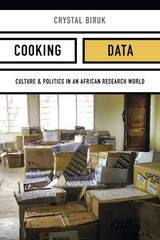 Cooking Data: Culture and Politics in an African Research World
Cal (Crystal) Biruk
Duke University Press, 2018 In Cooking Data Cal Biruk offers an ethnographic account of research into the demographics of HIV and AIDS in Malawi to rethink the production of quantitative health data. While research practices are often understood within a clean/dirty binary, Biruk shows that data are never clean; rather, they are always “cooked” during their production and inevitably entangled with the lives of those who produce them. Examining how the relationships among fieldworkers, supervisors, respondents, and foreign demographers shape data, Biruk examines the ways in which units of information—such as survey questions and numbers written onto questionnaires by fieldworkers—acquire value as statistics that go on to shape national AIDS policy. Her approach illustrates how on-the-ground dynamics and research cultures mediate the production of global health statistics in ways that impact local economies and formulations of power and expertise.
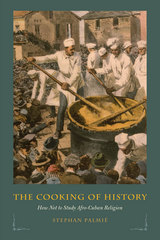 The Cooking of History: How Not to Study Afro-Cuban Religion
Stephan Palmié
University of Chicago Press, 2013 Over a lifetime of studying Cuban Santería and other religions related to Orisha worship—a practice also found among the Yoruba in West Africa—Stephan Palmié has grown progressively uneasy with the assumptions inherent in the very term Afro-Cuban religion. In The Cooking of History he provides a comprehensive analysis of these assumptions, in the process offering an incisive critique both of the anthropology of religion and of scholarship on the cultural history of the Afro-Atlantic World. Understood largely through its rituals and ceremonies, Santería and related religions have been a challenge for anthropologists to link to a hypothetical African past. But, Palmié argues, precisely by relying on the notion of an aboriginal African past, and by claiming to authenticate these religions via their findings, anthropologists—some of whom have converted to these religions—have exerted considerable influence upon contemporary practices. Critiquing widespread and damaging simplifications that posit religious practices as stable and self-contained, Palmié calls for a drastic new approach that properly situates cultural origins within the complex social environments and scholarly fields in which they are investigated.
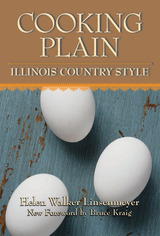 Cooking Plain, Illinois Country Style
Helen Walker Linsenmeyer
Southern Illinois University Press, 1976 Cooking Plain, Illinois Country Style by Helen Walker Linsenmeyer presents a collection of family recipes created prior to 1900 and perfected from generation to generation, mirroring the delicious and distinctive kind of cookery produced by the mix of people who settled the Illinois Country during this period. Some recipes reflect a certain New England or Southern influence, while others echo a European heritage. All hark back to a simpler style of living, when cooking was plain yet flavorful. The recipes specify the use of natural ingredients (including butter, lard, and suet) rather than synthetic or ready-mixed foods, which were unavailable in the 1800s. Cooking at the time was pure and unadulterated, and portions were large. Strength-giving food was essential to health and endurance; thus fare was pure, hearty, flavorful, and wholesome. The many treasures of Cooking Plain, Illinois Country Style include • basic recipes for mead, originally served to the militiamen of Jackson County; sumac lemonade, made the Indian way; root beer, as it was originally made; • soups of many kinds—from wholesome vegetable to savory sorrel leaf, enjoyed by the Kaskaskia French; • old-fashioned fried beefsteak, classic American pot roast and gravy, as well as secret marinades to tenderize the tougher but more flavorful cuts of meat; • methods for preparing and cooking rabbit, squirrel, wild turkey, venison, pheasant, rattlesnake, raccoon, buffalo, and fish; • over one hundred recipes for wheat breads, sweet breads, corn breads, and pancakes; • an array of delectable desserts and confections, including puddings, ice cream, taffy, and feathery-light cakes and pies; • sections on the uses of herbs, spices, roots, and weeds; instructions for making sausage, jerky, and smoked fish and for drying one’s own fruits and vegetables; and household hints on everything from making lye soap to cooking for the sick. And there are extra-special nuggets, too, for Mrs. Linsenmeyer laces her cookbook with interesting biographical notes on a number of the settlers and the origin of many of the foods they used. There is also a wealth of historical information on lifestyles and cooking before 1900, plus helpful tips on the use of old-fashioned cooking utensils. A working cookbook complete in its coverage of every area of food preparation, Cooking Plain, Illinois Country Style will be used and treasured as much today as its recipes were by families of an earlier century. The recipes are not gourmet, but they are certain to please today’s cooks, especially those interested in using local ingredients and getting back to a more natural way of cooking and eating.
 Cooking Texas Style: Traditional Recipes from the Lone Star State
By Candy Wagner and Sandra Marquez
University of Texas Press, 2013 Just remembering the crispy fried chicken and luscious peach cobblers a grandmother or aunt used to make can set your mouth watering. And since remembering is no substitute for eating, cooks across the country have turned to Cooking Texas Style to find recipes for the comfort foods we love best. Thirty years after its first publication, popular acclaim has made this collection of favorite family recipes the standard source for traditional Texas cooking. Here are over three hundred tasty recipes from the kitchens of Candy Wagner and Sandra Marquez. You’ll find classic Texas dishes such as chicken-fried steak, barbecue, chili, guacamole, and cornbread hot with jalapeños, as well as novel, exciting ways to prepare old favorites such as Tortilla Soup, Fajitas, and Chicken and Dumplings. Organized for easy reference, all the recipes are clearly explained, simple to prepare, and simply delicious. Cooking Texas Style is an invaluable addition to the kitchen bookshelf of anyone interested in cooking—and eating—Texas style.
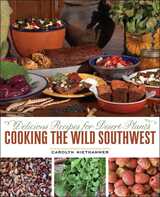 Cooking the Wild Southwest: Delicious Recipes for Desert Plants
Carolyn Niethammer, Illustrations by Paul Mirocha
University of Arizona Press, 2011 Over the last few decades, interest in eating locally has grown quickly. From just-picked apples in Washington to fresh peaches in Georgia, local food movements and farmer’s markets have proliferated all over the country. Desert dwellers in the Southwest are taking a new look at prickly pear, mesquite, and other native plants.
Many people’s idea of cooking with southwestern plants begins and ends with prickly pear jelly. With this update to the classic Tumbleweed Gourmet, master cook Carolyn Niethammer opens a window on the incredible bounty of the southwestern deserts and offers recipes to help you bring these plants to your table. Included here are sections featuring each of twenty-three different desert plants. The chapters include basic information, harvesting techniques, and general characteristics. But the real treat comes in the form of some 150 recipes collected or developed by the author herself. Ranging from every-day to gourmet, from simple to complex, these recipes offer something for cooks of all skill levels. Some of the recipes also include stories about their origin and readers are encouraged to tinker with the ingredients and enjoy desert foods as part of their regular diet.
Featuring Paul Mirocha’s finely drawn illustrations of the various southwestern plants discussed, this volume will serve as an indispensible guide from harvest to table. Whether you’re looking for more ways to prepare local foods, ideas for sustainable harvesting, or just want to expand your palette to take in some out-of-the-ordinary flavors, Cooking the Wild Southwest is sure to delight.
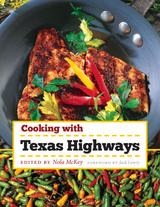 Cooking with Texas Highways
Edited by Nola McKey
University of Texas Press, 2005 Whether you're hungry for down-home barbecue and Tex-Mex, or you want to try more exotic dishes such as Paella Valenciana and Thai Pesto, Texas Highways has long been a trusted source for delicious recipes that reflect wide-ranging Lone Star tastes. The state's official travel magazine published its first Texas Highways Cookbook, which has sold 20,000 copies, in 1986. Responding to the public's demand for a new collection of the magazine's recipes, the editors are pleased to bring you Cooking with Texas Highways, a compilation of more than 250 recipes that are as richly diverse and flavorful as Texas itself. Cooking with Texas Highways samples all the major ethnic cuisines of the state with recipes from home cooks, well-known chefs, and popular restaurants. It offers a varied and intriguing selection of snacks and beverages, breads, soups and salads, main dishes, vegetables and sides, sauces and spreads, desserts, and more. A special feature of this cookbook is a chapter on Dutch-oven cooking, which covers all the basics for cooking outdoors with live coals, including seventeen mouth-watering recipes. In addition, you'll find dozens of the lovely color photographs that have long made Texas Highways such a feast for the eyes, along with tips on cooking techniques and sources for ingredients and stories about some of the folks who created the recipes. If you want to sample all the tastes of Texas, there's no better place to start than Cooking with Texas Highways.
A Cook's Tour of Iowa
Susan Puckett
University of Iowa Press, 1990 No other cookbook provides such a vivid portrait of our state while satisfying even the most discerning tastebuds. Putting to rest the myth that Iowa's cuisine is bland and boring, Puckett reveals its distinctly delicious foodways—as mouth watering and unexpected as they are wholesome.
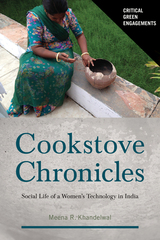 Cookstove Chronicles: Social Life of a Women’s Technology in India
Meena R. Khandelwal
University of Arizona Press, 2024 Stove improvers have been designing and promoting “clean” or “efficient” biomass cookstoves in India since the 1940s and have been frustrated to find their carefully engineered stoves abandoned in trash heaps or repurposed as storage bins, while the traditional mud chulha retains a central place in the kitchen. Why do so many Indian women continue to use wood-burning, smoke-spewing stoves when they have other options?
Based on anthropological research in Rajasthan, Cookstove Chronicles argues that the supposedly obsolete chulha persists because it offers women control over the tools needed to feed their families. Their continued use of old stoves alongside the new is not a failure to embrace new technologies but instead a strategy to maximize flexibility and autonomy. The chulha is neither the villain nor hero of this story. It produces particulate matter that harms people’s bodies, leaves soot on utensils and walls, and accelerates glacial melting and atmospheric warming. Yet it also depends on renewable biomass fuel and supports women’s autonomy as a local, do-it-yourself technology.
Meena Khandelwal, a feminist anthropologist, describes her collaboration with engineers, archaeologists, and others. She employs critical social theory and reflections from fieldwork to bring together research from a range of fields, including history, geography, anthropology, energy and environmental studies, public health, and science and technology studies (STS). In so doing she not only demystifies multidisciplinary research but also highlights the messy reality of actual behavior.
Cookstove Chronicles critically examines why, despite extensive development efforts, use of the chulha persists. It offers an important new framework for looking at development, technology, environmental change, and human behavior.
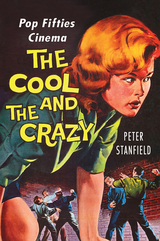 The Cool and the Crazy: Pop Fifties Cinema
Stanfield, Peter
Rutgers University Press, 2015 Explosive! Amazing! Terrifying! You won’t believe your eyes! Such movie taglines were common in the 1950s, as Hollywood churned out a variety of low-budget pictures that were sold on the basis of their sensational content and topicality. While a few of these movies have since become canonized by film fans and critics, a number of the era’s biggest fads have now faded into obscurity. The Cool and the Crazy examines seven of these film cycles, including short-lived trends like boxing movies, war pictures, and social problem films detailing the sordid and violent life of teenagers, as well as uniquely 1950s takes on established genres like the gangster picture.
Peter Stanfield reveals how Hollywood sought to capitalize upon current events, moral panics, and popular fads, making movies that were “ripped from the headlines” on everything from the Korean War to rock and roll. As he offers careful readings of several key films, he also considers the broader historical and commercial contexts in which these films were produced, marketed, and exhibited. In the process, Stanfield uncovers surprising synergies between Hollywood and other arenas of popular culture, like the ways that the fashion trend for blue jeans influenced the 1950s Western.
Delivering sharp critical insights in jazzy, accessible prose, The Cool and the Crazy offers an appreciation of cinema as a “pop” medium, unabashedly derivative, faddish, and ephemeral. By studying these long-burst bubbles of 1950s “pop,” Stanfield reveals something new about what films do and the pleasures they provide.
Cool Capitalism
Jim McGuigan
Pluto Press, 2009 Thomas Frank coined the term ‘the conquest of cool’. This book shows how this conquest is at the heart of the dynamics of contemporary capitalism.
Jim McGuigan argues that 'cool capitalism' incorporates disaffection into capitalism itself, absorbing rebellion and thereby neutralising opposition to the present system of culture and society.
McGuigan explores a huge variety of cultural examples, from the sleek images of mainstream advertising, to the fringes of artistic production, offering a vigourous critique of our understanding of subversion, resistance and counter-culturalism.
Has capitalism really colonised our planet? McGuigan shows that there is still some space left for rebellion against the seductive power of the free market economy.
 Cool Characters: Irony and American Fiction
Lee Konstantinou
Harvard University Press, 2016 Charting a new course in the criticism of postwar fiction, Cool Characters examines the changing status of irony in American cultural and political life from World War II to the present, showing how irony migrated from the countercultural margins of the 1950s to the cultural mainstream of the 1980s. Along the way, irony was absorbed into postmodern theory and ultimately became a target of recent writers who have sought to create a practice of “postirony” that might move beyond its limitations.
As a concept, irony has been theorized from countless angles, but Cool Characters argues that it is best understood as an ethos: an attitude or orientation toward the world, embodied in different character types, articulated via literary style. Lee Konstantinou traces five such types—the hipster, the punk, the believer, the coolhunter, and the occupier—in new interpretations of works by authors including Ralph Ellison, William S. Burroughs, Thomas Pynchon, Kathy Acker, Dave Eggers, William Gibson, Jennifer Egan, Jonathan Lethem, and Rachel Kushner.
For earlier generations of writers, irony was something vital to be embraced, but beginning most dramatically with David Foster Wallace, dissatisfaction with irony, especially with its alleged tendency to promote cynicism and political passivity, gained force. Postirony—the endpoint in an arc that begins with naive belief, passes through irony, and arrives at a new form of contingent conviction—illuminates the literary environment that has flourished in the United States since the 1990s.
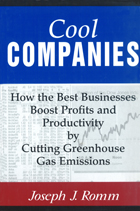 Cool Companies: How the Best Businesses Boost Profits and Productivity by Cutting Greenhouse-Gas Emissions
Joseph J. Romm
Island Press, 1999 Despite ongoing negotiations, consensus has not yet been reached on what action will be taken to combat global warming. A number of companies have looked beyond the current stalemate to see the prospect of reducing greenhouse-gas emissions not as a roadblock to growth and innovation but as a unique opportunity to increase profits and productivity. These "cool" companies understand the strategic importance of reducing heat-trapping emissions and have worked to cut their emissions by fifty percent or more. In the process, they have not only reduced their energy bill, but have increased their productivity, sometimes dramatically. In Cool Companies, energy expert Joseph Romm describes the experiences of these remarkable firms, as he presents more than fifty case studies in which bottom line improvements have been achieved by improving processes, increasing energy efficiency, and adopting new technologies. Romm places efforts to reduce emissions in the context of proven corporate strategies, showing managers how they can build or retrofit their operations with the latest technologies to reduce emissions and achieve quick returns on the investment. Case studies explain: - the concept of "lean production" and why systematic efforts to reduce emissions so often lead to productivity gains
- how changes in office and building design can significantly increase productivity, greatly compounding gains achieved from increased energy efficiency
- options for "cool" power -- from cogeneration to solar, wind, and geothermal energy
- energy efficiency in manufacturing, including motors and motor systems, steam, and process energy
In profiling successful companies such as DuPont, 3M, Compaq, Xerox, Toyota, Verifone, Perkin-Elmer, and Centerplex, among many others, Cool Companies turns on its head the notion that the effort to combat global warming will come with massive costs to the industrial sector. It is a unique and essential business book for anyone concerned with increasing profits and productivity while reducing greenhouse gas emissions.
 Cool Memories II, 1987-1990
Jean Baudrillard
Duke University Press, 1996 Jean Baudrillard is widely recognized as one of the most important and provocative writers of our age. Variously termed “France’s leading philosopher of postmodernism” and “a sharp-shooting Lone Ranger of the post-Marxist left,” he might also be called our leading philosopher of seduction or of mass culture. Following his acclaimed America and Cool Memories, this book is the third in a series of personal records in hyperreality. Idiosyncratic, outrageous, and brilliantly original, Baudrillard here casts his net widely and combines autobiographical memories with further reflections on America, the crisis of cultural production, new ideas in fiction/theory, and the “verbal fornication” of the postmodern.
In this wide-ranging discussion of events and ideas, Baudrillard moves between poetry and waterfalls, strikes and stealth bombers, Freud and La Cicciolina, shadows and simulacra, deconstruction and the zodiac, Reagan’s smile and Kennedy’s death, the “curse” on South America and the future of the West, the last tango of French intellectual life and the exemplary disappearing act of Italian politics. Writing at the site where the philosophic and the poetic merge, he once again offers us commentary in the form of the riveting insight, the short distillation of reality that establishes its truth with the force of recognition.
Cool Memories II, Baudrillard’s latest commentary on the technopresent and future, an installment of his reflections on the reality of contemporary western culture, will entice all readers concerned with postmodernism and the current state of theory.
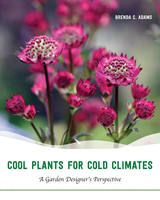 Cool Plants for Cold Climates: A Garden Designer's Perspective
Brenda C. Adams
University of Alaska Press, 2017 A cold climate is no excuse for a dull, colorless garden. The key is knowing the right plants that will survive and thrive in even the chilliest environments. Who better to guide gardeners than an expert from the far north? Award-winning designer and Alaska gardener Brenda Adams has spent decades searching for exceptional plants that flourish in wintery climates. In Cool Plants for Cold Climates, she presents vivid and detailed portraits of the best and most beautiful of the bunch.
When Adams moved from the warm Southwest to Alaska, she found herself in a different gardening world, with few guides on how to approach this new ecosystem. Now, more than twenty-five years later, she shares the secrets gained from her years of gardening experiments as well as bountiful advice from friends and local nurseries. She explains how to evaluate a plant, balancing its artistic attributes with its more utilitarian ones, as well as how to evaluate your space and soil. Adams then takes you into the nursery, offering guidance on how to pick the best of the best. Finally, she offers a detailed look at a wide variety of wonderful plants, highlighting those that offer overall beauty, are especially easy to care for, and solidly hardy. With more than three hundred vivid pictures of both individual plants and full gardens, Adams proves that there is a bounty of plants, in a rainbow of colors, waiting to brighten up your space.
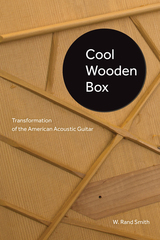 Cool Wooden Box: Transformation of the American Acoustic Guitar
W. Rand Smith
University of Tennessee Press, 2023 “In Cool Wooden Box, Rand Smith has cleverly woven person, social, and musical histories into a compelling narrative. In doing so, Smith has illustrated just how, well, cool the steel string acoustic guitar, its makers, and its players are.” —John Thomas, author of Kalamazoo Gals: A Story of Extraordinary Women and Gibson’s “Banner” Guitars of WWII, and field editor for The Fretboard Journal
Beginning with a comparison of the American acoustic guitar world in the early 1960s with that of today, then describing iconic performances at storied venues such as The Ark in Ann Arbor while meticulously researching the instrument’s top makers, Smith assembles a passion-filled and eye-opening history of that “cool wooden box” from the folk era through the pandemic. The author focuses on both the playing and making of the acoustic guitar, concluding that the instrument has been transformed in both aspects during the last sixty years. On the playing side, Smith examines the influences on, and the impact of, such guitarists as David Bromberg, Elizabeth Cotten, Paul Geremia, and Norman Blake. On the making side, the author takes the reader into the tradition-minded yet dynamic world of lutherie. He traces how the oldest, most revered companies whose reputations are based on legendary breakthroughs in lutherie, Gibson and Martin, have adapted as the new lutherie movement of innovative small-scale producers, exemplified by interviewees such as Michael Gurian, Bill Collings, Richard Hoover, and Dana Bourgeois, arose. Starting small and then growing exponentially, Taylor Guitars is a wholly different “player” in acoustic guitar building, and Smith compellingly tells its story. Finally, Cool Wooden Box considers the effects of globalization on the industry. Clocking thousands of miles and hours of interviews with guitar makers, suppliers, and sellers, W. Rand Smith has created not only a detailed history of the acoustic guitar, but also a lasting tribute to an instrument he so clearly reveres.
 Cooler Smarter: Practical Steps for Low-Carbon Living
The Union of Concerned Scientists
Island Press, 2012 How can each of us live Cooler Smarter? While the routine decisions that shape our days—what to have for dinner, where to shop, how to get to work—may seem small, collectively they have a big effect on global warming. But which changes in our lifestyles might make the biggest difference to the climate? This science-based guide shows you the most effective ways to cut your own global warming emissions by twenty percent or more, and explains why your individual contribution is so vital to addressing this global problem.
Cooler Smarter is based on an in-depth, two-year study by the experts at The Union of Concerned Scientists. While other green guides suggest an array of tips, Cooler Smarter offers proven strategies to cut carbon, with chapters on transportation, home energy use, diet, personal consumption, as well as how best to influence your workplace, your community, and elected officials. The book explains how to make the biggest impact and when not to sweat the small stuff. It also turns many eco-myths on their head, like the importance of locally produced food or the superiority of all hybrid cars.
The advice in Cooler Smarter can help save you money and live healthier. But its central purpose is to empower you, through low carbon-living, to confront one of society’s greatest threats.
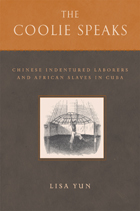 The Coolie Speaks: Chinese Indentured Laborers and African Slaves in Cuba
Lisa Yun
Temple University Press, 2009 Introducing radical counter-visions of race and slavery, and probing the legal and philosophical questions raised by indenture, The Coolie Speaks offers the first critical reading of a massive testimony case from Cuba in 1874. From this case, Yun traces the emergence of a "coolie narrative" that forms a counterpart to the "slave narrative." The written and oral testimonies of nearly 3,000 Chinese laborers in Cuba, who toiled alongside African slaves, offer a rare glimpse into the nature of bondage and the tortuous transition to freedom. Trapped in one of the last standing systems of slavery in the Americas, the Chinese described their hopes and struggles, and their unrelenting quest for freedom. Yun argues that the testimonies from this case suggest radical critiques of the "contract" institution, the basis for free modern society. The example of Cuba, she suggests, constitutes the early experiment and forerunner of new contract slavery, in which the contract itself, taken to its extreme, was wielded as a most potent form of enslavement and complicity. Yun further considers the communal biography of a next-generation Afro-Chinese Cuban author and raises timely theoretical questions regarding race, diaspora, transnationalism, and globalization.
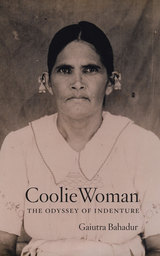 Coolie Woman: The Odyssey of Indenture
Gaiutra Bahadur
University of Chicago Press, 2013 In 1903, a young woman sailed from India to Guiana as a “coolie”—the British name for indentured laborers who replaced the newly emancipated slaves on sugar plantations all around the world. Pregnant and traveling alone, this woman, like so many coolies, disappeared into history. In Coolie Woman—shortlisted for the 2014 Orwell Prize—her great-granddaughter Gaiutra Bahadur embarks on a journey into the past to find her. Traversing three continents and trawling through countless colonial archives, Bahadur excavates not only her great-grandmother’s story but also the repressed history of some quarter of a million other coolie women, shining a light on their complex lives.
Shunned by society, and sometimes in mortal danger, many coolie women were either runaways, widows, or outcasts. Many of them left husbands and families behind to migrate alone in epic sea voyages—traumatic “middle passages”—only to face a life of hard labor, dismal living conditions, and, especially, sexual exploitation. As Bahadur explains, however, it is precisely their sexuality that makes coolie women stand out as figures in history. Greatly outnumbered by men, they were able to use sex with their overseers to gain various advantages, an act that often incited fatal retaliations from coolie men and sometimes larger uprisings of laborers against their overlords. Complex and unpredictable, sex was nevertheless a powerful tool.
Examining this and many other facets of these remarkable women’s lives, Coolie Woman is a meditation on survival, a gripping story of a double diaspora—from India to the West Indies in one century, Guyana to the United States in the next—that is at once a search for one’s roots and an exploration of gender and power, peril and opportunity.
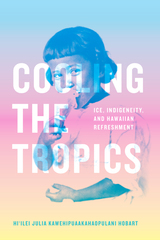 Cooling the Tropics: Ice, Indigeneity, and Hawaiian Refreshment
Hi'ilei Julia Kawehipuaakahaopulani Hobart
Duke University Press, 2023 Beginning in the mid-1800s, Americans hauled frozen pond water, then glacial ice, and then ice machines to Hawaiʻi—all in an effort to reshape the islands in the service of Western pleasure and profit. Marketed as “essential” for white occupants of the nineteenth-century Pacific, ice quickly permeated the foodscape through advancements in freezing and refrigeration technologies. In Cooling the Tropics Hiʻilei Julia Kawehipuaakahaopulani Hobart charts the social history of ice in Hawaiʻi to show how the interlinked concepts of freshness and refreshment mark colonial relationships to the tropics. From chilled drinks and sweets to machinery, she shows how ice and refrigeration underpinned settler colonial ideas about race, environment, and the senses. By outlining how ice shaped Hawaiʻi’s food system in accordance with racial and environmental imaginaries, Hobart demonstrates that thermal technologies can—and must—be attended to in struggles for food sovereignty and political self-determination in Hawaiʻi and beyond.
Duke University Press Scholars of Color First Book Award Recipient
Coon Mountain Controversies: Meteor Crater and the Development of Impact Theory
William Graves Hoyt
University of Arizona Press, 1987 Blends the scientific issues, the commercial and legal factors, and the personalities involved into a sure-footed narrative that never fails to hold the reader's interest. . . . it is difficult to imagine a more carefully documented and sensibly reasoned account of the way in which ideas on impact theory evolved. . . . of considerable, and probably lasting, value.—Nature
"This meticulously prepared and lucidly written work will surely prove the definitive account of one of the most stimulating intellectual confrontations in the whole history of the earth and planetary sciences. I can recommend it without reservation."—William A. S. Sarjeant,Geoscience Canada
"An important book by an extraordinary author, of interest to anyone fascinated by the ways in which unorthodox science becomes part of conventional wisdom."—Earth Sciences History
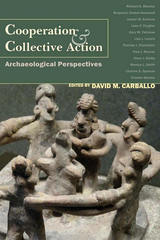 Cooperation and Collective Action: Archaeological Perspectives
David M. Carballo
University Press of Colorado, 2013 Past archaeological literature on cooperation theory has emphasized competition's role in cultural evolution. As a result, bottom-up possibilities for group cooperation have been under theorized in favor of models stressing top-down leadership, while evidence from a range of disciplines has demonstrated humans to effectively sustain cooperative undertakings through a number of social norms and institutions. Cooperation and Collective Action is the first volume to focus on the use of archaeological evidence to understand cooperation and collective action. Disentangling the motivations and institutions that foster group cooperation among competitive individuals remains one of the few great conundrums within evolutionary theory. The breadth and material focus of archaeology provide a much needed complement to existing research on cooperation and collective action, which thus far has relied largely on game-theoretic modeling, surveys of college students from affluent countries, brief ethnographic experiments, and limited historic cases. In Cooperation and Collective Action, diverse case studies address the evolution of the emergence of norms, institutions, and symbols of complex societies through the last 10,000 years. This book is an important contribution to the literature on cooperation in human societies that will appeal to archaeologists and other scholars interested in cooperation research.
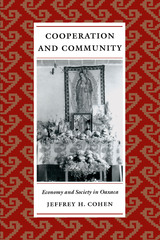 Cooperation and Community: Economy and Society in Oaxaca
By Jeffrey H. Cohen
University of Texas Press, 2000 In the villages and small towns of Oaxaca, Mexico, as in much of rural Latin America, cooperation among neighbors is essential for personal and community survival. It can take many forms, from godparenting to sponsoring fiestas, holding civic offices, or exchanging agricultural or other kinds of labor. This book examines the ways in which the people of Santa Ana del Valle practice these traditional cooperative and reciprocal relationships and also invent new relationships to respond to global forces of social and economic change at work within their community. Based on fieldwork he conducted in this Zapotec-speaking community between 1992 and 1996, Jeffrey Cohen describes continuities in the Santañeros' practices of cooperation, as well as changes resulting from transnational migration, tourism, increasing educational opportunities, and improved communications. His nuanced portrayal of the benefits and burdens of cooperation is buttressed by the words of many villagers who explain why and how they participate-or not-in reciprocal family and community networks. This rich ethnographic material offers a working definition of community created in and through cooperative relationships.
Cooperation and Dependence in Belarus-Russia Relations
Dara Massicot
RAND Corporation, 2024 The authors examine areas of convergence and divergence in the Belarus-Russia relationship, particularly regarding foreign and domestic policies, military and security cooperation, and economic and defense industrial ties. They also consider the regional perspectives of Belarus’s neighbors—Latvia, Lithuania, Poland, and Ukraine—and how the Belarus-Russia relationship poses an evolving threat to those countries’ security.
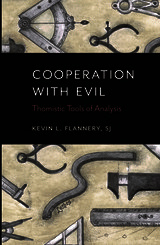 Cooperation with Evil: Thomistic Tools of Analysis
Kevin L. Flannery, SJ
Catholic University of America Press, 2019 Contemporary society very often asks of individuals and/or corporate entities that they perform actions connected in some way with the immoral actions of other individuals or entities. Typically, in the attempt to determine what would be unacceptable cooperation with such immoral actions, Christian scholars and authorities refer to the distinction, which appears in the writings of Alphonsus Liguori, between material and formal cooperation, the latter being connected in some way with the cooperator's intention in so acting. While expressing agreement with most of Alphonsus's determinations in these regards, Cooperation with Evil also argues that the philosophical background to these determinations often lacks coherence, especially when compared to related passages in the writings of Thomas Aquinas.
Having compared the philosophical approaches of these two great moralists, Cooperation with Evil then describes a number of ideas in Thomas's writings that might serve as more effective tools for the analysis of cases of possible immoral cooperation. The book also includes, as appendixes, translations of relevant passages in both Alphonsus and Thomas.
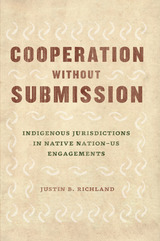 Cooperation without Submission: Indigenous Jurisdictions in Native Nation–US Engagements
Justin B. Richland
University of Chicago Press, 2021 A meticulous and thought-provoking look at how Tribes use language to engage in "cooperation without submission."
It is well-known that there is a complicated relationship between Native American Tribes and the US government. Relations between Tribes and the federal government are dominated by the principle that the government is supposed to engage in meaningful consultations with the tribes about issues that affect them.
In Cooperation without Submission, Justin B. Richland, an associate justice of the Hopi Appellate Court and ethnographer, closely examines the language employed by both Tribes and government agencies in over eighty hours of meetings between the two. Richland shows how Tribes conduct these meetings using language that demonstrates their commitment to nation-to-nation interdependency, while federal agents appear to approach these consultations with the assumption that federal law is supreme and ultimately authoritative. In other words, Native American Tribes see themselves as nations with some degree of independence, entitled to recognition of their sovereignty over Tribal lands, while the federal government acts to limit that authority. In this vital book, Richland sheds light on the ways the Tribes use their language to engage in “cooperation without submission.”
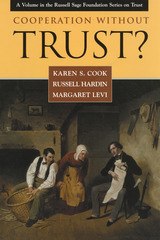 Cooperation Without Trust?
Karen S. Cook
Russell Sage Foundation, 2005 Some social theorists claim that trust is necessary for the smooth functioning of a democratic society. Yet many recent surveys suggest that trust is on the wane in the United States. Does this foreshadow trouble for the nation? In Cooperation Without Trust? Karen Cook, Russell Hardin, and Margaret Levi argue that a society can function well in the absence of trust. Though trust is a useful element in many kinds of relationships, they contend that mutually beneficial cooperative relationships can take place without it. Cooperation Without Trust? employs a wide range of examples illustrating how parties use mechanisms other than trust to secure cooperation. Concerns about one's reputation, for example, could keep a person in a small community from breaching agreements. State enforcement of contracts ensures that business partners need not trust one another in order to trade. Similarly, monitoring worker behavior permits an employer to vest great responsibility in an employee without necessarily trusting that person. Cook, Hardin, and Levi discuss other mechanisms for facilitating cooperation absent trust, such as the self-regulation of professional societies, management compensation schemes, and social capital networks. In fact, the authors argue that a lack of trust—or even outright distrust—may in many circumstances be more beneficial in creating cooperation. Lack of trust motivates people to reduce risks and establish institutions that promote cooperation. A stout distrust of government prompted America's founding fathers to establish a system in which leaders are highly accountable to their constituents, and in which checks and balances keep the behavior of government officials in line with the public will. Such institutional mechanisms are generally more dependable in securing cooperation than simple faith in the trustworthiness of others. Cooperation Without Trust? suggests that trust may be a complement to governing institutions, not a substitute for them. Whether or not the decline in trust documented by social surveys actually indicates an erosion of trust in everyday situations, this book argues that society is not in peril. Even if we were a less trusting society, that would not mean we are a less functional one. A Volume in the Russell Sage Foundation Series on Trust
Cooperative Intelligent Transport Systems: Towards high-level automated driving
Meng Lu
The Institution of Engineering and Technology, 2019 Intelligent Transport Systems (ITS) have been a domain of substantial development for more than thirty years, enhancing safety, (energy and fuel) efficiency, comfort, and economic growth. Cooperative Intelligent Transport Systems (C-ITS), also referred to as Connected Vehicles, are a prelude to, and pave the way towards road transport automation. Vehicle connectivity and information exchange will be an important asset for future highly-automated driving. The book provides a comprehensive insight in the state of the art of C-ITS and automated driving, especially addresses the important role of ICT (Information and Communication Technologies) infrastructure, and presents the main achievements (both theory and practice), as well as the challenges in the domain in Europe, the US and Asia/Pacific.
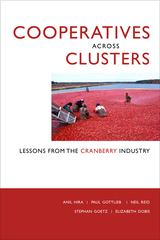 Cooperatives across Clusters: Lessons from the Cranberry Industry
Anil Hira
Oregon State University Press, 2024 Most agricultural production is of commodity or undifferentiated products. Producers suffer from a roller-coaster ride of price swings, over- or under-production, weather and pest threats, and the inability of family famers to capture anything beyond a small percentage of the final price. Cooperatives Across Clusters provides lessons from the cranberry industry, a commodity product organized mostly into family farms in seven different clusters around North America. The industry is remarkable in that it's substantially organized around one large cooperative, Ocean Spray. The authors examine how the cooperative came to be, the challenges of coordination and industry leadership across the diverging clusters, and the lessons for cooperation for other agricultural industries. The book provides a multi-layered contribution to agricultural economics. First, it examines location decisions and what factors supersede growing conditions to allow industries to arise around production. Second, it explores pathways available for farmers to try to overcome, through cooperative organization, the natural boom-bust cycles of commodity price swings. Third, it looks at how cooperative decisions are made, and the challenges of providing industry leadership, including research and development and collective marketing, through a cooperative that faces continual defections and new problems. Finally, through in-depth historical, statistical, and field research, it provides a comprehensive study of the cranberry industry and suggests ways farmers can grow the industry. Agricultural policymakers, farmers, industry specialists, and researchers of agriculture and clusters more generally will find this to be an important and informative new resource.
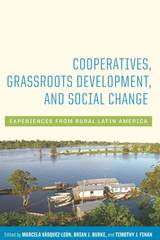 Cooperatives, Grassroots Development, and Social Change: Experiences from Rural Latin America
Edited by Marcela Vásquez-León, Brian J. Burke, and Timothy J. Finan
University of Arizona Press Cooperatives, Grassroots Development, and Social Change presents examples from Paraguay, Brazil, and Colombia, examining what is necessary for smallholder agricultural cooperatives to support holistic community-based development in peasant communities. Reporting on successes and failures of these cooperative efforts, the contributors offer analyses and strategies for supporting collective grassroots interests. Illustrating how poverty and inequality affect rural people, they reveal how cooperative organizations can support grassroots development strategies while negotiating local contexts of inequality amid the broader context of international markets and global competition. The contributors explain the key desirable goals from cooperative efforts among smallholder producers. They are to provide access to more secure livelihoods, expand control over basic resources and commodity chains, improve quality of life in rural areas, support community infrastructure, and offer social spaces wherein small farmers can engage politically in transforming their own communities. The stories in Cooperatives, Grassroots Development, and Social Change reveal immense opportunities and challenges. Although cooperatives have often been framed as alternatives to the global capitalist system, they are neither a panacea nor the hegemonic extension of neoliberal capitalism. Through one of the most thorough cross-country comparisons of cooperatives to date, this volume shows the unfiltered reality of cooperative development in highly stratified societies, with case studies selected specifically because they offer important lessons regarding struggles and strategies for adapting to a changing social, economic, and natural environment. Contributors:
Luis Barros
Brian J. Burke
Charles Cox
Luis Alberto Cuéllar Gómez
Miguel Ricardo Dávila Ladrón de Guevara
Elisa Echagüe
Timothy J. Finan
Andrés González Aguilera
Sonia Carolina López Cerón
Joana Laura Marinho Nogueira
João Nicédio Alves Nogueira
Jessica Piekielek
María Isabel Ramírez Anaya
Rodrigo F. Rentería-Valencia
Lilliana Andrea Ruiz Marín
Marcela Vásquez-León
 Coordinates: Placing Science Fiction and Fantasy
George E Slusser
Southern Illinois University Press, 1983
These thirteen original essays were written specifically for the Third J. Lloyd Eaton Conference on Science Fiction and Fantasy Literature, held February 21–22, 1981, at the University of California, Riverside.
Leslie Fiedler sets the tone of this volume by fixing a basic set of coordinates—that of “elitist” and “popular” standards.
Those replying to his charge are: Eric S. Rabkin, Professor of English at the University of Michigan and author of The Fantasticin Literature, “The Descent of Fantasy”; Gerald Prince, Professor of French at the University of Pennsylvania, “How New is New?”; Mark Rose, Professor of English at the University of California at Santa Barbara, author of Alien Encounters, “Jules Verne: Journey to the Center of Science Fiction”; Joseph Lenz, who teaches English Literature at the University of Michigan, “Manifest Destiny: Science Fiction Epic and Classical Forms”; Michelle Massé, of the English Department at the George Mason University, “‘All you have to do is know what you want’: Individual Expectations in Triton”;Gary K. Wolfe, who teaches English at Roosevelt University, author of The Known and the Unknown, “Autoplastic and Alloplastic Adaptations in Science Fiction: ‘Waldo’ and ‘Desertion’”; Robert Hunt, an editor with Glencoe Press, “Science Fiction for the Age of Inflation: Reading Atlas Shrugged in the 1980s”; George R. Guffey, Professor of English at UCLA, “Fahrenheit 451and the ‘Cubby-Hole Editors’ of Ballantine Books”; H. Bruce Franklin, Professor of English and American Literature at Rutgers University at Newark, “America as Science Fiction: 1939”; Sandra M. Gilbert, Professor of English at the University of California at Davis, and coauthor with Susan Gubar of Madwoman in the Attic, “Rider Haggard’s Heart of Darkness”; the aforementioned Susan Gubar, Professor of English at Indiana University, “She in Her/and: Feminism as Fantasy”; and George R. Slusser, Curator of the Eaton Collection, “Death and the Mirror: Existential Fantasy.”
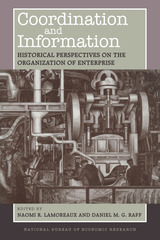 Coordination and Information: Historical Perspectives on the Organization of Enterprise
Edited by Naomi R. Lamoreaux and Daniel M. G. Raff
University of Chicago Press, 1995 Case studies that examine how firms coordinate economic activity in the face of asymmetric information—information not equally available to all parties—are the focus of this volume.
In an ideal world, the market would be the optimal provider of coordination, but in the real world of incomplete information, some activities are better coordinated in other ways. Divided into three parts, this book addresses coordination within firms, at the borders of firms, and outside firms, providing a picture of the overall incidence and logic of economic coordination. The case studies—drawn from the late nineteenth and early twentieth century, when the modern business enterprise was evolving, address such issues as the relationship between coordination mechanisms and production techniques, the logic of coordination in industrial districts, and the consequences of regulation for coordination.
Continuing the work on information and organization presented in the influential Inside the Business Enterprise, this book provides material for business historians and economists who want to study the development of the dissemination of information and the coordination of economic activity within and between firms.
Coordination of Distributed Energy Resources in Microgrids: Optimisation, control, and hardware-in-the-loop validation
Yan Xu
The Institution of Engineering and Technology, 2022 Coordination of Distributed Energy Resources in Microgrids: Optimisation, control, and hardware-in-the-loop validation provides a structured overview of research into techniques for managing microgrids with distributed energy resources (DERs). The DERs including distributed generators, energy storage systems, and flexible loads are posing both challenges and opportunities to microgrids' security, planning, operation, and control. Advanced operation and control techniques are needed to coordinate these components in the microgrids and maintain power quality, as well as keeping the system economically feasible.
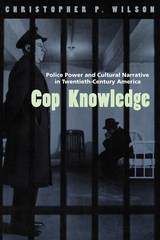 Cop Knowledge: Police Power and Cultural Narrative in Twentieth-Century America
Christopher P. Wilson
University of Chicago Press, 2000 Whether they appear in mystery novels or headline news stories, on prime-time TV or the silver screen, few figures have maintained such an extraordinary hold on the American cultural imagination as modern police officers. Why are we so fascinated with the police and their power? What relation do these pervasive media representations bear to the actual history of modern policing?
Christopher P. Wilson explores these questions by examining narratives of police power in crime news, popular fiction, and film, showing how they both reflect and influence the real strategies of law enforcement on the beat, in the squad room, and in urban politics. He takes us from Theodore Roosevelt's year of reform with the 1890s NYPD to the rise of "community policing," from the classic "police procedural" film The Naked City to the bestselling novels of LAPD veteran Joseph Wambaugh. Wilson concludes by demonstrating the ways in which popular storytelling about police power has been intimately tied to the course of modern liberalism, and to the rising tide of neoconservatism today.
"A thorough, brilliant blend that crosses disciplines."—Choice
"[S]ophisticated, highly theoretical and ambitious. . . . Connects the history of policing to cultural representations of crime, criminals and cops."—Times Literary Supplement
"[A] deeply satisfying approach to the crime narrative. . . . [Wilson] focuses, ultimately, on the role of police power in cultural storytelling."—American Quarterly
 The Copan Sculpture Museum: Ancient Maya Artistry in Stucco and Stone
Barbara W. Fash
Harvard University Press, 2011 The Copan Sculpture Museum in western Honduras features the extraordinary stone carvings of the ancient Maya city known as Copan. The city’s sculptors produced some of the finest and most animated buildings and temples in the Maya area, in addition to stunning monolithic statues and altars. The ruins of Copan were named a UNESCO World Heritage site in 1980, and more than 150,000 national and international tourists visit the ancient city each year.
Opened in 1996, the Copan Sculpture Museum was initiated as an international collaboration to preserve Copan’s original stone monuments. Its exhibits represent the best-known examples of building façades and sculptural achievements from the ancient kingdom of Copan. The creation of this on-site museum involved people from all walks of life: archaeologists, artists, architects, and local craftspeople. Today it fosters cultural understanding and promotes Hondurans’ identity with the past.
In The Copan Sculpture Museum, Barbara Fash—one of the principle creators of the museum—tells the inside story of conceiving, designing, and building a local museum with global significance. Along with numerous illustrations and detailed archaeological context for each exhibit in the museum, the book provides a comprehensive introduction to the history and culture of the ancient Maya and a model for working with local communities to preserve cultural heritage.
Copenhagen Chic: A Locational History of Copenhagen Fashion
Edited by Katrina Sark
Intellect Books, 2023 A comprehensive, multidisciplinary study of Copenhagen fashion.
Copenhagen has long been celebrated for its unique fashion, design, innovation, and sustainability practices, yet there has never been a comprehensive history of Copenhagen fashion and its current innovation and sustainability drive. This book fills that gap, assembling a multidisciplinary roster of contributors to examine all aspects of Copenhagen fashion and culture. Grounded in a broad context of Danish culture, industry, media, technology, sustainability, and innovation practices within the wider cultural and economic fields of fashion, the book helps us understand what makes Copenhagen unique.
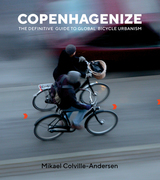 Copenhagenize: The Definitive Guide to Global Bicycle Urbanism
Mikael Colville-Andersen
Island Press, 2018 The bicycle enjoyed a starring role in urban history over a century ago, but now it is back, stronger than ever. It is the single most important tool for improving our cities. Designing around it is the most efficient way to make our cities life-sized—to scale cities for humans. It is time to cement the bicycle firmly in the urban narrative in US and global cities.
Enter urban designer Mikael Colville-Andersen. He has worked for dozens of global cities on bicycle planning, strategy, infrastructure design, and communication. He is known around the world for his colorful personality and enthusiasm for the role of bike in urban design. In Copenhagenize, he shows cities how to effectively and profitably re-establish the bicycle as a respected, accepted, and feasible form of transportation.
Building on his popular blog of the same name, Copenhagenize offers vivid project descriptions, engaging stories, and best practices, alongside beautiful and informative visuals to show how to make the bicycle an easy, preferred part of everyday urban life.
Copenhagenize will serve as inspiration for everyone working to get the bicycle back into our cities. It will give planners and designers the ammunition to push back against the Automobile Age and convince the skeptics of the value of the life-sized city. This is not a guide on how to become Copenhagen, but how to learn from the successes and failures (yes, failures) of Copenhagen and other cities around the world that are striving to become more livable.
We need to act in order to save our cities—and us—from ourselves. Copenhagenize shows the path forward.
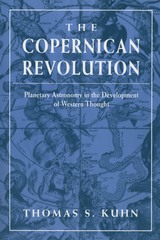 The Copernican Revolution: Planetary Astronomy in the Development of Western Thought
Thomas S. Kuhn
Harvard University Press, 1992 For scientist and layman alike this book provides vivid evidence that the Copernican Revolution has by no means lost its significance today. Few episodes in the development of scientific theory show so clearly how the solution to a highly technical problem can alter our basic thought processes and attitudes. Understanding the processes which underlay the Revolution gives us a perspective, in this scientific age, from which to evaluate our own beliefs more intelligently. With a constant keen awareness of the inseparable mixture of its technical, philosophical, and humanistic elements, Thomas S. Kuhn displays the full scope of the Copernican Revolution as simultaneously an episode in the internal development of astronomy, a critical turning point in the evolution of scientific thought, and a crisis in Western man’s concept of his relation to the universe and to God.
The book begins with a description of the first scientific cosmology developed by the Greeks. Mr. Kuhn thus prepares the way for a continuing analysis of the relation between theory and observation and belief. He describes the many functions—astronomical, scientific, and nonscientific—of the Greek concept of the universe, concentrating especially on the religious implications. He then treats the intellectual, social, and economic developments which nurtured Copernicus’ break with traditional astronomy. Although many of these developments, including scholastic criticism of Aristotle’s theory of motion and the Renaissance revival of Neoplatonism, lie entirely outside of astronomy, they increased the flexibility of the astronomer’s imagination. That new flexibility is apparent in the work of Copernicus, whose De Revolutionibus Orbium Coelestium (On the Revolutions of the Heavenly Spheres) is discussed in detail both for its own significance and as a representative scientific innovation.
With a final analysis of Copernicus’ life work—its reception and its contribution to a new scientific concept of the universe—Mr. Kuhn illuminates both the researches that finally made the heliocentric arrangement work, and the achievements in physics and metaphysics that made the planetary earth an integral part of Newtonian science. These are the developments that once again provided man with a coherent and self-consistent conception of the universe and of his own place in it.
This is a book for any reader interested in the evolution of ideas and, in particular, in the curious interplay of hypothesis and experiment which is the essence of modern science. Says James Bryant Conant in his Foreword: “Professor Kuhn’s handling of the subject merits attention, for…he points the way to the road which must be followed if science is to be assimilated into the culture of our times.”
 Coping with Blindness: Personal Tales of Blindness Rehabilitation
Alvin Roberts
Southern Illinois University Press, 1998
Currently, 1.7 million Americans are either blind or are in the process of losing their vision. Sightless himself and a veteran of four decades of helping people cope with blindness as well as with the possibility of blindness, Alvin Roberts decided that telling stories drawn from the community of the blind and from his fellow rehabilitation workers was the best way to reassure others—especially the elderly, who are most at risk of becoming visually impaired—that "blindness need not be the end of active life, but rather the beginning of a life in which [people] will depend on their residual senses to continue full, active living."
Through good stories well told, then, Roberts offers reassurance that competent help exists for the visually impaired. He chooses stories that demonstrate to those facing blindness that they, too, can learn to cope because others have done so. Yet that is only part of his message. Seeing humor as a great facilitator for successfully reentering mainstream society, Roberts also dispels the commonly held belief that blind people are a somber lot and that those who help them encounter little humor. Many of these stories are frankly funny, and blind people and those in the rehabilitation field certainly are not above practical jokes.
Roberts’s personal experiences and conversations with colleagues have provided a wealth of incidents on which to base stories of rehabilitation workers with the blind going about their daily tasks. He paints a positive picture of what it is like to be blind, replacing fear, dread, and myth with reality.
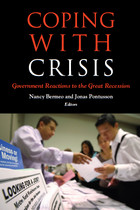 Coping with Crisis: Government Reactions to the Great Recession
Nancy Bermeo
Russell Sage Foundation, 2013 The financial crisis that erupted on Wall Street in 2008 quickly cascaded throughout much of the advanced industrial world. Facing the specter of another Great Depression, policymakers across the globe responded in sharply different ways to avert an economic collapse. Why did the response to the crisis—and its impact on individual countries—vary so greatly among interdependent economies? How did political factors like public opinion and domestic interest groups shape policymaking in this moment of economic distress? Coping with Crisis offers a rigorous analysis of the choices societies made as a devastating global economic crisis unfolded. With an ambitiously broad range of inquiry, Coping with Crisis examines the interaction between international and domestic politics to shed new light on the inner workings of democratic politics. The volume opens with an engaging overview of the global crisis and the role played by international bodies like the G-20 and the WTO. In his survey of international initiatives in response to the recession, Eric Helleiner emphasizes the limits of multilateral crisis management, finding that domestic pressures were more important in reorienting fiscal policy. He also argues that unilateral decisions by national governments to hold large dollar reserves played the key role in preventing a dollar crisis, which would have considerably worsened the downturn. David R. Cameron discusses the fiscal responses of the European Union and its member states. He suggests that a profound coordination problem involving fiscal and economic policy impeded the E.U.'s ability to respond in a timely and effective manner. The volume also features several case studies and country comparisons. Nolan McCarty assesses the performance of the American political system during the crisis. He argues that the downturn did little to dampen elite polarization in the U.S.; divisions within the Democratic Party—as well as the influence of the financial sector—narrowed the range of policy options available to fight the crisis. Ben W. Ansell examines how fluctuations in housing prices in 30 developed countries affected the policy preferences of both citizens and political parties. His evidence shows that as housing prices increased, homeowners expressed preferences for both lower taxes and a smaller safety net. As more citizens supplement their day-to-day income with assets like stocks and housing, Ansell's research reveals a potentially significant trend in the formation of public opinion. Five years on, the prospects for a prolonged slump in economic activity remain high, and the policy choices going forward are contentious. But the policy changes made between 2007 and 2010 will likely constrain any new initiatives in the future. Coping with Crisis offers unmatched analysis of the decisions made in the developed world during this critical period. It is an essential read for scholars of comparative politics and anyone interested in a comprehensive account of the new international politics of austerity.
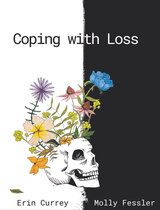 Coping with Loss: A Guide to Death, Grief and Clinical Experiences with Dying Patients
Erin Currey
Michigan Publishing, 2025 In a cure-focused profession, the death of a patient can often feel like a failure. Yet, every patient will inevitably transition from health to illness, independence to dependence, and life to death. These transitions often mark some of the most meaningful interactions between patients and care providers. Coping with Loss is a self-directed workbook that provides addresses common questions, concerns, and emotional responses to these interactions with dying patients. Each lesson opens with real stories of professional grief that will resonate with healthcare professionals at multiple stages of their careers. Critical topics covered include recognizing the diverse presentations of grief, identifying dying patients, decompressing individually, and debriefing as a team. Significant portions of the text discuss how challenging patient cases impact the formation of professional identity. Ultimately, this workbook provides a place for healthcare providers to reflect on their patient interactions and learn how to support themselves and their healthcare teams through grief.
Coping With Poverty: Pentecostals and Christian Base Communities in Brazil
Cecilia Mariz
Temple University Press, 1994 Only by understanding the enduring poverty of Brazil can one hope to understand the recent growth of Protestant evangelical churches there, Cecília Loreto Mariz contends. Her study investigates how religious groups support individualism and encourage the poor to organize. Groups with shared values are then able to develop strategies to cope with poverty and, ultimately, to transform the social structure. Interviews with members and leaders of religious groups, accounts of meetings, and close readings of religious literature contribute to a realistic account of Christian base communities and Assembly of God churches, folk Catholic tradition, and Afro Brazilian Spiritism.
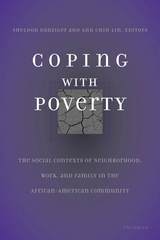 Coping With Poverty: The Social Contexts of Neighborhood, Work, and Family in the African-American Community
Sheldon Danziger and Ann Chih Lin, Editors
University of Michigan Press, 2000 Conservatives often condemn the poor, particularly African-Americans, for having children out of wedlock, joblessness, dropping out of school, or tolerating crime. Liberals counter that, with more economic opportunity, the poor differ little from the nonpoor in these areas. In answer to both, Coping with Poverty points to the survival strategies of the poor and their multiple roles as parents, neighbors, relatives, and workers. Their attempts to balance multiple obligations occur within a context of limited information, social support, and resources. Their decisions may not always be the wisest, but they "make sense" in context.
Contributors use qualitative research methods to explore the influence of community, workplace, and family upon strategies for dealing with poverty. Promising young scholars delve into poor black inner-city neighborhoods and suburbs and middle-income black urban communities, exploring experiences at all stages of life, including high-school students, young parents, employed older men, and unemployed mothers. Two chapters discuss the role of qualitative research in poverty studies, specifically examining how this research can be used to improve policymaking.
The volume's contribution is in the diversity of experiences it highlights and in how the general themes it illustrates are similar across different age/gender groups. The book also suggests an approach to policymaking that seeks to incorporate the experiences and the needs of the poor themselves, in the hope of creating more successful and more relevant poverty policy. It is especially useful for undergraduate and graduate courses in sociology, public policy, urban studies, and African-American Studies, as its scope makes it THE basic reader of qualitative studies of poverty.
Sheldon Danziger is Director of the Poverty Research and Tranining Center and Professor of Social Work and Public Policy, University of Michigan. Ann Chih Lin is Assistant Professor of Political Science and Public Policy, University of Michigan.
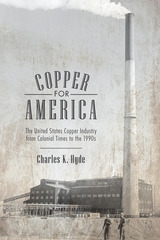 Copper for America: The United States Copper Industry from Colonial Times to the 1990s
Charles K. Hyde
University of Arizona Press, 1998 This comprehensive history of copper mining tells the full story of the industry that produces one of America's most important metals. The first inclusive account of U.S. copper in one volume, Copper for America relates the discovery and development of America's major copper-producing areas—the eastern United States, Tennessee, Michigan, Montana, Arizona, New Mexico, Nevada, Utah, and Alaska—from colonial times to the present. Starting with the predominance of New England and the Middle Atlantic states in the early nineteenth century, Copper for America traces the industry's migration to Michigan in mid-century and to Montana, Arizona, and other western states in the late nineteenth century. The book also examines the U.S. copper industry's decline in the twentieth century, studying the effects of strong competition from foreign copper industries and unforeseen changes in the national and global copper markets.
An extensively documented chronicle of the rise and fall of individual mines, companies, and regions, Copper for America will prove an essential resource for economic and business historians, historians of technology and mining, and western historians.
 Co-production of Knowledge in Action: Emancipatory Strategies for Urban Equality
Edited by Cassidy Johnson, Vanesa Castán Broto, Wilbard Kombe, Catalina Ortiz, Barbara Lipietz, Emmanuel Osuteye, and Caren Levy
University College London, 2025 A postcolonial examination of co-production as an urban development strategy.
In urban development, co-production refers to a strategy that prioritizes collaboration across multiple institutions and with citizens, aiming to enable conflict resolution and transformative change. However, critics contend that these theoretical ambitions often have limited practical impact. Co-production of Knowledge in Action examines how co-production is articulated and deployed in cities such as Lima, Freetown, Kampala, Dar es Salaam, and Delhi. It engages with ongoing experiences of co-production-inspired action, mapping the different aspirations that inform co-production practices and their impacts on urban communities. Critiquing co-production strategies for urban development in relation to practical experiences in these cities, this volume adopts a postcolonial approach to knowledge production as a means to transform urban planning practices.
Cops and Constables: American and British Fictional Policemen
Edited by Earl F. Bargainnier and George N. Dove
University of Wisconsin Press, 1986 In both British and American detective fiction the police detective has emerged as a fictional protagonist. However, the American policemen have not achieved the prominence of their British counterparts. The thirteen essays in this volume indicate some of the principle elements which appear again and again in both British and American police procedurals.
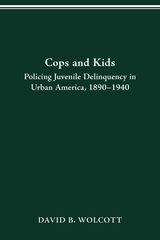 COPS AND KIDS: Policing Juvenile Delinquency in Urban America, 1890–1940
David B. Wolcott
Ohio State University Press, 2005 Juvenile courts were established in the early twentieth century with the ideal of saving young offenders from “delinquency.” Many kids, however, never made it to juvenile court. Their cases were decided by a different agency—the police.
Cops and Kids analyzes how police regulated juvenile behavior in turn-of-the-century America. Focusing on Los Angeles, Chicago, and Detroit, it examines how police saw their mission, how they dealt with public demands, and how they coped daily with kids. Whereas most scholarship in the field of delinquency has focused on progressive-era reformers who created a separate juvenile justice system, David B. Wolcott’s study looks instead at the complicated, sometimes coercive, relationship between police officers and young offenders. Indeed, Wolcott argues, police officers used their authority in a variety of ways to influence boys’ and girls’ behavior. Prior to the creation of juvenile courts, police officers often disciplined kids by warning and releasing them, keeping them out of courts. Establishing separate juvenile courts, however, encouraged the police to cast a wider net, pulling more young offenders into the new system. While some departments embraced “child-friendly” approaches to policing, others clung to rough-and-tumble methods. By the 1920s and 1930s, many police departments developed new strategies that combined progressive initiatives with tougher law enforcement targeted specifically at growing minority populations.
Cops and Kids illuminates conflicts between reformers and police over the practice of juvenile justice and sheds new light on the origins of lasting tensions between America’s police and urban communities.
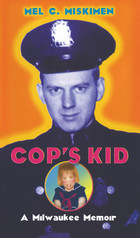 Cop's Kid: A Milwaukee Memoir
Mel C. Miskimen
University of Wisconsin Press, 2003 B-Day, as it came to be known, finally arrived. It was a Friday. A school day. I identified with Cinderella as I watched Dad get ready for work. Holster, check. Gun, check. Billy club, check. Handcuffs, check. . . . Saturday morning I got up early. Dad was already gone. Back to work. Ushering the Beatles out of town. On the table . . . there were two small bars of soap, slightly used, the words "Coach House Inn" still legible. One book of matches with four missing. And a note from Dad, "From their room." . . . No one else’s dad comes home from work with something that might, just might, have been intimate with a Beatle.
Growing up, Mel Miskimen thought that a gun and handcuffs on the kitchen table were as normal as a gallon of milk and a loaf of Mrs. Karl’s bread. Her father, a Milwaukee cop for almost forty years was part Super Hero (He simply held up his hand and three lanes of traffic came to a screeching halt) and part Supreme Being (He could be anywhere at anytime. I never knew when or where he would pop up.) Miskimen’s memoir, told in humorous vignettes, tells what it was like for a girl growing up with a dad who packed a lunch and packed heat.
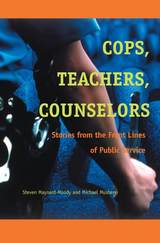 Cops, Teachers, Counselors: Stories from the Front Lines of Public Service
Steven Maynard-Moody and Michael Musheno
University of Michigan Press, 2003
Whether on a patrol beat, in social service offices, or in public school classrooms, street-level workers continually confront rules in relation to their own beliefs about the people they encounter. Cops, Teachers, Counselors is the first major study of street-level bureaucracy to rely on storytelling. Steven Maynard-Moody and Michael Musheno collect the stories told by these workers in order to analyze the ways that they ascribe identities to the people they encounter and use these identities to account for their own decisions and actions. The authors show us how the world of street-level work is defined by the competing tensions of law abidance and cultural abidance in a unique study that finally allows cops, teachers, and counselors to voice their own views of their work.
Steven Maynard-Moody is Director of the Policy Research Institute and Professor of Public Administration at the University of Kansas.
Michael Musheno is Professor of Justice and Policy Studies at Lycoming College and Professor Emeritus of Justice Studies, Arizona State University.
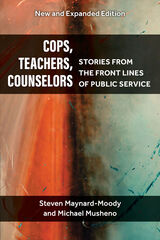 Cops, Teachers, Counselors: Stories from the Front Lines of Public Service
Steven Maynard-Moody and Michael Musheno
University of Michigan Press, 2022 The new edition of Cops, Teachers, Counselors furthers the exploration of forces that shape the contours of frontline work. This line of inquiry is at the heart of street-level bureaucracy research, a field of study cutting across disciplines, including public administration, political science, social work, law and society, education, and criminal justice. The oft-cited 2003 edition pioneered a qualitative method of inquiry using workers’ own voices and storytelling about fairness in the delivery of services. This NSF-supported field research reveals the ways workers engage in moral judgments, more than implementing laws and policies, to account for their decisions and actions.
The new edition wraps an expanded framing around the original chapters, while maintaining a lively, approachable presentation style. It takes on a more enriched perspective of legality than the original, while retaining a focus on frontline work as a powerful source of cultural ordering. In addition to examining workers’ stories of encounters, attention is given to the agency of the governed during interactional moments, the power dynamics in play during both interpersonal and group encounters, and patterns of practice that converge across distinctive service domains. The original edition describes two narratives that shape frontline workers’ decisional judgments and the interplay between legality and morality: the state-agent and citizen-agent narratives. This edition adds the knowledge-agent narrative that stresses the importance of professional and field learning to decisional judgments.
The book examines routine encounters of cops, teachers, and counselors with diverse publics when questions of justice and fairness are at play. This new edition speaks to contemporary issues at a time when frontline workers gained broad recognition for their heroic contributions to communities during the Covid 19 pandemic, as well as sustained condemnation for their embodiment of the brutal expression of racialized state power in police actions. The authors conclude with a focus on the significance of place and trust in building social inclusion on the frontlines of public service.
Copts in Michigan
Eliot Dickinson
Michigan State University Press, 2008 The Copts, or Egyptian Christians, are a relatively small and tight-knit ethno-religious group, numbering perhaps three thousand people and living mostly in the Detroit metropolitan area. Since they began immigrating to Michigan in the mid-1960s, their community has grown exponentially.
Granted exceptional access to the Coptic community, Eliot Dickinson provides the first in- depth profile of this unique and remarkably successful immigrant group. Drawing on personal interviews to infuse the book with warmth and depth. Copts in Michigan offers readers a compelling view into this vibrant community.
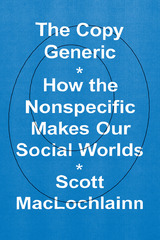 The Copy Generic: How the Nonspecific Makes Our Social Worlds
Scott MacLochlainn
University of Chicago Press, 2022 An illuminating look at the concept of the generic and its role in making meaning in the world.
From off-brand products to elevator music, the “generic” is discarded as the copy, the knockoff, and the old. In The Copy Generic, anthropologist Scott MacLochlainn insists that more than the waste from the culture machine, the generic is a universal social tool, allowing us to move through the world with necessary blueprints, templates, and frames of reference. It is the baseline and background, a category that orders and values different types of specificity yet remains inherently nonspecific in itself. Across arenas as diverse as city planning, social media, ethnonationalism, and religion, the generic points to spaces in which knowledge is both overproduced and desperately lacking. Moving through ethnographic and historical settings in the Philippines, Europe, and the United States, MacLochlainn reveals how the concept of the generic is crucial to understanding how things repeat, circulate, and are classified in the world.
 Copyhold, Equity, and the Common Law
Charles Montgomery Gray
Harvard University Press This book has a threefold purpose: to date and explain the beginning of legal protection of copyholders in courts of law and equity; to reconstruct and explain the first stage in the creation of a body of law relating to copyholds; and to provide a case study in sixteenth-century jurisprudence of a sort that may tend to illuminate larger questions about the judicial process in that period. Mr. Gray has based his book largely on manuscript law reports never before used.
Copyhold, and its ancestor, villein tenure, were originally not protected by the central law courts in England, with the result that the tenant was at the mercy of his lord. There has been considerable uncertainty and dispute as to when this state of affairs was changed. This book argues that the Chancery possibly did not extend protection to tenants until the end of the fifteenth century, and that the common law did not provide protection until the middle of the sixteenth century. Mr. Gray explains why and how the change was effected. Since the extension of common-law protection brought many collateral issues before the courts, the judges had to write a new chapter in the law of property. The authordescribes the perplexities they faced and the changing techniques used to meet them.
This history of a new field of law developed in the Elizabethan period has implications for general questions on the judicial process, such as the use made of precedents, the methods of interpreting statutes, and the character of legal analysis. An introduction provides the Medieval background and explains the technical language and fundamental concepts necessary for understanding the specific studies.
 Copying Machines: Taking Notes for the Automaton
Catherine Liu
University of Minnesota Press, 2000 Explores literary theory’s fear of and fascination with the mechanical. Anxieties about fixing the absolute difference between the human being and the mechanical replica, the automaton, are as old as the first appearance of the machine itself. Exploring these anxieties and the efforts they prompted, this book opens a window on one of the most significant, if subtle, ideological battles waged on behalf of the human against the machine since the Enlightenment—one that continues in the wake of technological and conceptual progress today. A sustained examination of the automaton as early modern machine and as a curious ancestor of the twentieth-century robot, Copying Machines offers extended readings of mechanistic images in the eighteenth century through the prism of twentieth-century commentary. In readings of texts by Lafayette, Molière, Laclos, and La Bruyère—and in a chapter on the eighteenth-century inventor of automatons, Jacques Vaucanson—Catherine Liu provides a fascinating account of ways in which the automaton and the preindustrial machine haunt the imagination of ancien régime France and structure key moments of the canonical literature and criticism of the period.
|
|


